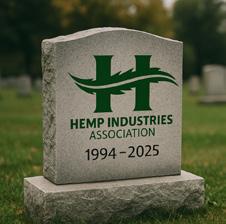

Requiem for a hemp association

CBD NOW
It promised health and wealth—then nearly wrecked the hemp industry. But the molecule isn’t done yet.
Who’s still standing
Public companies struggle but hold on Europe out front
UK’s $2 billion market advancing


Meloni’s War
Italy’s unjust crackdown on flowers
The latest research
CBD for autism and epilepsy


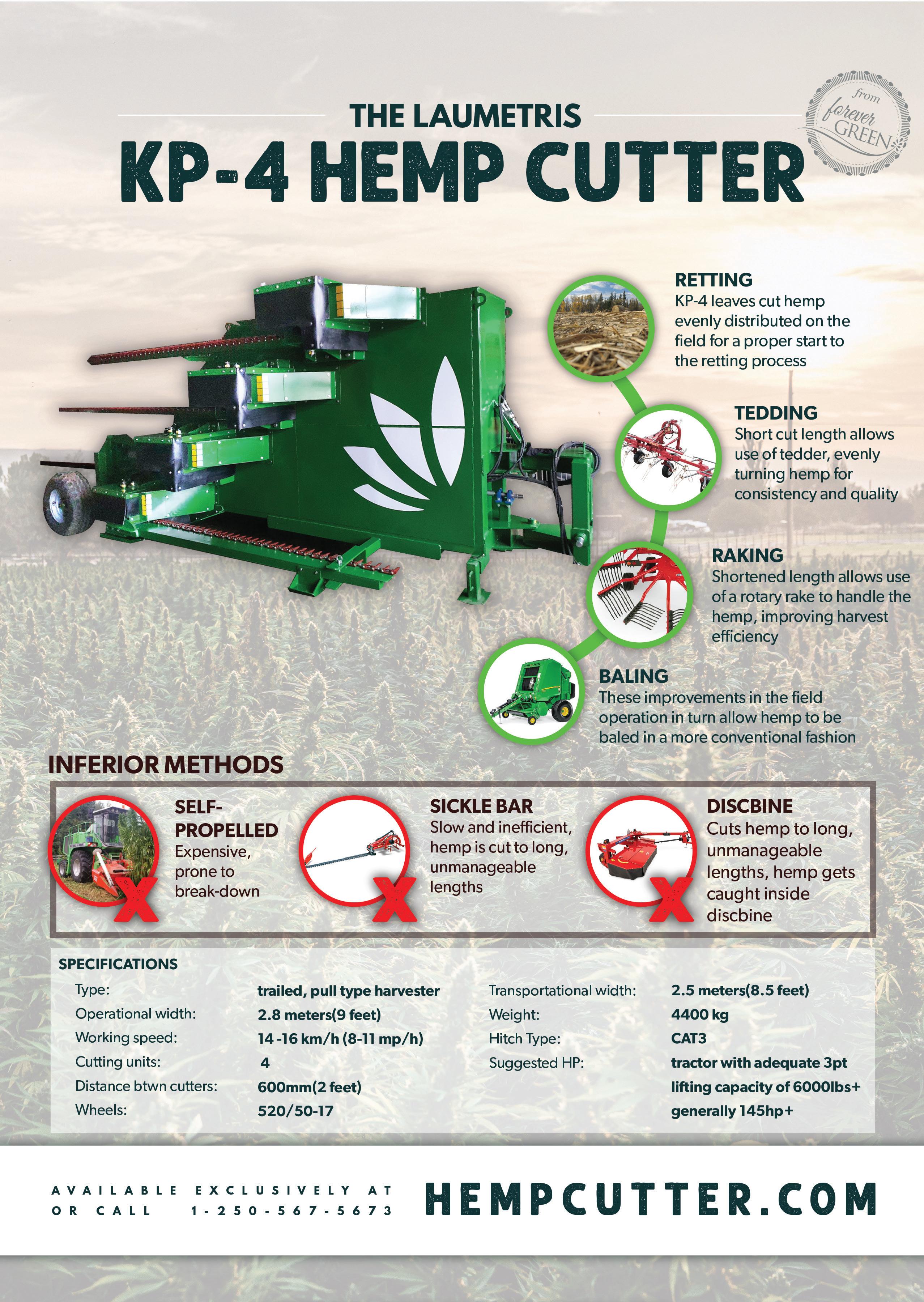
Kehrt Reyher
Editor & Publisher [Europe]
Steve Allin
Carringer Business
Reyher
SENIOR ADVISORS
International Hemp Building Association
Richard Rose
The Hemp Nut Consultancy; CannaCoach, USA
Boaz Wachtel
Roots Sustainable Agricultural Technologies Ltd., Israel
Boris Baňas
CBDepot Czech Republic
Wolf Jordan †
Wolf Jordan & Co. Belgium
NORTH AMERICA
Daniel Kruse SYNBIOTIC SE Germany
Hana Gabrielová Hempoint Czech Republic
Sanford Stein Cannabis Law LLC USA
Tony Budden Hemporium South Africa
Rachele Invernizzi SouthHemp Italy
GLOBAL ADVISORS
Robert Clayton Fi Bear, Inc. Florida, USA
Carl Martel
ABBRI Canada
Robert Ziner
Advanced Bio-Material Technologies Toronto, Canada
Mike Leago iHEMPx Colorado, USA
Pamela Bosch
Highland Hemp House Washington, USA
Paul J. von Hartmann California Cannabis Ministry USA
Joel T. Bedard
Ashnan Resource Management Vermont, USA
Caren Kershner
EUROPE
Sergiy Kovalenkov Hempire Ukraine
Rafael Dulon Hanf Farm GmbH Germany
Monika Brümmer Cannabric/CANNATEKTUM Spain/Morocco
Marcin Krzyzkowiak CannArch Poland
Marijn Roersch van der Hoogte MR Hemp, Germany
Debora Paulino
Obelisk Farm Portugal/Latvia
Nando Knodel CarbonConnect Germany
Heinrich Wieker
HHH Hemp Harvesting Technology Germany
Herbal Extraction Resource Specialists Colorado, USA ASIA
LATIN AMERICA
Diego Bertone
Hemptech Argentina
Lorenzo Rolim da Silva
Latin-American Industrial Hemp Association Brazil
Karen Viviana
Castaño Coronado
Latin-American Industrial Hemp Association Colombia







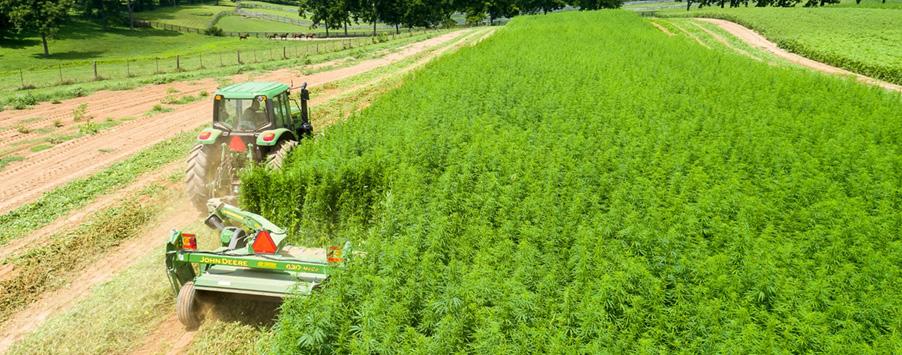

Dhiraj & Nivedita Shah Shah Hemp Inno-Ventures Nepal
Riki Hiroi Each Japan, Inc. Japan
Yosuke Koga Prossimo Japan
Harumi Kikuchi
Hokkaido Industrial Hemp Assn. Japan
Muhammed A Quayyum Fytocina Spain/Pakistan
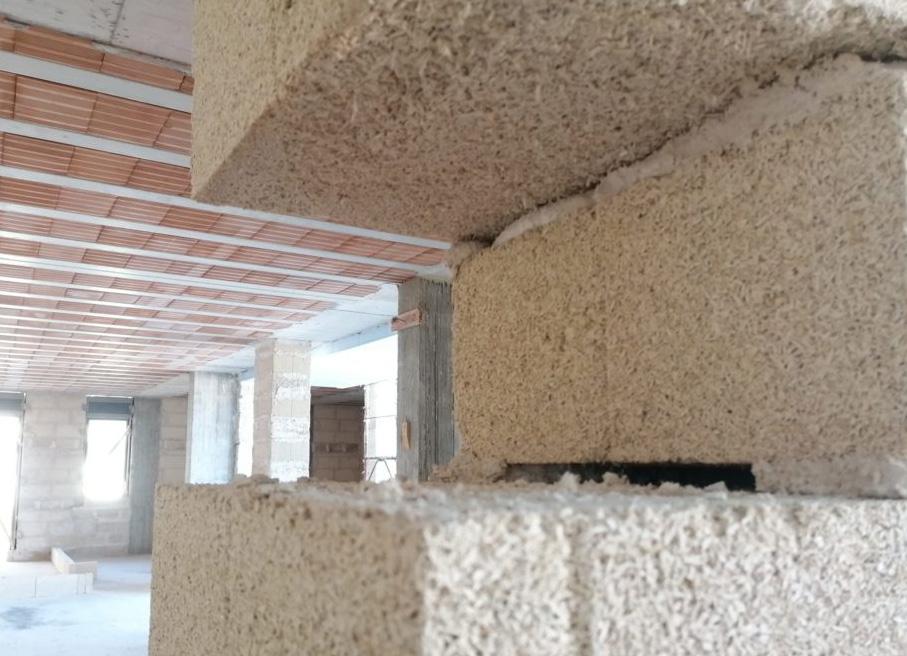


Driving Sustainable Growth and Innovation Across the Value Chain
High-Growth Markets. Untapped Potential: Building the future of the European cannabis industry.
Pioneering the MedCan Landscape:
Expanding access through alternative dosage forms.
ADVERTISING 03
Tripling Revenue. Turning Profit: Scaling fast, building a business that lasts.
SYNBIOTIC SE, Germany ID SBX | ISIN DE000A3E5A59
Contact us at IR@synbiotic.com for exclusive investor opportunities.
Profitable by 2025: Revenues over €45M by 2027. Sustainable growth built on efficiency and vision.
Hemp dreams, hard truths
Why I’m giving up my noble venture into the CBD business
By Steve Groff
Like many other farmers, I saw dollars dancing in my head when industrial hemp was legalized here in Pennsylvania on December 20, 2018. I had been preparing for that day since 1999, when I was first introduced to the idea and value of growing industrial hemp. Then, in 2016, a friend of a friend from Colorado stopped in at my farm and told me that once hemp is legalized, he wanted me to grow CBD hemp for him. Inquisitively, I asked, “What is CBD hemp?”, as I had never heard of it. He explained about CBD and the dozens of other cannabinoids that cannabis plants produce. I was intrigued and immediately took a crash course to learn about the numerous medical benefits this cannabinoid has to offer. Hemp was then legalized, and I immediately began my roller coaster journey into the CBD hemp business!
Life changing profits?
Rumors were rampant about the potential life-changing profits. I did the math and projections many times over, and even the worst-case scenario would be profitable. I had three CBD hemp contracts with processors worth over $2 million. I was going to be able to pay off debt and have fun growing a new industry! But, as most of you can probably guess, not one penny of those contracts was honored.
Then we heard of clever social media experts who found workarounds to reach the masses with our message, even though we were selling CBD products. After spending thousands of dollars on these self-proclaimed social media gurus, we still hadn’t cracked the code for strong online sales. We were eventually able to garner a small but loyal group of customers; however, this did not generate enough profits to recoup past investments. Operating in the red is not fun, especially when you don’t see a light at the end of the tunnel. Our partners had to take other jobs as our CBD business did not generate enough revenue to support our financial needs. In 2024, we put our CBD business up for sale.
Over several months, we received a few serious inquiries that progressed to the point of inking a deal, but ultimately, they pulled back, stating that a small CBD business is too risky as a profitable entity. Currently, there are very few small CBD businesses that are still operational.

I had always expected to launch my own CBD brand, having successfully launched other brands over the years. However, the plan was expedited when I realized I’d have to take the bull by the horns and embrace the process of extraction, manufacturing, branding, and marketing the finished product, as I did not have a home for the 60,000 lbs. of CBD biomass I’d grown.
A compelling story
We collaborated with friends to form a partnership and establish our brand, Cedar Meadow Farm. Our plan was to leverage our experience and sell our products online since our product was high value and shipping costs were negligible. In addition, we assumed our presence on social media would be a low-cost and effective way to educate potential customers and subsequently make sales. We also had a very compelling story of how our CBD was grown in healthy soil using regenerative agriculture principles. In addition, we were family-based with our product being grown, processed, and shipped locally.
The theory was noble, but what we did not anticipate was the crackdown that social media imposed on items for sale that are not FDA-approved, such as CBD products. Not only that but mentioning the word “hemp” in any part of a social media post or landing page would relegate us to being shut down and treated like an unlawful drug dealer. And that happened four times! Apparently, most social media platforms considered hemp to still be a category one drug.
Dark foreshadowings
As I reflect on the past six years, there are a few aspects that foreshadowed a doomed effort like this. First of all, I acknowledge that I did not conduct thorough research to determine how many bottles of CBD oil can be produced from one plant. Simple math would have indicated that the expected planting of tens of thousands of acres of CBD hemp in 2019 would have made many times over what the actual demand was estimated to be.
Secondly, it should have been required to conduct random third-party testing on the finished product. There have been several instances where there was not one milligram of CBD in a bottle that was branded as containing CBD. This has hurt the industry’s integrity, as some customers have rightly noted they did not experience any benefits from using the product. Thirdly, and this is also due to a lack of regulation, it should never have been allowed to sell CBD products in gas stations. It devalues the medicinal value CBD has to offer. It also tends to be a cheaply made option, which makes it challenging to compete on price for smaller, high-quality brands.
Good luck
In light of all this, I am getting out of the CBD business and am now focused on industrial hemp. Yes, there are similarities to CBD hemp in that it’s a nascent industry. However, it does not have a “get rich quick” vibe, which will set the foundation for developing a healthier industry.
I commend the few remaining small-scale CBD businesses that have managed to survive and wish them all the best as they navigate the challenges ahead.
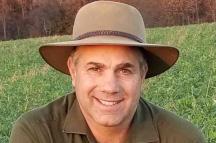
Steve Groff is the owner of Pennsylvania-based Cedar Meadow Farm, and the author of The Future-Proof Farm: Changing Mindsets in a Changing World
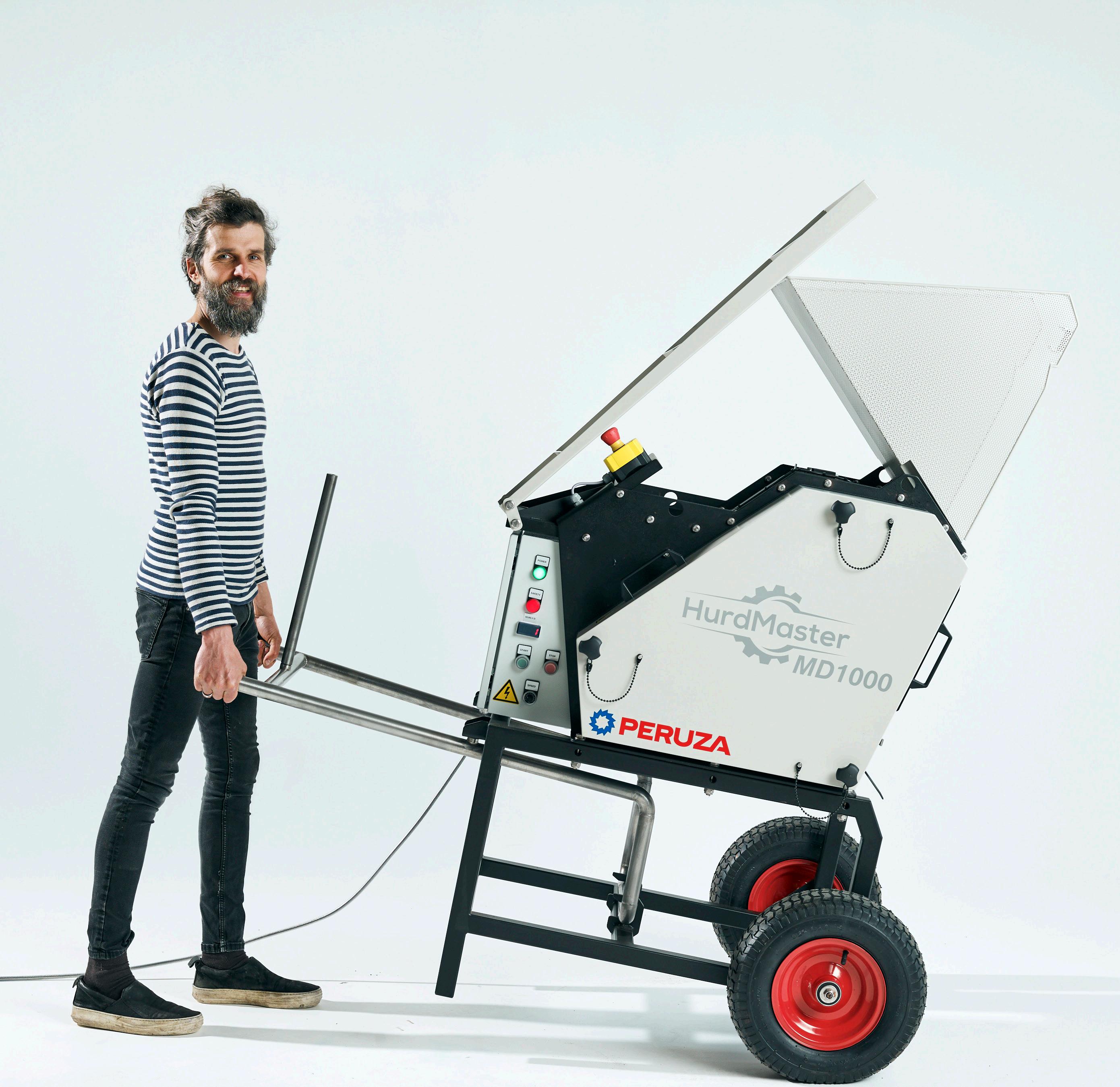
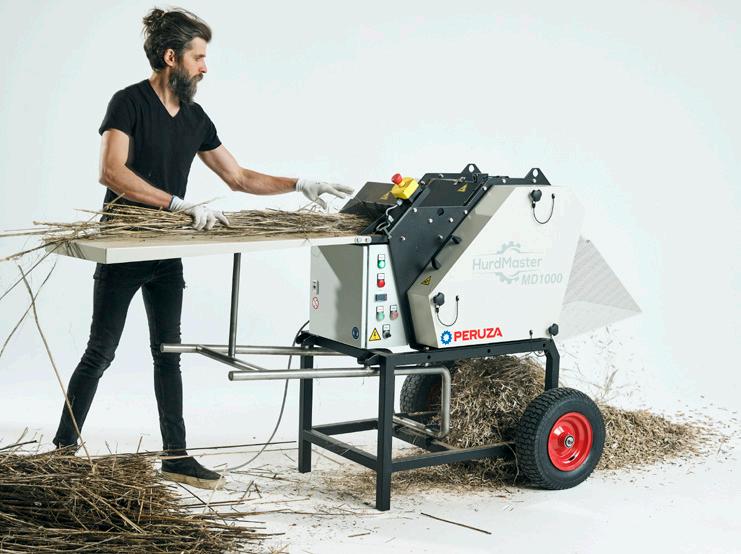

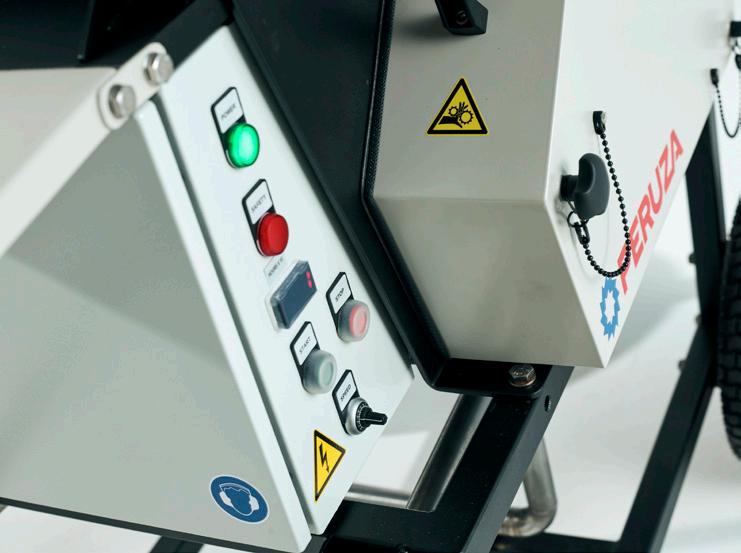

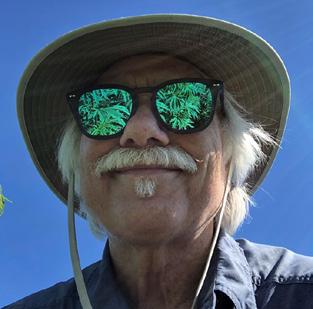
RICHARD ROSE
Does hemp’s right hand know what its left is doing?
For years social media platforms shadow-ban our posts, and sometimes outright ban us altogether. But so does “our” side. With everyone in their own little siloes, hemp’s right hand doesn’t know what the left is doing, and rarely even acknowledges its existence. With a 95% drop in U.S. acres over five years, there appears to be no imperative for success, too much grant and institutional money at play. Despite grain for food being hemp’s best chance for global success, rivaling the soybean industry, my articles on it are often met with surprise even among hemp fans.
Biggest obstacle
Since the beginning, the “hemp = fiber” mindset has long been the food side’s obstacle among hempsters. For instance, it would be natural for the hemp building industry to incorporate more lifestyle considerations in their movement, after all, don’t their hemp houses have kitchens? And many hemp associations are so focused on the easier aspect, fiber, to the exclusion of grain despite the symbiosis of the two.
Building walls is nice but feeding people is a noble calling, and people eat daily. Despite not even being fully legal yet, hemp grain for fodder gets way more attention from the Universities with hemp programs than the one segment long with the most consumers, retailers, sales and profits: grain for food. The irony is compounded by the fact that including hemp grain for food in their programs would allow them to expand to include other post-ag harvest school departments, such as nutrition, food process engineering and operations, food product R&D, marketing and communications, package design, etc. Consumer packaged foods, medical foods, industrial food ingredients... the market is huge and needing replenishment daily, yet ignored. The new medical and nutritional discoveries in the seed monthly, the potential for hemp grain as a legitimate food ingredient is vast, rivalling soya.
Petty fears
While the hemp industry pre-2018 Farm Bill was built on cooperation, the post-legalization hemp industry is being destroyed by ignorance and petty fears of competition. Has any media, university, expo speaker, or association told you that USDA has been publishing the prices of hempseed foods every Friday for years, with a link so you could read them yourself? Didn’t think so.
Yes, hemp grain for food is just that big, yet is mostly supplied by companies in China and Canada. “Made In USA” hemp grain could easily take that market share, giving the retailer a red, white and blue halo that can build on the hemp seed’s huge success story keeping the industry alive in the dark years a generation ago. It’s also the easiest way for a visionary company to “get into hemp,” or for an entrepreneur to start; no farm, factory or finances needed.
Millions of consumers, thousands of retailers, fat margins, global sales, near 100% addressable market renewed daily. . . .yet only crickets from those who demand the right to educate us. No wonder acres are down 95% while they pat themselves on the back.
Nice threads, Emperor.
The author writes and produces The Richard Rose Report

BUILDING


3 - 5 October 2025
Lower Sioux Indian Community Morton, Minnesota, US


BRAD TRUMAN
Honest numbers can help reshape hemp’s public image
Transparency and honesty are essential values in any business, but they are particularly critical in the hemp industry. Hemp continues to struggle with outdated misconceptions due to its association with cannabis. This persistent image problem demands that hemp stakeholders commit to higher standards in data collection, business practices, and communication with consumers and regulators.
Accurate, well-presented data is central to this effort. To build credibility and trust, the hemp sector needs a strong foundation of facts that clearly define its size, scope, and potential. Reliable data allows stakeholders to understand their position in the supply chain, identify trends, and make informed decisions. It also helps attract investment, guide public policy, and strengthen consumer confidence.
Not there yet
Developing meaningful data begins by understanding the audience that will use it. In hemp, this includes farmers, processors, investors, regulators, and consumers. Each group needs different kinds of information, but all rely on fundamental industry truths. For mature industries, dependable sources of performance metrics have evolved over time. Hemp is not there yet. What it needs now is clear, accurate information in a concise format that is both accessible and actionable.
A logical starting point includes gathering statistics on imports and exports, acreage planted and harvested, and the number of active companies in various sub-industries. Understanding the location and capacity of processing facilities is also vital. These basic facts would create a clearer picture of the supply chain and support data-driven decisions across the industry.
One major challenge is the lack of consistent and dependable data. While organizations such as the USDA have some authority and recognition, their hemp-specific data remains incomplete. Encouraging consistent participation in surveys and data-sharing initiatives is critical. If companies and producers respond honestly and regularly, the resulting information would benefit the entire sector—particularly in the U.S.
Long-term payoff
Building a reliable data infrastructure will require time, effort, and collaboration. Farmers, processors, industry groups, and government agencies must work together to create accurate reporting systems. The long-term payoff is substantial. Better data will help position hemp as a transparent, trustworthy, and forward-looking industry with strong economic and environmental contributions.
Data also dispels myths and enables the industry to measure progress and establish benchmarks. It fosters accountability and promotes best practices. In a world where information is power, the hemp industry must be able to clearly show what it does, how it does it, and why it matters.
Ultimately, transparency and reliable data are about more than just statistics. They shape the public narrative of hemp as a legitimate part of agriculture and manufacturing. By committing to honest, cooperative data collection, the hemp sector can overcome stigma, boost credibility, and unlock its full potential.
The author is a research analyst at U.S.-based Canna Markets Group

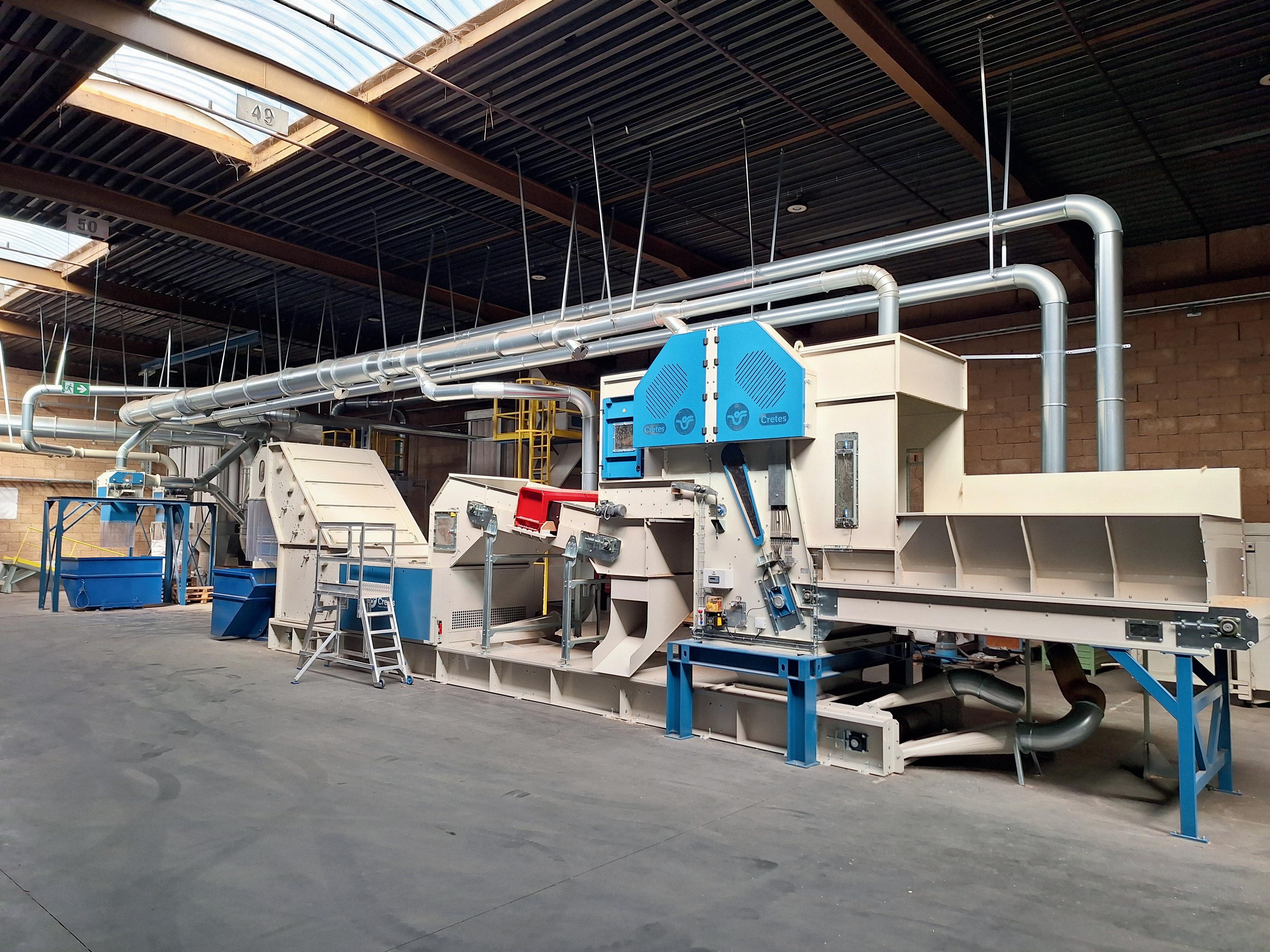

High-Throughput Fibre Decortication Line Fully Operational at CTC
The Cretes Technology Centre (CTC) has launched its upgraded fiber cleaning line, now fully operational and ready for demonstration. Designed for both hemp and flax, the system delivers higher throughput, less downtime, and greater reliability—offering stakeholders a real-world view of advanced fiber processing in action.
Integrated Design for Efficiency and Quality
The decortication line has been redesigned for higher throughput and now includes a new fiber cleaning stage, creating an end-to-end process from raw stalks to cleaned fibers. The system removes nearly all core content—achieving fiber purity below 1% and resulting in finer fibers. The line is built for easy maintenance and modular adjustments, allowing efficient runs across various input materials.
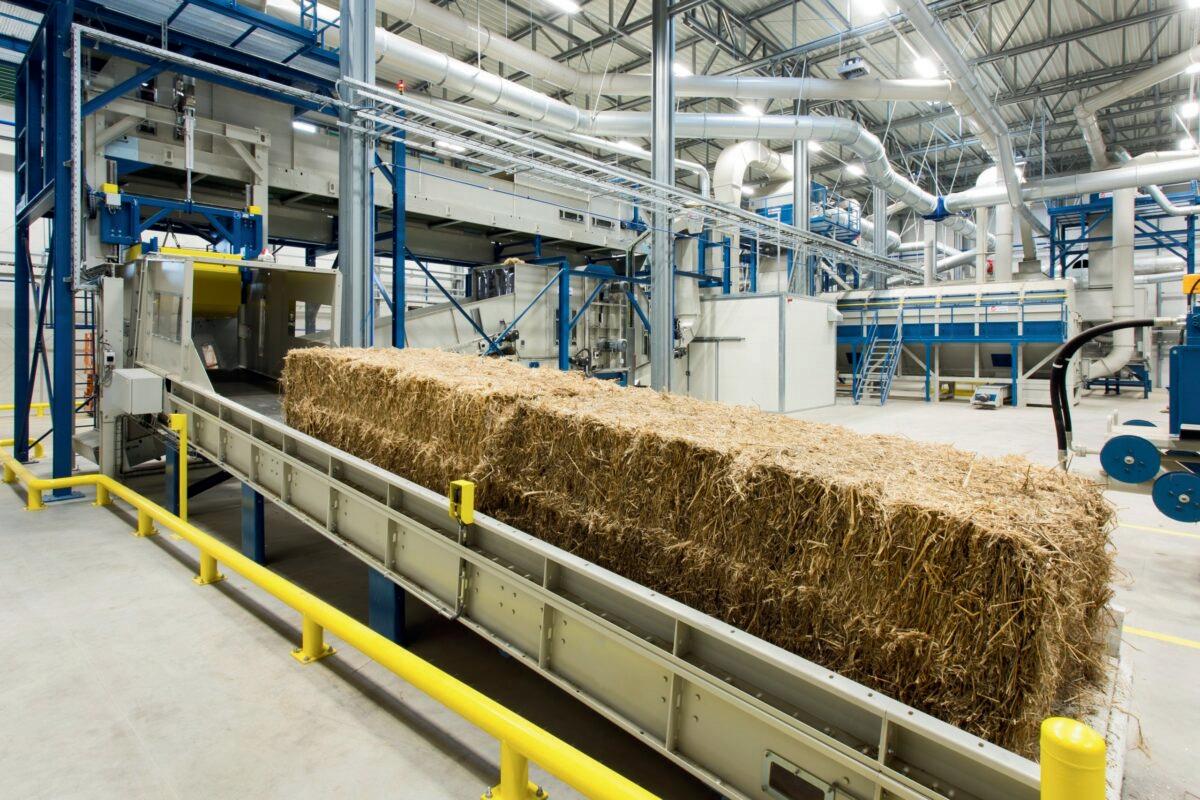
Versatile Testing and Development Platform
More than a showcase, the CTC serves as a handson development hub for fiber processing. Manufacturers and researchers can run tests with various hemp and flax inputs, optimize settings, and evaluate performance under real-world conditions. The facility supports industrial-sized trials, process refinement, and ongoing technology development in close collaboration with Cretes engineers.
Interested in seeing the new fiber cleaning line in action?
Demonstrations are now being scheduled at the CTC. Interested parties can book a demo via info@cretes.be.
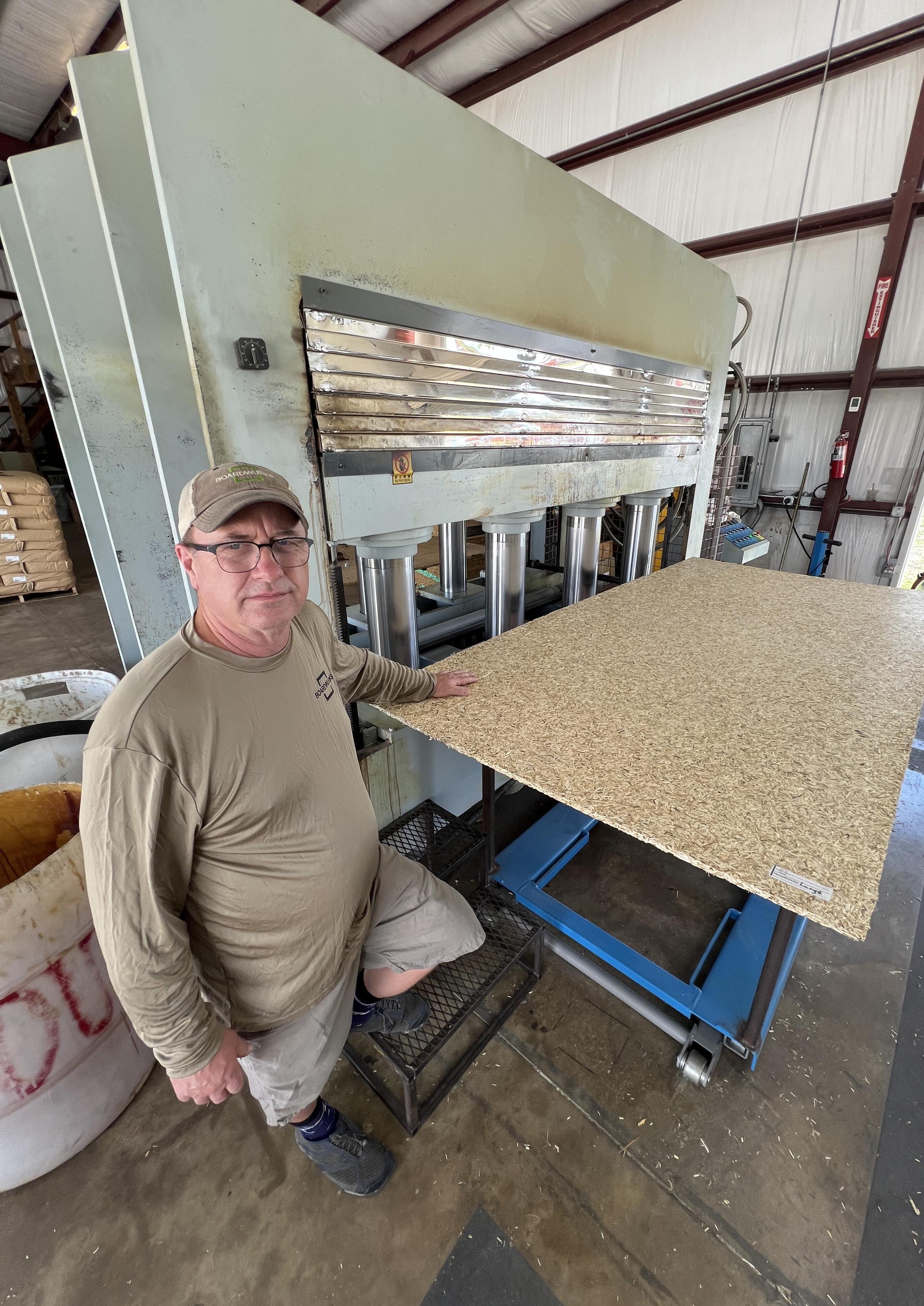
“The hemp industry is still maturing, and the biggest gaps right now are in processing and fiber quality.”
Miles Gathright CO-FOUNDER, BOARDWURKS
Fiber forward
Regional sourcing and next-gen composites drive Boardwurks’ growth strategy
MILES GATHRIGHT is co-founder of Boardwurks Biocomposites, a Florida-based innovator developing carbon-smart construction panels made from hemp hurd and recycled composites. With more than two decades in the performance composites industry, Gathright brings deep technical expertise and a sustainability-first mindset to the challenge of replacing conventional materials with natural, circular alternatives.
HempToday: Boardwurks is clearly rooted in sustainability. What problem were you trying to solve when you started the company?
Miles Gathright: Boardwurks was founded to address a critical gap in sustainable construction materials. Traditional composites and building panels are heavily reliant on fossil fuels and toxic adhesives, contributing significantly to carbon emissions and landfill waste. We saw an opportunity to turn waste into value by upcycling decommissioned wind turbine blades, derelict fiberglass from marine vessels, and agricultural byproducts like bagasse and corn stover. We also focused on purpose-grown sustainable crops like hemp, kenaf, and miscanthus, which not only sequester carbon but thrive with low environmental impact. Our mission is to transform these waste streams and sustainable fibers into high-performance, carbonsmart construction materials that challenge conventional particleboard and MDF in both durability and sustainability.
HT: You’ve worked in composites for more than 20 years. How did hemp enter the picture?
MG: Hemp entered the picture as part of our commitment to finding sustainable and renewable feedstocks that perform. Its exceptional strength, rapid growth cycle, and ability to sequester carbon made it an ideal material for our composite panels. When we looked at decarbonizing our footprint without sacrificing performance, hemp stood out as a perfect solution. Integrating hemp hurd into our thermocompression process allowed us to produce panels that are stronger, lighter, and far more sustainable than conventional alternatives.
HT: The hemp sector often struggles with quality and supply consistency. How are you managing those challenges?
MG: We’ve tackled this head-on by establishing long-term partnerships with decorticators and farmers. Our supply agree-
ments prioritize quality control and sustainable farming practices. We also diversify our sourcing with a regional strategy: partnering with processors in areas where hemp production is stable and growing. This layered approach ensures we maintain consistent quality and supply, even during market fluctuations.
HT: From a sustainability perspective, how does Hempboard compare to traditional particleboard or MDF?
MG: Hempboard sets a new standard for sustainable construction. Unlike traditional particleboard or MDF, which rely on formaldehyde-based adhesives and fossil-fuel-derived resins, Hempboard is made with natural fibers and eco-friendly binders. It’s formaldehyde-free, water-resistant, and stronger per weight. Additionally, the hemp we use sequesters significant amounts of carbon during its growth, making Hempboard not just carbonneutral, but carbon-negative. It’s a solution that’s better for the environment without compromising on performance.
HT: Do you see the future of biocomposites as competing with conventional materials—or displacing them entirely?
MG: We see biocomposites as more than just competition—they’re the future of sustainable building. As demand for low-carbon materials grows, traditional particleboard and MDF are losing ground. With advancements in processing and supply chain efficiency, biocomposites like Hempboard and our DerelictBOARD made from reclaimed FRP are poised to replace these conventional materials outright. We’re committed to driving that shift through innovation and scalability.
HT: What kinds of buyers or industries are showing the most interest in your materials right now?
MG: Currently, we’re seeing strong demand from non-structural applications where sustainability is a core priority. Right now, the primary hurdle is certification for
structural applications under International Building Code (IBC) and International Residential Code (IRC). Pursuing these certifications is a top priority for Boardwurks, and we are collaborating with academic partners to expedite testing and validation. Achieving IBC and IRC approval is essential for broader market adoption, including bigbox retailers and structural insulated panel (SIP) manufacturers. This effort is significant, not just for us but for the entire biocomposite industry.
HT: How important is regional fiber supply to the Boardwurks model—and how do you view the growth of U.S. hemp processing?
MG: Regional fiber supply is fundamental to our model. Our “75-Bale Mile Radius” strategy means positioning microplants adjacent to first-transformation decorticators or waste stream processors to minimize transport emissions and processing costs. We’re working with local agricultural waste streams—bagasse in Florida, corn stover in the Midwest— and blending them with higher-value, purpose-grown materials An exciting development we are pioneering is our “super-hybrid” composites, which combine carbon-sequestering natural fibers like hemp with reclaimed FRP from decommissioned wind turbine blades. This innovation is setting a new standard for sustainable, high-performance building materials. We see the growth of U.S. hemp processing as crucial to scaling this model, supporting local economies while reducing carbon footprints.
HT: Finally, what advice would you give to other innovators looking to bring hemp-based products to market?
MG: My advice is to prioritize quality and consistency in your supply chain. The hemp industry is still maturing, and the biggest gaps right now are in processing and fiber quality. Work closely with farmers and processors, build relationships that prioritize sustainable practices, and don’t cut corners on material testing. Also, be prepared to invest in certifications - gaining market acceptance requires meeting stringent standards, and that’s a challenge worth tackling head-on.
Missouri Promise
‘If we can make hemp work for farmers, we’re moving in the right direction’
KEVIN HALDERMAN is President of Carbon Ag Co, a partner in Hemp Hemp Hooray, and a member of the National Hemp Growers Association. His company develops highquality CBD products, collaborates with manufacturers in developing exclusive formulations, and supports wholesale distribution for small retailers. With expertise in hemp advocacy, product development, and the new farming startup, Halderman is committed to growing the industry and increasing market acceptance of hemp-based products.
HempToday: How was last year’s hemp farming season for you in Missouri?
Kevin Halderman: It was a tough year. Weather played a huge role. Missouri had some major storms come through in early June, including a typhoon-like event that dumped about eight inches of rain, wiping out hundreds of acres of hemp and devastating some SE Missouri producers. Followed by extreme drought, some fields never saw rain for up to 60+ days. That’s the reality of farming. You can have everything lined up perfectly, but nature has the final say.
HT: What do you see as the biggest challenge for hemp farmers right now?
KH: Quality grain or fiber materials harvesting still is a major challenge. People say, “hemp grows anywhere,” but that doesn’t mean it’s profitable to harvest. We’ve seen great-looking fields that should have produced thousands of pounds of grain, but once you get to harvest, everything just shatters and ends up on the ground. The right genetics and harvest timing are critical, and our industry is still playing catch-up compared to other crops.
HT: What’s your take on where the CBD market stands today?
KH: The CBD market has changed a lot. Early on, it was a gold rush, but now it’s more about survival. Federal and state regulations are still unclear, and there’s a flood of low-quality products out there, which makes it hard for good businesses to stand out. We’ve focused on highquality formulations, things that work— like our pain salve infused with delta-8 THC and our THCV chocolate bars that help with appetite suppression.
HT: Are you still producing CBD yourself?
KH: Yeah, we work with several extraction facilities in Union, Missouri. We’ve
focused more on specialty cannabinoids like THCV, CBDV and CBG rather than intoxicating hemp products. There’s already plenty of that in the market.
HT: How does biochar fit into your hemp farming?
KH: We’re using biochar in a few ways. First, it’s great for soil health— when properly inoculated, it helps retain nutrients and water. But another key use is in poultry farming. We’re working with a group in Missouri that has approval for using biochar in large-scale poultry barns. It helps absorb ammonia and improves bird health, which in turn reduces mortality rates. That’s real value.
HT: Have you looked into carbon credits for hemp farming?
KH: We’re interested, however, the process within the U.S. is still developing. We should have a new plan in place this year to begin addressing actual carbon sequestration in our hemp fields. Several companies have developed very affordable units that we are considering implementing.
HT: What’s the state of fiber processing in Missouri?
KH: It’s been a struggle. We had four fiber decorticators trying to get up and running over the past few years—Tiger Fiber in St. Louis, Midwest Fiber in Sykeston, and a couple of others. But bad weather, financial challenges, and just the difficulty of scaling fiber processing have made it hard for them to stay in business. We don’t have a local processor, so right now, we’re diverting our fiber biomass into sustainable farming practices. Our company focus will be to bring hemp into traditional Missouri farms through grain production.
HT: Missouri has been involved in
pushing hempseed as animal feed, particularly for poultry. Where do things stand?
KH: Hempseed meal got approved for egg-laying hens last year, but it’s still not approved for meat birds. Our industry is so complex due to state vs federal oversight on regulations. Hemp grain is not recognized as GRAS (Generally Recognized as Safe) by the FDA. We need to have more conversations with our federal representation in government about this issue.
HT: Are you testing egg-layer poultry feed on your farm?
KH: Yes, we’re just getting started. We’ve been working with regenerative agriculture experts to develop a sustainable feed program. We’ll have a couple tests by the end of June to check our own hemp-based feed with poultry from our local hatchery.
HT: You’re working with a hemp variety called HOCOMO. Can you tell us about it?
KH: HOCOMO is a developing tri-crop variety in Southeast Missouri. It’s designed for grain, fiber, and cannabinoids. The fiber yield is great – we’ve seen 6,000 to 8,000 pounds per acre – with very good yield on the grain production. We need to boost the cannabinoid content a bit more. That’s our next focus.
HT: What’s the goal for this variety long term?
KH: If we can get all three components – grain, fiber, and cannabinoids – to commercially viable levels, it will be a game-changer. Most hemp today is grown for just one or two uses, but a true tri-crop variety could make the economics of hemp farming much more attractive.
HT: What’s your biggest goal for this year?
KH: It all comes down to harvesting. If we can get grain in the bin and fiber processed, we’ll be in a good position. The hemp industry still has a lot of challenges, but if we can make hemp work for farmers – whether through grain, or fiber – then we’re moving in the right direction.

on regulations.’
‘Our industry is so complex due to state vs federal oversight on regulations.’
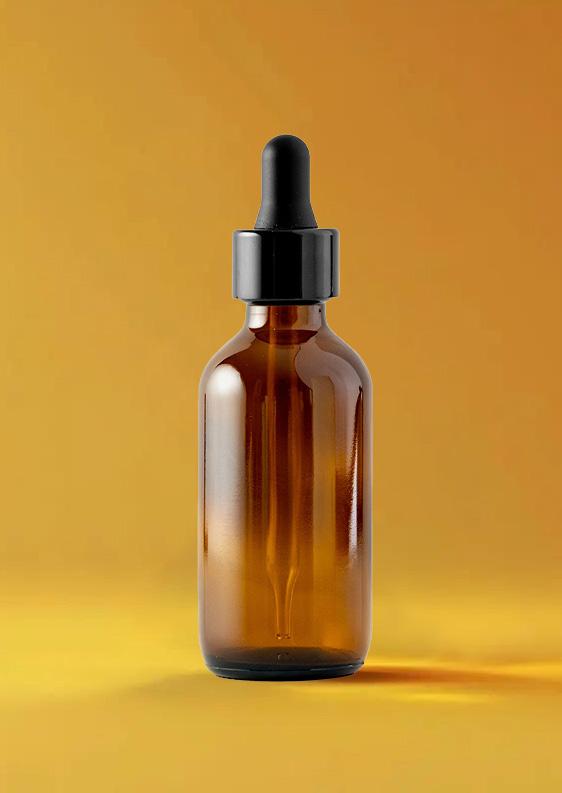
CBD NOW
As hype fades and rules tighten, surviving companies are pivoting toward function, compliance and long-term credibility.
In the United States, Europe and beyond, the the CBD industry, while fragmented and still maturing, is persistently undervalued.
U.S. companies are clawing their way back from a market crash that wiped out most of the early players. Though share prices remain depressed and profitability elusive, several public companies are stabilizing operations, cutting costs, and rethinking product lines. After all, they’ve already been through the worst, having endured oversaturation, regulatory chaos, and the rise of intoxicating hemp compounds.
In Europe, a slower but arguably healthier recalibration is underway, driven by regulatory scrutiny, novel food pathways, and narrowing consumer expectations. Meanwhile, markets in Asia, Africa and Latin America are cautiously liberalizing or refining their frameworks, often with an eye toward export potential.
The portrait that emerges shows CBD at a crossroads—not the miracle molecule once imagined, but not a failed experiment either. CBD companies that survive are doing so by refocusing on quality, compliance, and medical or functional applications rather than trend-chasing. At the same time, policy decisions being made today—from the U.K.’s novel foods approvals to Canada’s potential reclassification—will shape the trajectory of CBD for years to come.
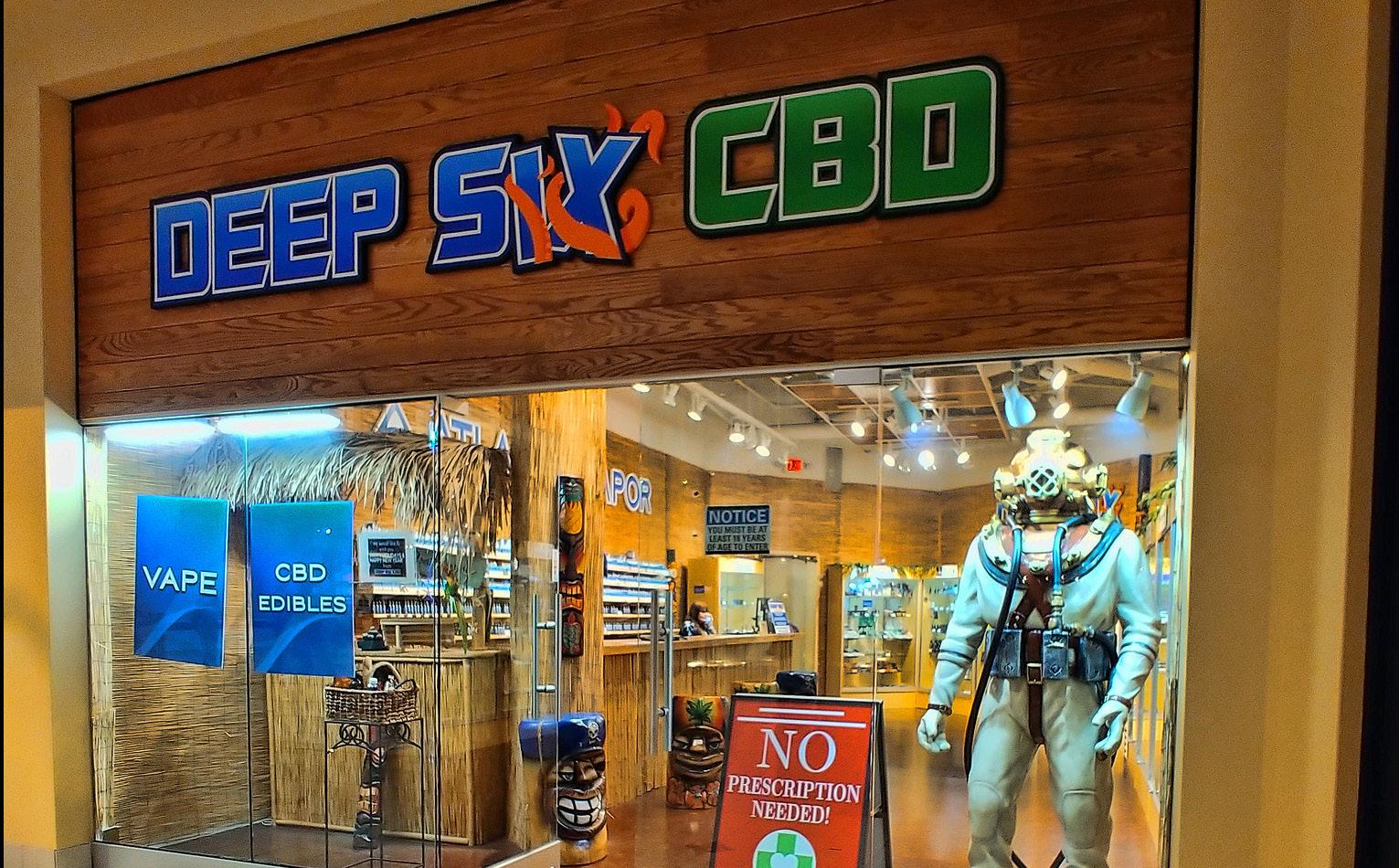
game. A new flavor of the day. There’s no anchor like you have in tobacco or alcohol.”
UNITED STATES: After years of explosive growth and harsh correction, the U.S. CBD market is searching for a second act. As regulations take shape and companies adapt, some see a chance to rebuild consumer trust and reposition CBD in wellness and retail.
The over-the-counter (OTC) cannabidiol (CBD) market in the United States is struggling through a sustained downturn that has left most companies either bankrupt, pivoting, or barely afloat. Once the centerpiece of the post-2018 Farm Bill hemp boom, CBD is now a beleaguered sector weighed down by oversupply, waning consumer novelty, and looming federal regulations that could further restrict or redefine the market.
“It’s 40% of our sales total,” said Kevin Halderman, a Missouri-based retailer and processor. “But there’s some stores you can’t give away CBD right now. I’ve struggled over the last year just to find true CBD cultivars being grown anymore.”
Though hemp has deep roots as a food and fiber crop, the explosion of interest in CBD following the 2018 Farm Bill made
the compound synonymous with hemp itself. Middlemen flooded the space, promising riches to farmers, many of whom were later “burned” when demand collapsed. Initial enthusiasm was buoyed by hyped medical claims, loose regulation, and a brief period of retail proliferation—but it proved unsustainable.
Shock contraction
The contraction came swiftly. By some estimates, up to 90% of CBD-related companies in the U.S. have failed since 2019. Publicly traded survivors such as Charlotte’s Web, CV Sciences, cbdMD, and Elixinol have watched their stock values plummet while continuing to post quarterly losses. Revenue has sagged across the board, and recovery has proven elusive even as some companies attempt restructuring.
“There’s no brand loyalty in this space,” Halderman noted. “It’s a price-point
Stagnation
CV Sciences, which reported Q1 2025 revenue of $3.6 million (down 8% from the prior quarter), acknowledged the stagnant state of the market but emphasized efforts to maintain gross margins, which rose to 46%. “We are pleased with our results,” CEO Joseph Dowling said on a recent earnings call. “We continue to focus on expanding gross margin and improving the balance sheet.”
cbdMD took a similar tone. After years of steep losses, the company reported its first-ever positive net income in early 2025. However, revenue in Q2 ($4.7 million) was down 8% from Q1. CEO Ronan Kennedy remains optimistic: “Profitability is achievable,” he said. “We are proving that a sustainable, thriving business model is within reach.”
Charlotte’s Web, while still unprofitable, has trimmed more than $22 million in operating expenses and expanded its retail reach to 847 Walmart stores and Chewy.com. The company expects its new mushroom-enhanced wellness gummies and pet CBD products to be growth drivers in 2025.
Still, the overall market remains challenging. Elixinol Wellness reported a 10% revenue decline in its U.S. CBD business in 2024, citing ongoing regulatory uncertainty and fierce price competition. The company reported an 80% increase in revenues in 2024, but that was
Retailer Deep Six CBD has closed some stores, but most remain open, primarily in Pennsylvania and South Carolina.
RAYMOND CLARKE IMAGES
Course correction
A reset is underway in the U.S. CBD sector, where once-soaring companies are cutting losses, stabilizing operations, and edging closer to break-even. At publicly traded companies, revenues are down, losses persist, and share prices have collapsed—but signs of discipline and recalibrated investor expectations are beginning to emerge. Compiled from publicly available financial statements and market data.
CV Sciences (CVSI)
Revenues ($millions)
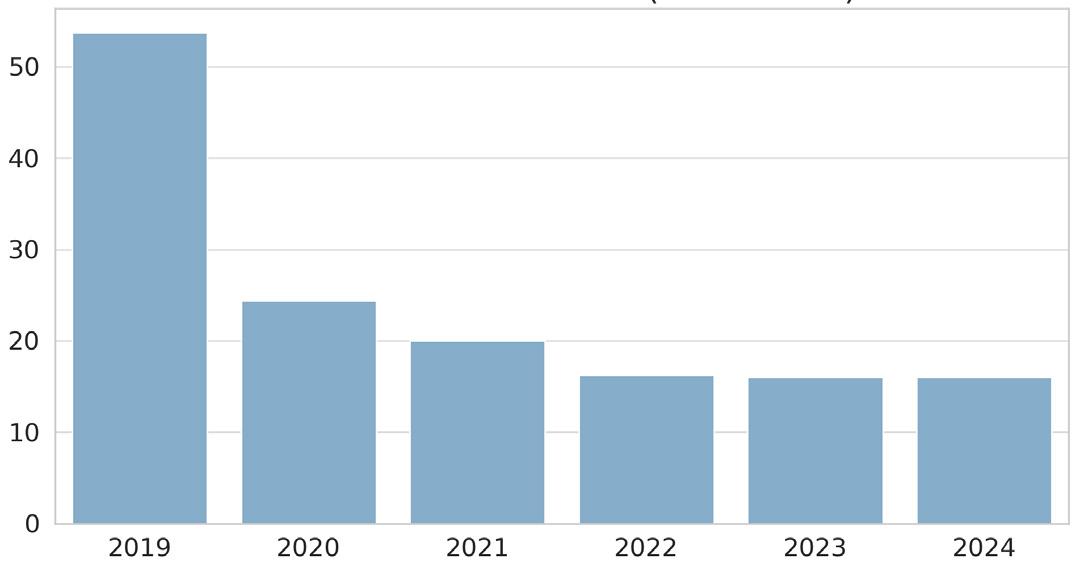
Net losses ($millions)
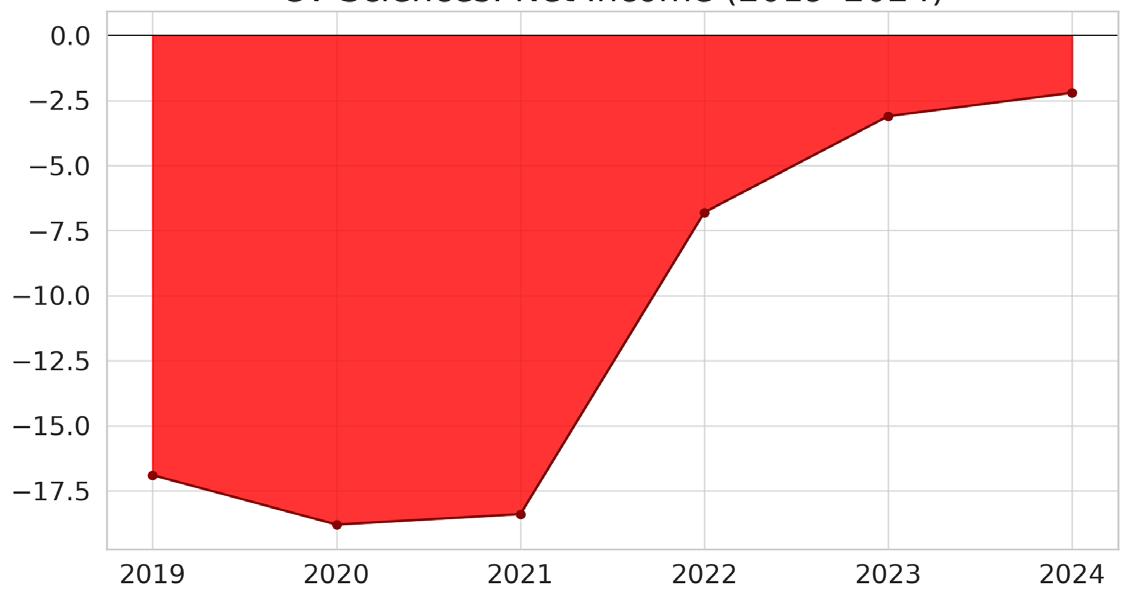
Share price ($00.00)
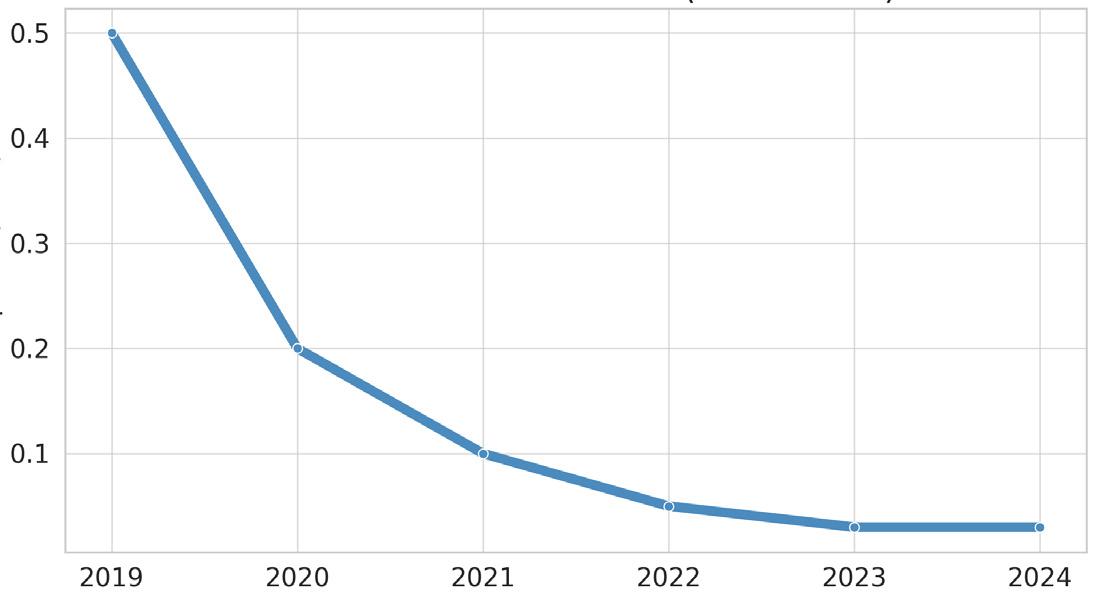
due to the acquisition of two Australian food companies in late 2023.
The rise of intoxicating hemp products—particularly semi-synthetic forms of THC such as Delta-8 and THC-A— has further marginalized traditional CBD categories. Halderman said most growers and processors he knows have abandoned CBD extraction in favor of THC-A flower, which commands a higher price and attracts more consumer attention.
“Most everybody’s transitioned over to
Charlotte’s Web (CWBHF)
Revenues ($millions)
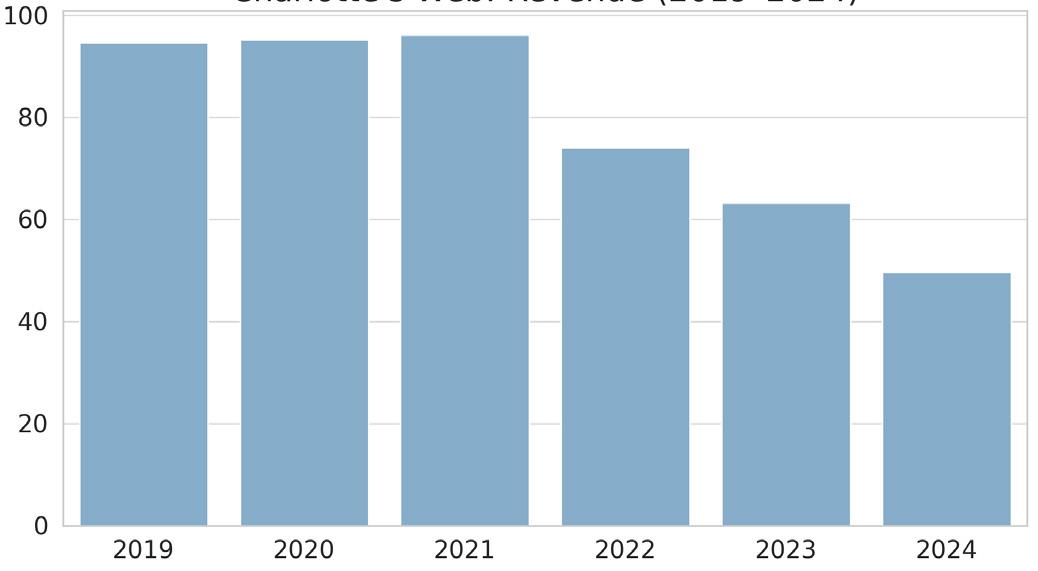
Net losses ($millions)
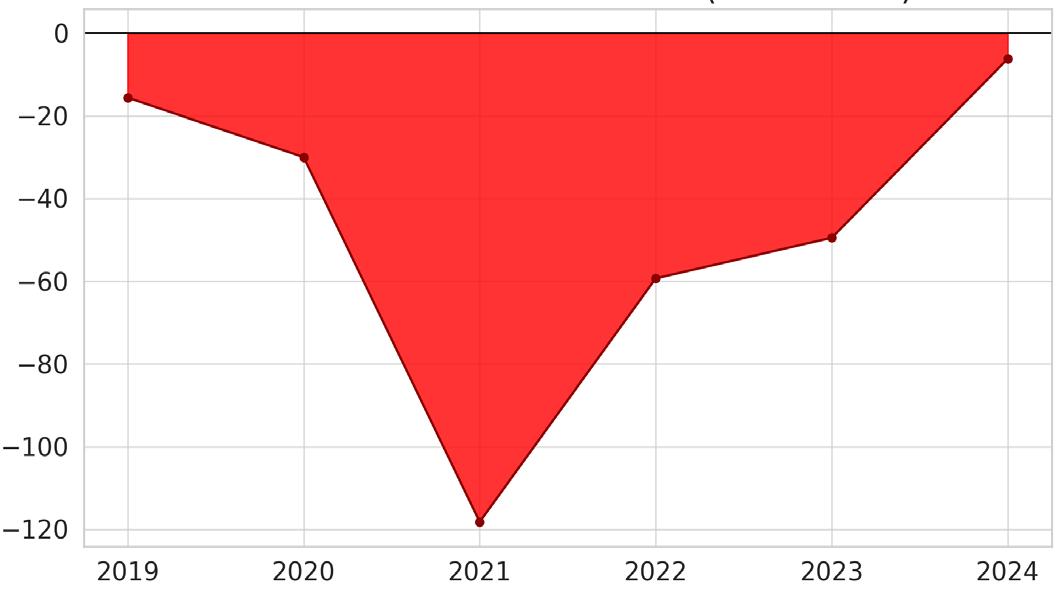
Share price ($00.00)
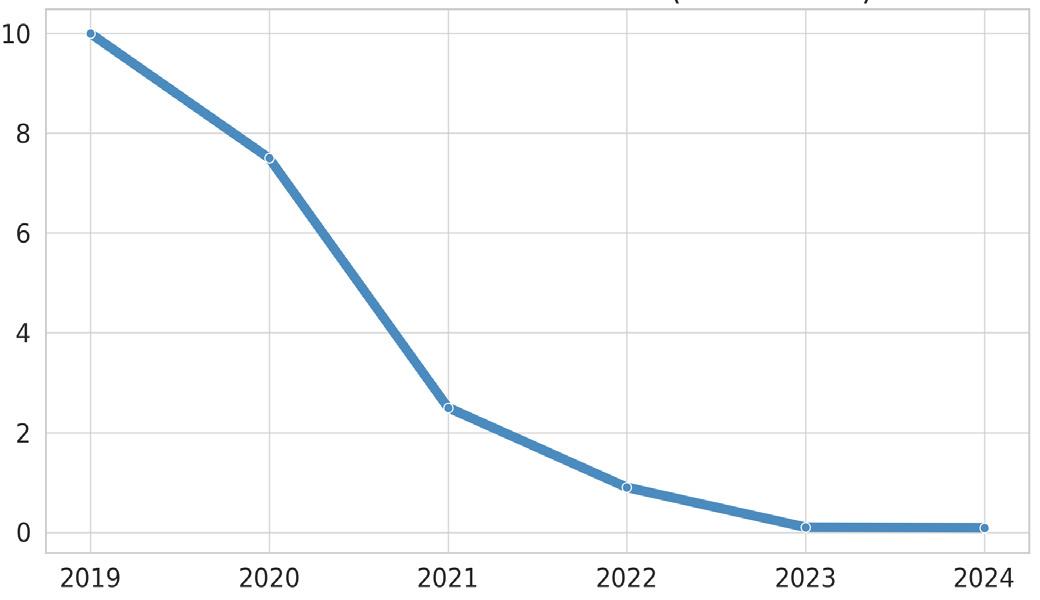
some form of THC-A stuff,” he said. “It’s sad. Our market wasn’t supposed to be that—but that’s what it is now.”
The rush into intoxicating hemp has redirected infrastructure and research away from cannabidiol. “Try to find me a Hawaiian Haze or some new strain,” Halderman said. “We can’t find them.”
At the same time, the CBD market has not evolved fast enough to establish new footholds in functional health or consumer packaged goods. While companies like
Charlotte’s Web and cbdMD are leaning into wellness branding, gummies, and pet CBD, others are still grappling with eroding shelf space and consumer fatigue.
Regulatory threats
CBD stakeholders face a double bind: while synthetic intoxicants remain largely unregulated, the traditional CBD market operates in a policy vacuum. The longdelayed 2023 Farm Bill may finally ad-
cbdMD (YCBD)
Revenues ($millions)
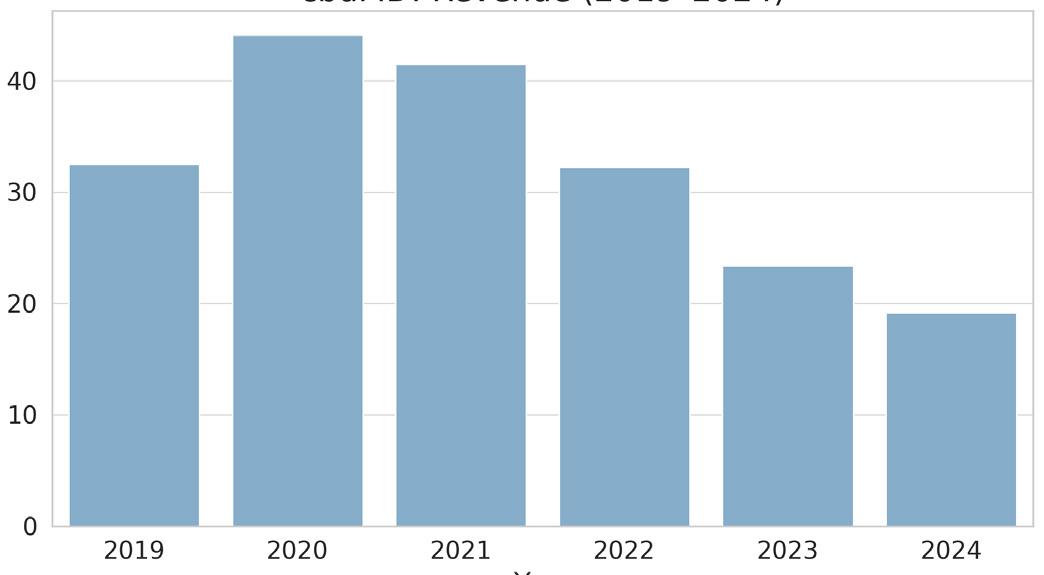
Net losses ($millions)
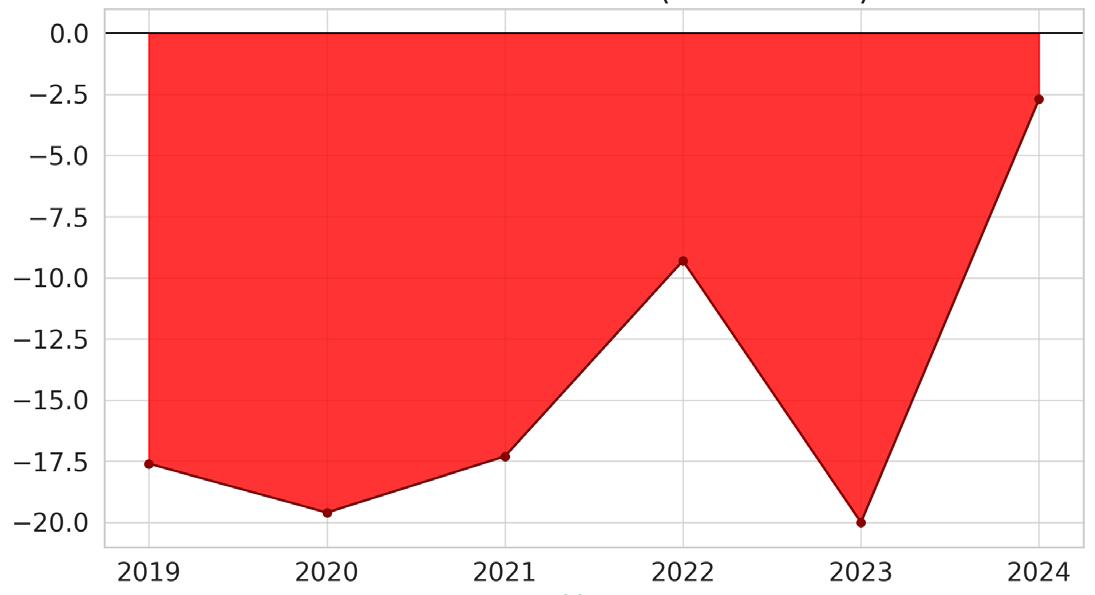
Share price ($00.00)
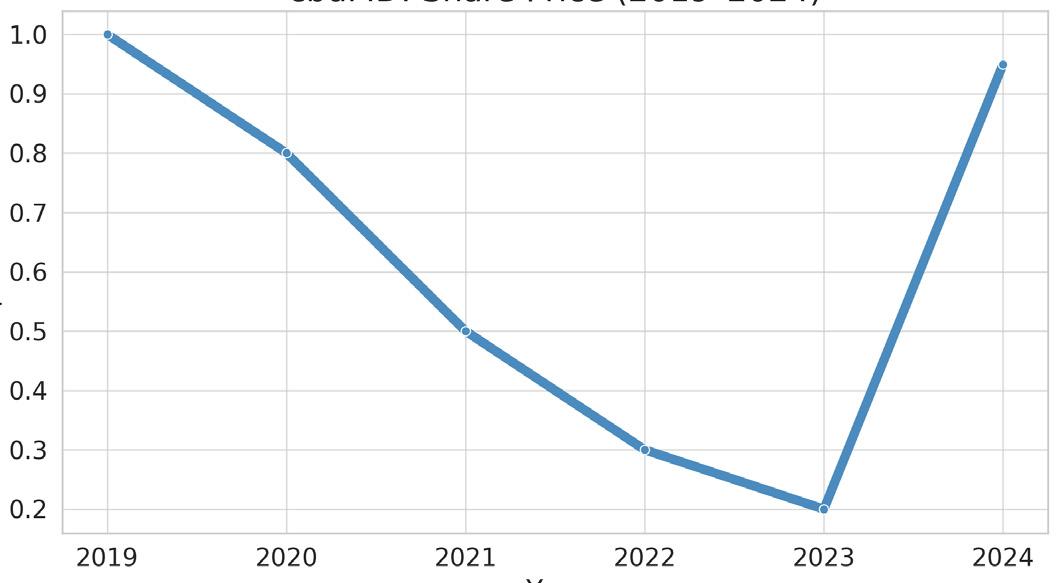
dress this discrepancy, but federal action could simultaneously restrict hemp-derived THC while imposing new compliance burdens on CBD companies.
“The entire cannabinoid side is about to get squeezed,” said Steve Groff, a Pennsylvania hemp farmer and regenerative agriculture advocate. “If we see federal rules banning intoxicating hemp, the wholesale CBD market will collapse even further.” Groff, who remains active in hemp-based construction and agricultural inputs, said the CBD sector “still hasn’t sorted itself out.”
Another unaddressed pressure point is international dumping. Halderman warned that low-cost CBD distillate— produced as a byproduct in countries where sales are restricted—is flooding the U.S. market. “They produce a lot of
Elixinol (ELLXF)
Revenues ($millions)
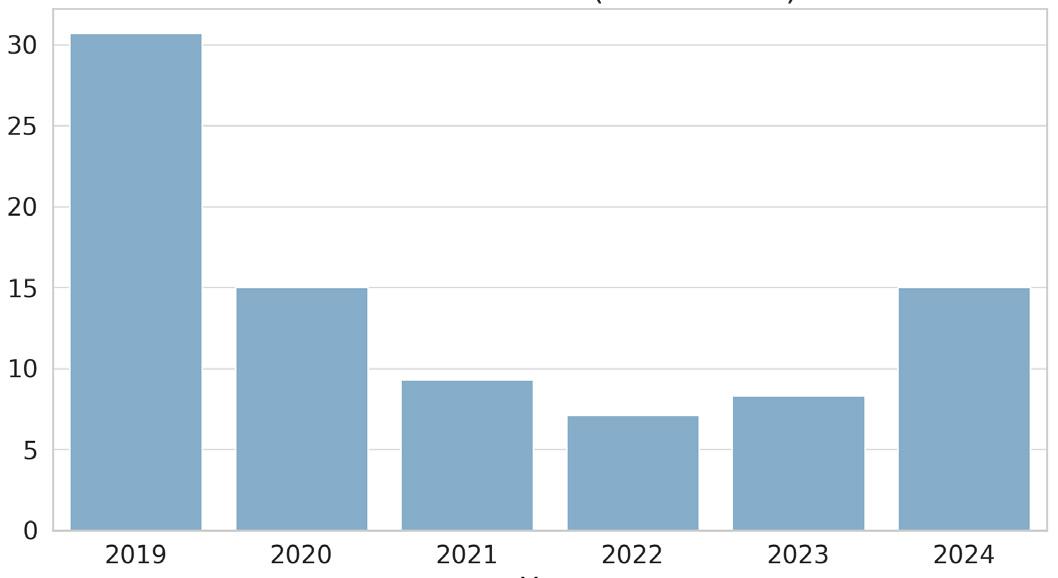
Net losses ($millions)
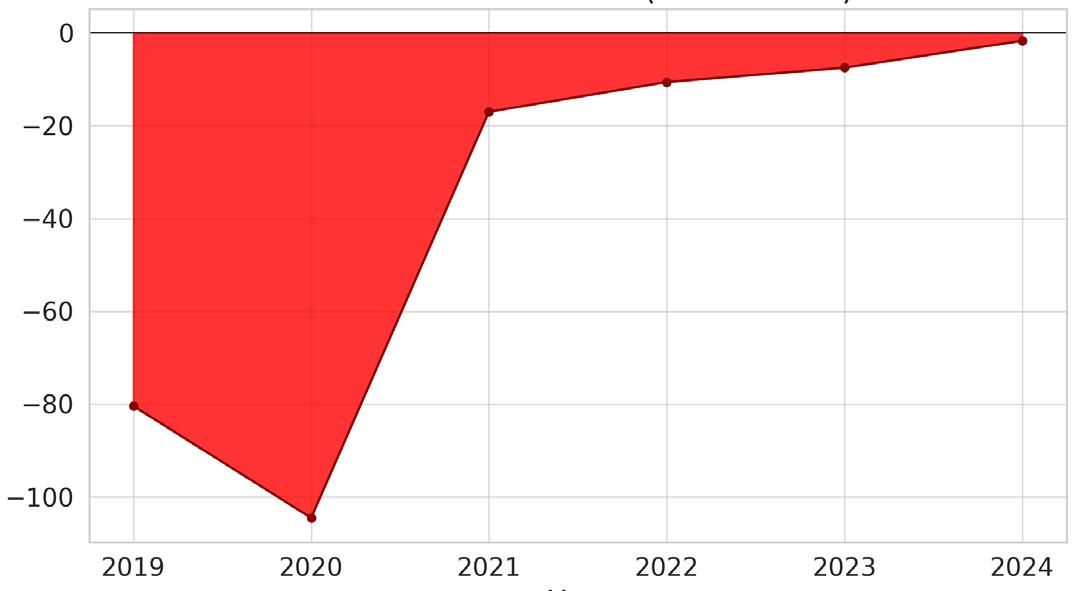
Share price ($00.00)
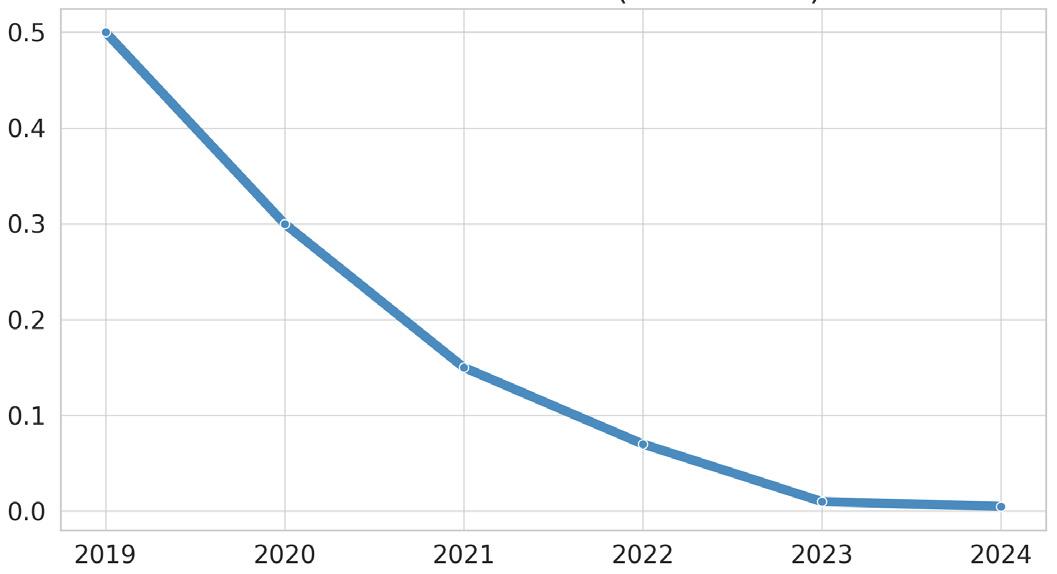
hemp, they use a lot of fiber and biomass—but none of their citizens can use a CBD product. So it’s dumped on our market,” he said, naming China and India as likely sources.
This glut has undermined U.S. producers who invested in extraction capacity when CBD was fetching far higher prices per kilogram. Today, most biomass remains unprocessed, and many farmers have left the industry altogether.
A market in search of a reason
Despite personal belief in CBD’s health value, Halderman said he plans to exit the retail cannabinoid business entirely if his industrial fiber operations prove viable in 2025. “I believe everybody should have CBD in their diet every day,”
he said. “But I wouldn’t have a retail side next year if I could avoid it. The market is just not there.”
Groff agreed, noting that the market remains flooded with low-quality products and inconsistent labeling. “There’s still no serious enforcement,” he said. “And consumers don’t know what to trust.”
Public companies acknowledge a credibility gap. In Charlotte’s Web’s latest report, the company emphasized quality, traceability, and third-party testing as central to its strategy. Similarly, cbdMD is investing in direct-to-consumer education and brand consistency to distinguish itself from less reputable players.
But even for the most resilient brands, the stakes remain high. As regulatory and economic pressures mount, CBD companies face a stark choice: evolve—or exit.
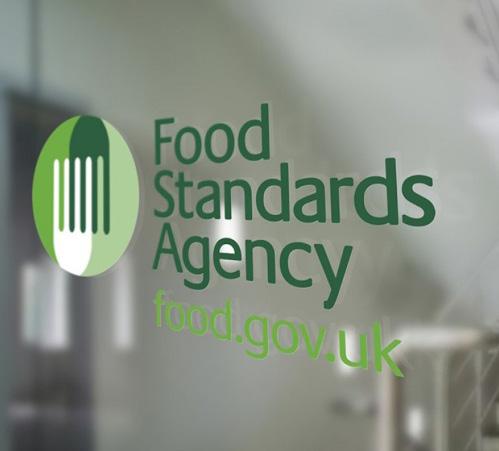
Stakeholders are anxiously waiting to see if their products will be approved by the FSA under UK novel food rules.
EUROPE: The CBD sector is trading hype for hard-won discipline. As regulations advance and unrealistic expectations fade, resilient companies are finding new footing in niche markets and smarter positioning—marking a quieter, more sustainable chapter.
Europe’s once-hyped CBD sector is transitioning into a more disciplined and segmented phase, shaped by regulatory gridlock, fading retail enthusiasm, and shrinking margins. While many players have exited entirely, a few resilient manufacturers and extractors continue to adapt, serving niche markets that remain stable—if no longer growing.
From the UK to the Balkans, companies report that CBD sales have fallen well below the peak years of 2018–2019. “The market might be shrinking slightly, but there is a market,” said Maciej Kowalski, CEO of Poland’s Kombinat Konopny. “It’s already saturated. But the market for sausages is also not growing. It might not be sexy, but it’s still there.”
Sasha Bajilo, CEO of Croatia-based Ilesol Pharmaceuticals, noted that market
volume is down by roughly 80% from its peak. “Currently, everybody knows the market is stagnating,” he said. “The peak for us was 2019... I would say that we are maybe at 20 percent of that volume.”
No miracles
Joscha Krauss, managing director of Germany’s MH medical hemp GmbH, said public expectations never matched CBD’s real utility. “By many players on the market, it was considered and sold as a miracle drug,” he said. “But with the concentration of active ingredients required for an immediate effect, it is a medicine. With a lower, health-supporting concentration, it could be a dietary supplement, but this does not yet have the necessary approval.”
All three companies have adjusted their strategies. Ilesol has postponed the
launch of a new branded product line until compliance is secured. MH medical hemp made a more decisive shift: the company has exited the branded consumer products business entirely, pivoting to focus solely on related raw materials, intermediate products and pharmaceutical supply. Kowalski continues to serve a core clientele with minimal overhead. As the dust settles, what’s left is a leaner, more pragmatic industry— still viable, but without illusions.
UK advances, EU stagnates
The United Kingdom is outpacing the EU in CBD regulation, with its Food Standards Agency (FSA) processing novel food applications that may result in a fully legal market later this year. If approvals move forward as expected, the UK could become the first country in Europe—and possibly the world—with a fully regulated national CBD marketplace.
For companies like Ilesol, which is in the final risk management stage of UK approval, that regulatory progress could be a major turning point. “We see this as a big opportunity for supplying mainstream brands,” said Bajilo.
Yet optimism isn’t universal. Kowalski is wary that UK progress may invite increased competition from corporate players. “The moment they say yes, isolated cannabidiol is a novel food will actually make my life slightly more difficult,” he said. “It will open the doors for larger companies... right now they’re staying out because it’s too complicated.”
Novel food: Lifeline or landmine?
Throughout the European Union, the novel food approval process remains the central regulatory bottleneck. Krauss sees it as essential to rebuilding market access and trust: “Once novel food is online and we are allowed to sell the product legally... then the gates open again.”
Others are more cautious. Bajilo believes compliance is key to rebuilding credibility: “We have never had access to the full market, just to the niche market,” he said. “What we need is compliance in the food supplement sector. Then this product can slowly develop again, with some stability.” Kowalski, however, prefers regulatory ambiguity, arguing that EU rulemaking could increase compliance burdens and invite large-scale competition. “I keep my fingers crossed that the EU does what it does best—which is nothing,” he said.
Many companies are now reckoning with the legacy of inflated promises. Krauss said shifting rules and vague classifications have created years of uncer-
tainty for consumers. “It’s super confusing,” he said. “It’s not very trust gaining from consumers.”
Bajilo points to irresponsible marketing as a major factor in consumer disillusionment. “False advertising is wrong on many different levels,” he said. “CBD is natural medicine, but not for everything, not for everybody and not for everyone.”
Unlike the United States, where synthetic intoxicants like delta-8 THC have flooded the market, Europe has so far avoided this disruptive trend. Bajilo warned these substances could destabilize global CBD markets. “This situation can really complicate the CBD business worldwide—and honestly, it can shut it down,” he said.
Kowalski put it more bluntly: “I’ve been seeing all those CBD lemonades on the gas station in the U.S. I mean, who needs that?”
Drawing lines
Whether Europe maintains this distinction will depend on how tightly it draws the regulatory line between therapeutic cannabinoids and intoxicating hemp derivatives.
Europe’s CBD sector is no longer driven by hype, celebrity endorsements, or runaway projections of explosive growth. The excitement that once surrounded cannabidiol has given way to something quieter—but perhaps more enduring: a slow, steady recalibration of what this market can realistically support.
For the companies that remain, survival increasingly depends on fundamentals: supply chain control, regulatory compliance, modest margins, and credibility with both customers and authorities. Many are learning to operate more like traditional health supplement or pharmaceutical firms than startup disruptors.
Give us a normal market
That means trimming bloated product lines, shelving unsanctioned health claims, and working within—or pushing against—evolving legal frameworks. It also means recognizing that CBD is not a cure-all or a revolution in itself, but one tool among many in broader wellness and medical markets.
“We don’t want to be seen as some crazy cannabis people, pushing products under the desk,” said Bajilo. “We want to be part of a normal market.”
In that vision—less hype, more structure—may lie the sector’s best hope for lasting relevance. Europe’s CBD industry isn’t dead. But its next chapter will be written not in booms and buzzwords, but in staying power, smart positioning, and long-term trust.

ASIA PACIFIC
Cautious liberalization, strategic growth
Asia has historically been conservative in its approach to cannabis and hemp, but there are signs of gradual liberalization.
• China, the world’s largest hemp producer, allows CBD for cosmetic use only, restricting its inclusion in food and dietary supplements. However, the country remains a major exporter of CBD isolates and raw materials to other markets.
• Japan technically permits CBD as long as it is extracted from stalks and seeds – which it isn’t. Sellers have simply skirted the rules by labeling their products as compliant, and the government apparently turns a blind eye. The market in wellness and skincare sectors is growing steadily.
• Thailand briefly positioned itself as a leader by legalizing cannabis for medical and wellness purposes, but policy reversals in 2024 have created uncertainty. The government is reevaluating its approach to recreational and medical cannabis, which will impact CBD’s long-term prospects.
• South Korea and India have limited medical cannabis frameworks, but strict regulations prevent the widespread adoption of CBD products.
AFRICA
Early-stage market with export potential
Africa’s CBD market is in its infancy, but several countries are exploring the economic potential of hemp cultivation. Overall, Africa’s main advantage is low-cost hemp farming, making it attractive for export markets, but internal demand for CBD remains minimal.
• South Africa leads the way, having legalized CBD products with a maximum daily dosage limit of 20mg. The country has a growing domestic market but remains constrained by high regulatory barriers.
• Lesotho and Zimbabwe have positioned themselves as export hubs, granting licenses for large-scale hemp cultivation aimed at supplying international markets, particularly Europe.
• Malawi, Rwanda, and Uganda are also issuing licenses for hemp cultivation, though domestic demand remains limited due to low consumer awareness and purchasing power.
LATIN AMERICA
Cannabis liberalization driving growth
Latin America could emerge as a key CBD market if progressive cannabis policies are put in place.
• Colombia has positioned itself as a major CBD and medical cannabis exporter, benefiting from favorable cultivation conditions and regulatory support. However, domestic consumption remains modest.
• Brazil allows medical CBD products via prescription, but import regulations remain complex and costly, limiting market access.
• Mexico, despite decriminalizing cannabis, has struggled with regulatory delays in establishing a clear CBD framework.
• Argentina and Uruguay have legalized CBD for medical use, with Uruguay also embracing recreational cannabis. Uruguay’s export-oriented industry could play a crucial role in supplying global markets.
UK’s big CBD cleanup
Critics warn that low daily limits could hold back promising market
In a first for Europe, the United Kingdom is on the verge of becoming the only country with a functioning legal framework for cannabidiol (CBD) products—marking a turning point for the nation’s embattled hemp sector. After years of confusion and stalled applications, the UK’s Food Standards Agency (FSA) has begun approving novel food applications for ingestible CBD, moving the industry from legal limbo to regulatory legitimacy.
Five applications have passed the FSA’s safety review since January 2025, advancing roughly 850 individual products toward full authorization. The approvals come with stricter compliance demands, including clear labeling, traceability, and adherence to a 10mg acceptable daily intake (ADI) for CBD. Though controversial, these steps bring long-awaited clarity to a fragmented and uncertain market that has struggled since the FSA first classified CBD as a “novel food” in 2019.
The Cannabis Trades Association said the regulatory expectations are now clearer, stricter, and more aligned with scientific evidence and public safety.
Stricter rules in force
Updated guidance from both the FSA and the Medicines and Healthcare products Regulatory Agency (MHRA) has reaffirmed a hard line on compliance. The MHRA stated that any CBD product making medicinal claims must be regulated as a medicine and cannot be sold without marketing authorization.
Simultaneously, the FSA has confirmed that only ingestible, non-medical CBD products with validated novel food applications will be permitted on the market. With the closure of the so-called CBD Public List, products without progressing applications are now deemed non-compliant. Businesses can no longer use “white labeling” to rebrand a single approved formulation under multiple names. Each product must have its own distinct, traceable application.
Rebecca Sudworth, director of policy at the FSA, reaffirmed in a letter to the CTA that applications are reviewed based on the order received and on the quality of submissions. Since January 2019, the FSA has processed more than 12,000 submissions.
The FSA has also reiterated its controversial decision to apply a 10mg
Novel food sweepstakes
Right: 12,115 products remain at various stages of the FSA review
Below: Leading applications and the number of products they carry.

acceptable daily intake as the binding threshold for CBD consumption. This marks a steep reduction from the previous 70mg benchmark, blindsiding many in the industry when it was introduced in October 2023.
All five applications approved so far in 2025 adhere to the 10mg limit. The largest came from a joint application by TTS Pharma in Liverpool and Californiabased distributor HERBL, advancing over 830 products. Other approvals were granted to Brains Bioceutical, Mile High Labs, cbdMD, and Bridge Farm Group. Industry groups argue the ADI is being misapplied as a rigid cap rather than flexible guidance. The CTA said the limit does not account for important differences between isolates, distillates, and full-spectrum formulations. Critics warn that such low thresholds could stifle the market, render products ineffective, and deter investment in CBD innovation. For comparison, the European Industrial Hemp Association has proposed a 17.5mg daily limit as a more balanced alternative.
Despite the criticism, the recent approvals are being widely interpreted as a shift toward full market regulation. The
FSA plans a 12-week public consultation to review the first set of final authorizations. These initial decisions are expected to establish key benchmarks on THC content, product labeling, and formulation standards. Once the consultation is complete, the FSA and Food Standards Scotland will recommend approved products to ministers across Great Britain for legal sale.
Slow but visible
The CTA acknowledged the slow but visible progress, stating that the FSA’s actions now reflect a more science-based, transparent approach to CBD regulation. The association has encouraged companies to engage with the consultation process to ensure future rules balance public health with commercial viability.
While the UK’s novel food framework has drawn criticism for its delays, shifting criteria, and uneven enforcement, many now see it as the first truly operational system for CBD products in Europe. With the FSA’s new clarity, the UK is poised to become a regulatory model for other nations navigating the rapidly evolving hemp and CBD landscape.
UK Food Safety Agency
EIHA consortium (RP 427)
B3 (UK) + Mile High Labs (USA) (RP349 ) TTS Pharma (Jevalex, HERBL) (RP521)
Meloni’s War
Legal experts, regions, and farmers rise against controversial decree

Italy’s escalating campaign against hemp and CBD has sparked fierce backlash at home and abroad, with legal experts, business leaders, and European officials warning that Prime Minister Giorgia Meloni’s policies are not only economically destructive—they likely breach EU law.
The flashpoint is a sweeping “Security Decree,” enacted in April by Meloni’s administration, which classifies industrial hemp flowers and non-psychoactive cannabinoids like CBD, CBG, and CBN as narcotics regardless of THC content. By bypassing Parliament and invoking emergency powers, the government criminalized the cultivation, sale, and possession of hemp flower products across Italy.
The move comes on the heels of a separate ban on oral CBD compositions, upheld by Italy’s Lazio Regional Administrative Court, which declared CBD a pharmaceutical substance restricted to prescription use only. Both actions have stunned Italy’s hemp sector and ignited a full-scale legal and civic mobilization.
EU position on CBD
The European Union has long supported the legality of CBD and hempderived products with THC levels below 0.3%, recognizing them as agricultural goods subject to the internal market’s free movement of goods. In 2020, the European Court of Justice ruled that CBD is not a narcotic and that member states may not prohibit its sale unless scientific evidence of health risks exists. The European Commission’s Cosing database also lists CBD as non-psychoactive and nonaddictive, approving its use in cosmetics and food supplements.
Meloni’s decree, critics say, flagrantly ignores these guidelines.
Regional councilors for agriculture—aligned under the powerful Italian Confederation of Agriculture (Cia)—have issued a rare unified rebuke of the decree. Calling it “ideological,” they warned that it erases a thriving supply chain that supports sustainable farming, construction, and bioplastics. Legal scholars have echoed the concern, arguing that the decree law violates Articles 25 and 77 of Italy’s Constitution, as well as the EU treaties guaranteeing free movement of legal goods.
Court greenlights ban
While earlier courts had suspended the CBD ban citing lack of evidence, a surprise ruling from Lazio’s TAR on April 21 allowed the measure to stand, citing the EU’s “precautionary principle” on public health concerns. The Ministry of Health had warned of potential psychiatric and liver risks—but had not sought updated evaluations from scientific bodies. Experts from La Sapienza University and EU regulators say such risks are overstated.
The decision has left thousands of businesses in legal limbo.
In response, Italy’s hemp associations have launched a wide-ranging strategy to challenge the decree. Their campaign includes legal appeals in regional courts, constitutional challenges, and EU-level complaints. They are mobilizing both domestic and foreign companies to trigger scrutiny under EU free-trade rules and preparing class-action lawsuits for compensation due to economic losses. They also advise stakeholders to obtain legal insurance and are organizing public support efforts, encouraging businesses
to join trade associations, document enforcement actions, and contribute to legal defense funds. Organizers stress that early court victories could set precedent with industry-wide impact.
Legal experts say the emergency decree fails both scientific and legal tests. Under Italy’s Constitution, emergency laws must be justified by urgency and necessity—and must be ratified by Parliament within 60 days. Critics argue that no imminent public threat was evident and that the decree’s vague language criminalizes lawful business retroactively, violating legal certainty and due process.
“This is an act of unprecedented gravity,” said Imprenditori Canapa Italia in a public statement. “Thousands of honest entrepreneurs have been reclassified as criminals overnight.”
What’s next
The decree now faces an uncertain fate. President Sergio Mattarella has not yet signed the measure into permanent law. Parliament must ratify or reject it by early June.
Meanwhile, Italy’s hemp industry— once hailed as a model for sustainable agriculture—is shrinking under legal pressure. Over 3,000 businesses and up to 30,000 jobs are now at risk in a sector worth nearly €2 billion.
As the European Commission evaluates the case, stakeholders say a robust response is essential—not just for Italy, but for the integrity of the EU’s common market.
“The world of industrial hemp is not willing to silently suffer illogical and unconstitutional decisions,” said Canapa Sativa Italia.
PHOTO: Copyright: © EU/Christophe Licoppe
Brazil study backs therapeutic potential in cases of epilepsy
Acomprehensive analysis by researchers from Tiradentes University and the University of São Paulo has reinforced the potential of cannabidiol (CBD) as a treatment for patients with drug-resistant epilepsy. The study also calls for more clinical research to confirm long-term outcomes and refine treatment protocols.
Published in *Acta Epileptologica* (Springer Nature), the review evaluated six key clinical trials—three focused on Dravet syndrome and three on LennoxGastaut syndrome—selected from nearly 1,500 initial studies. Both forms of epilepsy are severe and frequently unresponsive to standard drug therapies.
Seizures reduced
The findings showed that patients treated with CBD experienced an average 41.1% reduction in seizure frequency, compared to 18.1% among those receiving a placebo— a 127% higher efficacy rate. However, researchers noted side effects such as sleepiness, decreased appetite, and diarrhea, and emphasized the need for more advanced methods of data collection, citing the unexpectedly high placebo response.
“Given these results, it is possible to conclude that the therapeutic response of cannabidiol is worthy of consideration in new protocols,” the authors wrote, recommending that public health systems evaluate CBD for their treatment plans.
The review adds to the growing body of research supporting CBD’s antiepileptic benefits. High-concentration, medicalgrade CBD is already approved for treating epilepsy-related conditions in children.
CBD dominates
Brazil’s evolving CBD landscape is being closely watched by global cannabis companies. With more than 200 million residents and growing acceptance of cannabis-based medicines, the country is viewed as a high-potential market. According to Statista, Brazil’s demand for medical cannabis was expected to reach \$185 million in 2024, with CBD accounting for as much as 80% due to fewer regulatory barriers than THCbased products.
Despite encouraging results, regulators continue to caution against potential risks, particularly for pregnant women, children, the elderly, and those with liver or reproductive system concerns, underscoring the need for continued research.
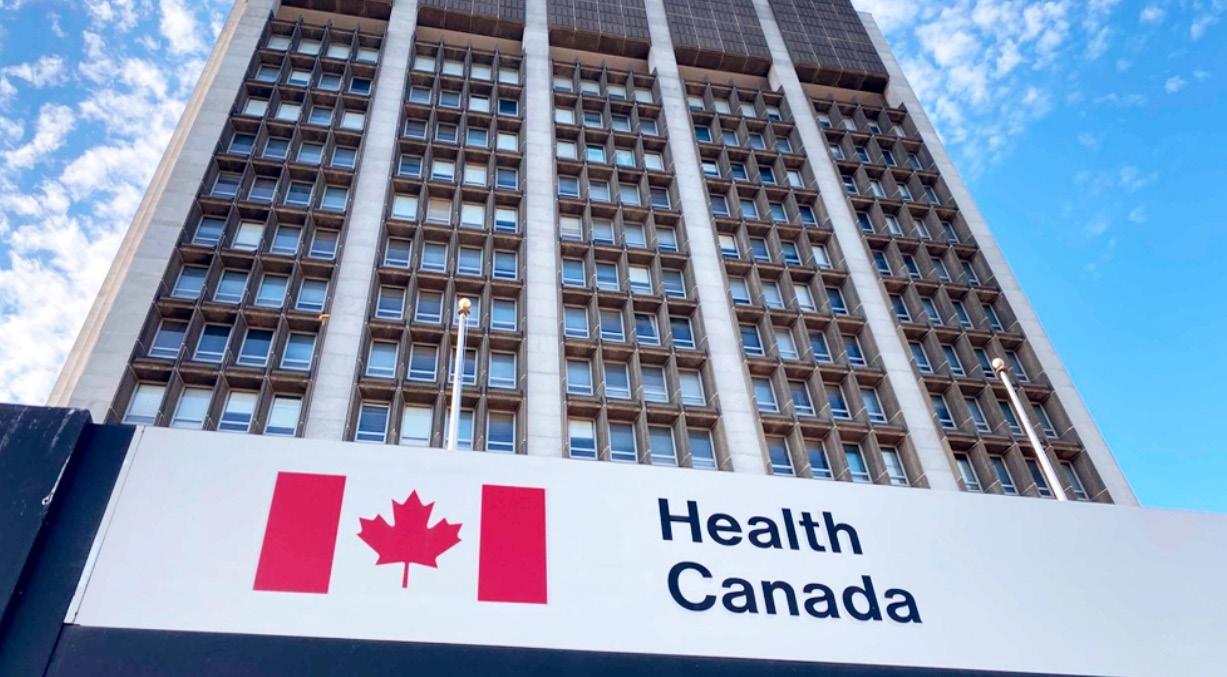
New path opens in Canada as consultation is underway
Health officials in Canada have launched a public consultation seeking feedback on a regulatory framework that could open up the market for over-the-counter CBD products. Currently regulated like marijuana under the Cannabis Act of 2018, CBD is limited to sales through licensed cannabis dispensaries under strict rules. The proposed framework would change all that by making CBD products available through grocery stores, pharmacies, and health food retailers.
While the regulated market has already reached nearly a half-billion U.S. dollars, if CBD were reclassified as a natural health product or dietary supplement, it could drastically expand the market. Under the current rules, forecasts show only modest growth for CBD.
Lowering costs
A reclassification would also streamline distribution, lowering costs for producers and retailers. With fewer regulatory hurdles, prices could drop, and more companies could enter the market, leading to innovation and increased competition, stakeholders have suggested.
Health Canada, the government health agency, opened the consultation March 7; it runs through June 5. The consultation invites input from industry stakeholders, health professionals, researchers, Indigenous partners, consumer organizations, and the general public.
The suggested pathway would permit CBD to be included as a medicinal ingredient in natural health products (NHPs), with a strict THC limit of 10 parts per million (ppm). Products would undergo comprehensive safety and efficacy assessments, aligning with existing
NHP approval processes, according to the proposed changes. Activities such as manufacturing, packaging, labeling, and importing CBD-containing products would require specific licensing, and import/export regulations under the Cannabis Act would still apply.
Key questions
In the consultation, stakeholders are asked if drug licenses and enhanced security controls are necessary for CBD and whether additional raw material good manufacturing practices (GMP) standards should apply to CBD suppliers.
There is also a discussion around the need for a certificate of analysis to support product quality, and whether the products should carry warning labels due to potential interactions with prescription drugs. Feedback is also sought on clinical trials, sales locations, and packaging considerations to optimize consumer safety and promote informed usage.
Pet products included
Health Canada is also considering regulating CBD health products for animals as non-prescription veterinary drugs under the Food and Drug Regulations.
Stakeholders are encouraged to share views on whether a streamlined regulatory pathway is appropriate for pet products. Specific questions include the level of scientific evidence required for manufacturing processes, and the need for certificates of authorization to ensure product quality. There are also considerations on the sale and promotion of CBD pet products, particularly in veterinary clinics and pet stores, along with post-market safety monitoring.
New oral drug enters Phase 2 trials for autism
The U.S. Food and Drug Administration (FDA) has authorized Phase 2 clinical trials for an oral CBD solution intended to address autism spectrum disorder (ASD).
The initiative to develop the drug is under DeFloria, Inc., a collaboration formed in 2023 among three entities –Charlotte’s Web Holdings, Inc., Ajna BioSciences PBC, both of Colorado, and British American Tobacco (BAT) PLC.
The Phase 2 trials, scheduled to start this summer, are designed as an openlabel, 12-week study involving 60 patients aged 13 to 29. The primary objectives are to assess the safety, tolerability, and efficacy of the drug, “AJA001,” in adolescents and adults with ASD, and to obtain data on which to base larger Phase 3 trials.
Strategic alignment
DeFloria brings together Charlotte’s Web’s expertise in hemp cultivation, Ajna BioSciences’ focus on botanical drug development, and strategic investment from British American Tobacco.
The group hopes to develop AJA001 as a treatment for behavioral symptoms associated with ASD, addressing a critical need for more effective drugs to improve social communication and interaction, and quell restricted and repetitive behaviors. Irritability and impulsivity are common symptoms that can impact the quality of life for those who suffer the condition, and their families.
Phase 1 trials showed that AJA001 was well-tolerated across a range of doses, data that went into determining appropriate dosing protocols for the forthcoming Phase 2 study.
The drug could still be as long as eight years away. Phase 2 trials, which assess efficacy, take two to three years; Phase 3, where the drug will be tested in a larger population, typically lasts 3 to 5 years. Once Phase 3 trials are complete, the company submits a New Drug Application to the FDA, which can take another year to approve.
AJA001 represents BAT’s first entry into clinical-stage cannabis research, as the tobacco giant has steadily expanded into the cannabis sector in a strategy that goes beyond tobacco, picking up assets in next-generation cannabis products that include both THC and CBD, vaping, and CBD-infused oral nicotine pouches.
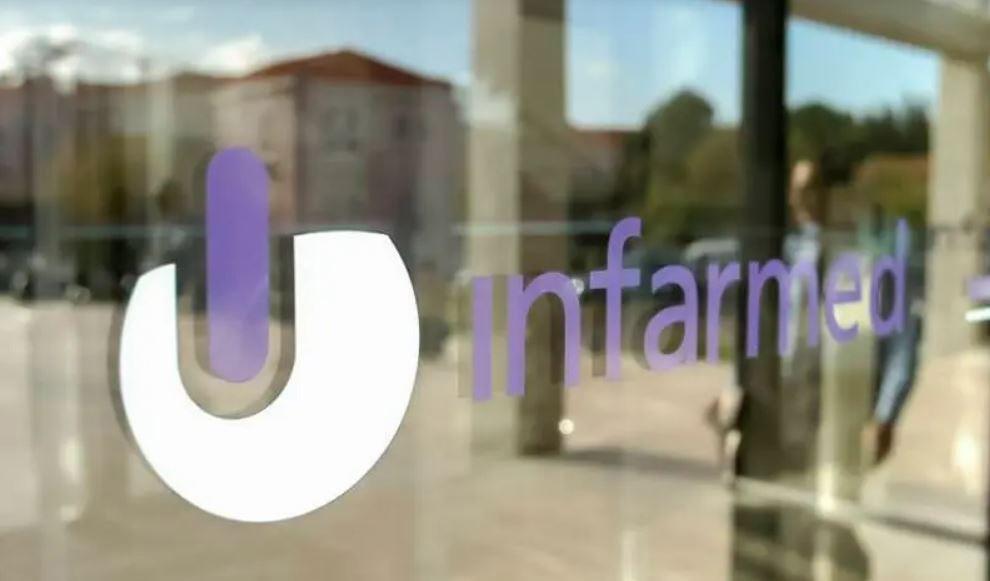
Legal challenge expected after crackdown in Portugal
Portuguese regulators are facing criticism over their decision to withdraw several cosmetic products containing cannabidiol (CBD) from the market, a move that contradicts European Union law regarding the free movement of goods.
Infarmed, Portugal’s National Authority for Medicines and Health Products, argues that CBD extracted from resins, tinctures, or extracts of the cannabis plant constitutes a narcotic under EU regulations. However, this interpretation directly conflicts with a 2020 ruling by the European Court of Justice (ECJ), which determined that CBD is not a narcotic and should not be restricted in trade among EU member states.
Infarmed has ordered the immediate withdrawal of multiple CBD-infused cosmetic products from brands such as SVR, Naturasor, and Dermacol. The agency cites European regulations which prohibits narcotic drugs listed under the 1961 United Nations Single Convention on Narcotic Drugs in cosmetic products. Infarmed contends that CBD derived from cannabis extracts falls under this restriction, making its inclusion in cosmetics unlawful in Portugal.
Flawed thinking
The move follows a pattern of sporadic enforcement by Infarmed, which has previously issued similar notices for CBDcontaining products. The regulator appears to base its stance on the argument that the inclusion of an ingredient in the Cosmetic Ingredients Database (CosIng) does not equate to formal approval or authorization for its use. As such, Infarmed insists that CBD obtained from plant-derived resins or tinctures remains banned in cosmetics.
Infarmed’s approach clashes with EU law, particularly the ECJ’s landmark 2020 ruling in the KannaVape case. The court ruled that CBD extracted from the cannabis sativa plant, including from its flowers, does not qualify as a narcotic under the 1961 UN Convention. Moreover, the ruling established that EU member states cannot prohibit the sale of CBD products legally produced in another member state without providing scientific evidence of potential harm.
Prohibited barrier
The ECJ’s decision binds all EU institutions and requires member states to align their national regulations with this interpretation. As a result, Portugal’s restrictions on CBD cosmetics appear to violate the fundamental EU principle of free movement of goods. By blocking the trade of CBD products, Infarmed is effectively imposing a non-tariff barrier that EU law prohibits.
The Portuguese cosmetics market has seen significant growth in demand for CBD-infused products, mirroring trends across Europe. Consumers increasingly seek CBD for its perceived skincare benefits, and numerous brands have entered the space. However, Infarmed’s crackdown disrupts the sector, forcing companies to reformulate products—potentially with synthetic CBD—to circumvent regulatory challenges.
Moreover, the lack of clear guidance on CBD’s legal status in Portugal creates uncertainty for businesses and investors. Infarmed’s interpretation sets a precedent that could deter companies from entering the Portuguese market, putting the country at odds with broader European trends, where regulatory frameworks are becoming more CBD-friendly.

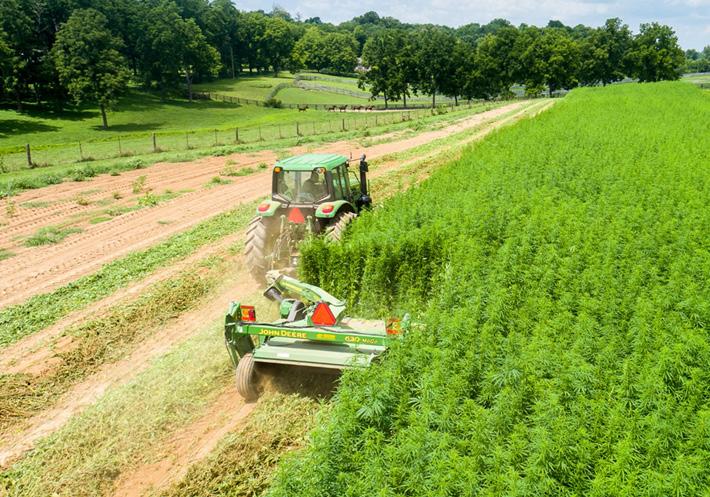
Whither ‘true hemp’?
U.S. market value jumps 40% as intoxicants fuel flower surge
The total value of U.S. hemp production jumped 40% to $445 million in 2024, according to the latest National Hemp Report from the United States Department of Agriculture (USDA). While the spike could signal renewed momentum in a sector still recovering from the spectacular CBD crash that followed the 2018 legalization boom, the story is far more complex—and far less reassuring.
Nearly all of the growth came from hemp flowers, cultivated primarily to produce unregulated intoxicating products derived from them. Hemp fiber and grain, meanwhile, remained stuck in lowvalue territory, with falling prices and stubbornly underdeveloped infrastructure, according to the report, from USDA’s National Agricultural Statistics Service (NASS).
“We’re seeing a bifurcation of the market,” said industry analyst Joseph Carringer of Canna Markets Group. “On one side, you’ve got the synthetic THC boom, which is short-term and legally precarious. On the other, you have fiber and grain, which are structurally sound in theory but not yet economically viable in
practice.”
The report, released yesterday, paints a picture of a hemp economy growing more reliant on controversial cannabinoid conversions than “true hemp” – grain and fiber – even as states and lawmakers move to rein them in.
Hemp flowers remained the economic engine of the industry in 2024. Farmers harvested 11,827 acres (up 60% from 7,383 acres in 2023), yielding 20.8 million pounds (up 159% from 8.0 million pounds). Despite a sharp increase in volume, pricing held firm, resulting in a total market value for flowers grown both outdoors and indoors of $415 million (up 43% from $302 million in 2023).
The average yield per acre for flowers also rose to 1,757 pounds (up from 1,088 pounds in 2023), suggesting improved genetics, practices, or environmental conditions.
Window closing for intoxicants?
Still, most of this value came from hemp flowers destined not for CBD wellness products but for intoxicating derivatives like delta-8 THC. These syn-
thetic substances are produced through lab conversion of CBD and continue to skirt marijuana regulations due to a gap in federal law—though that window is rapidly narrowing as more states and lawmakers push back.
Fiber fields up 56%
Farmers harvested 18,855 acres of fiber hemp in 2024 (up 56% from 12,106 acres in 2023), producing 60.4 million pounds of material (up 23% from 49.1 million pounds). But yields dropped sharply to 3,205 pounds per acre (down 21% from 4,053 pounds in 2023), and average prices continued to fall.
As a result, the cash value of fiber production fell 3% to $11.2 million, down from $11.6 million in 2023. The disconnect between rising volume and falling value reflects continued weakness in processing capacity, supply chain maturity, and market pricing. Even as more fiber is grown, there’s still no robust infrastructure to absorb it economically.
Hemp grown for grain rose modestly in 2024. Farmers harvested 4,863 acres (up 22% from 3,986 acres in 2023), yield-
Photo: Matt Barton
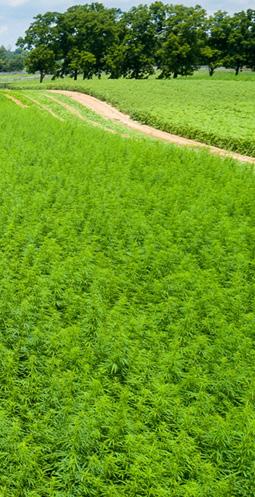
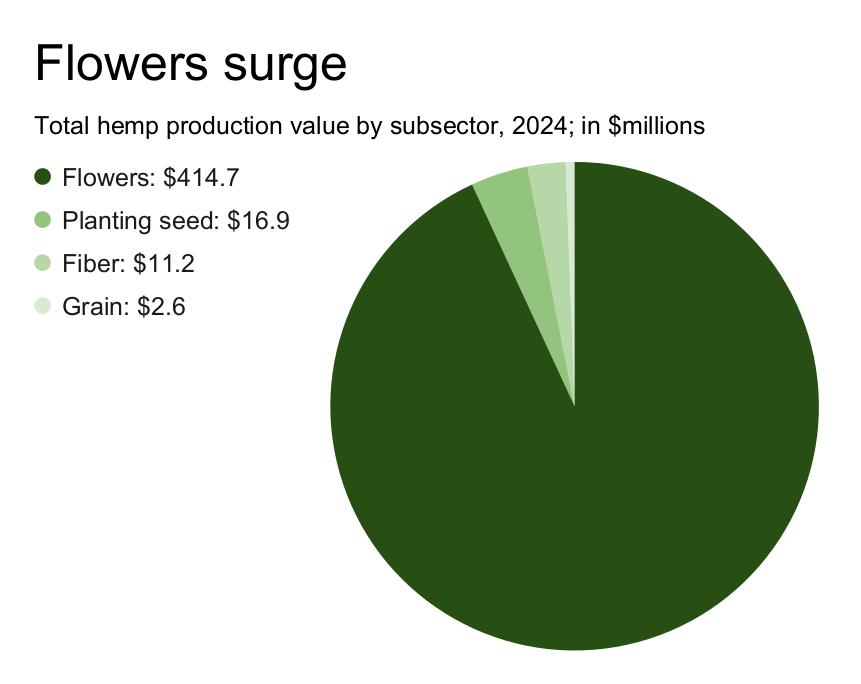
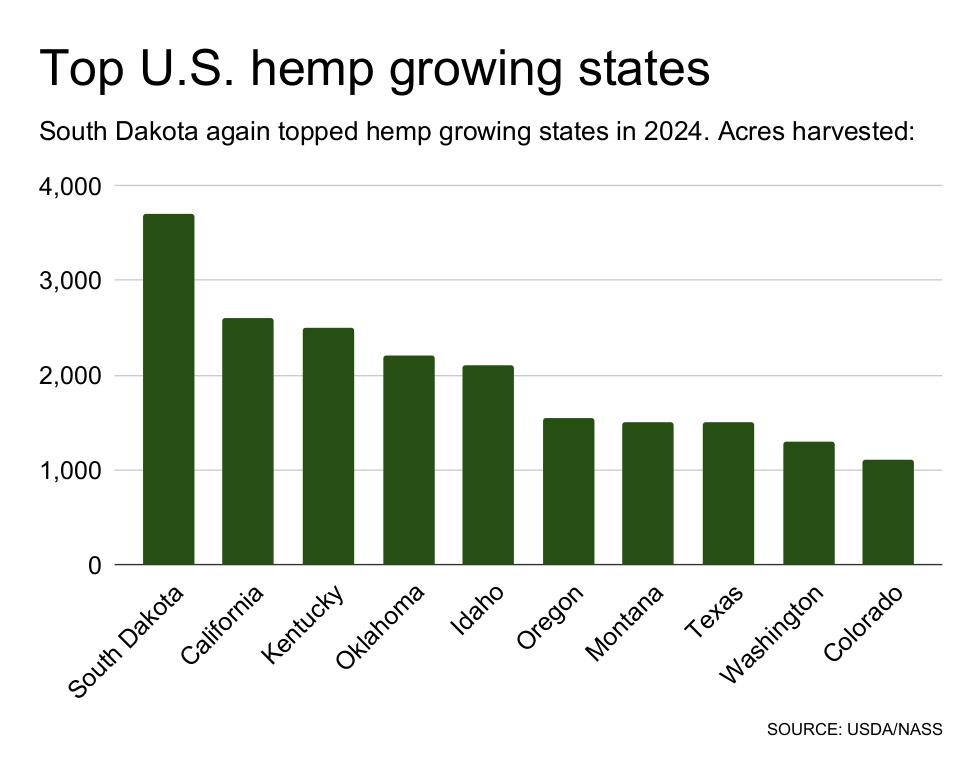
ing 3.41 million pounds of grain (up 10% from 3.11 million pounds). However, yields fell to 702 pounds per acre (down from 779 in 2023), and pricing remained flat.
Still, total value increased 13% to $2.62 million, up from $2.31 million the previous year. While not a breakout, it was a step in the right direction for a category where the U.S. continues to lag behind Canadian imports.
Breakout growth for seed
The strongest percentage growth in 2024 came from hemp cultivation seed. Growers harvested 2,160 acres (up 61% from 1,344 in 2023), producing 697,000 pounds of seed (down 7% from 751,000 pounds in 2023 due to lower yields of 323 pounds per acre, down from 559).
Yet despite reduced yield, prices surged, and the total value of seed reached $16.9 million—a massive 482% increase from just $2.91 million in 2023. The category’s strong performance reflects growing demand for specialized genetics and improved varietals as the market matures.
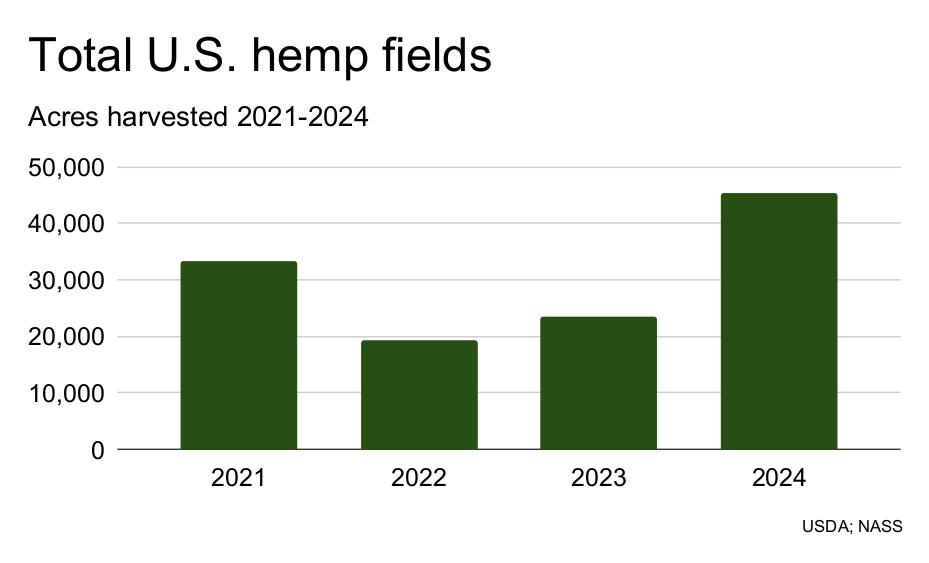
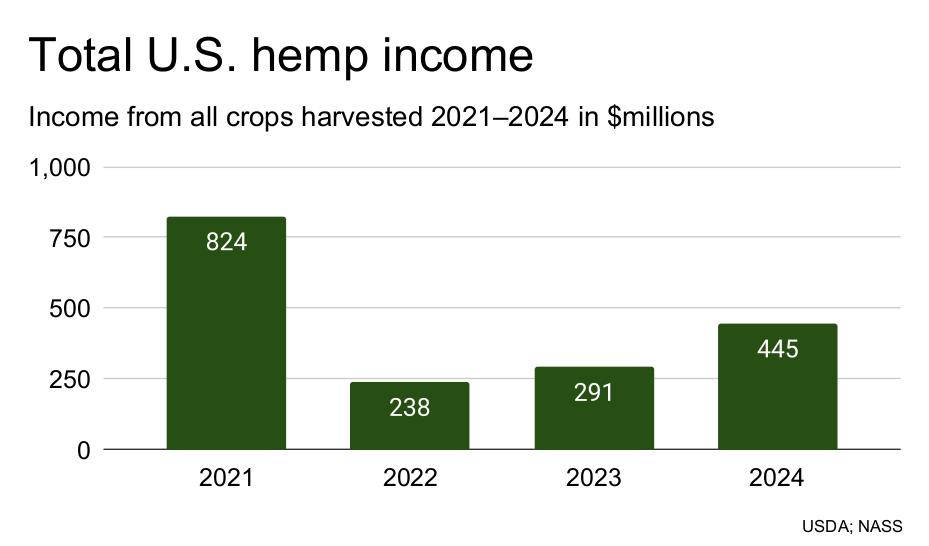
Status of intoxicating hemp products across the USA.
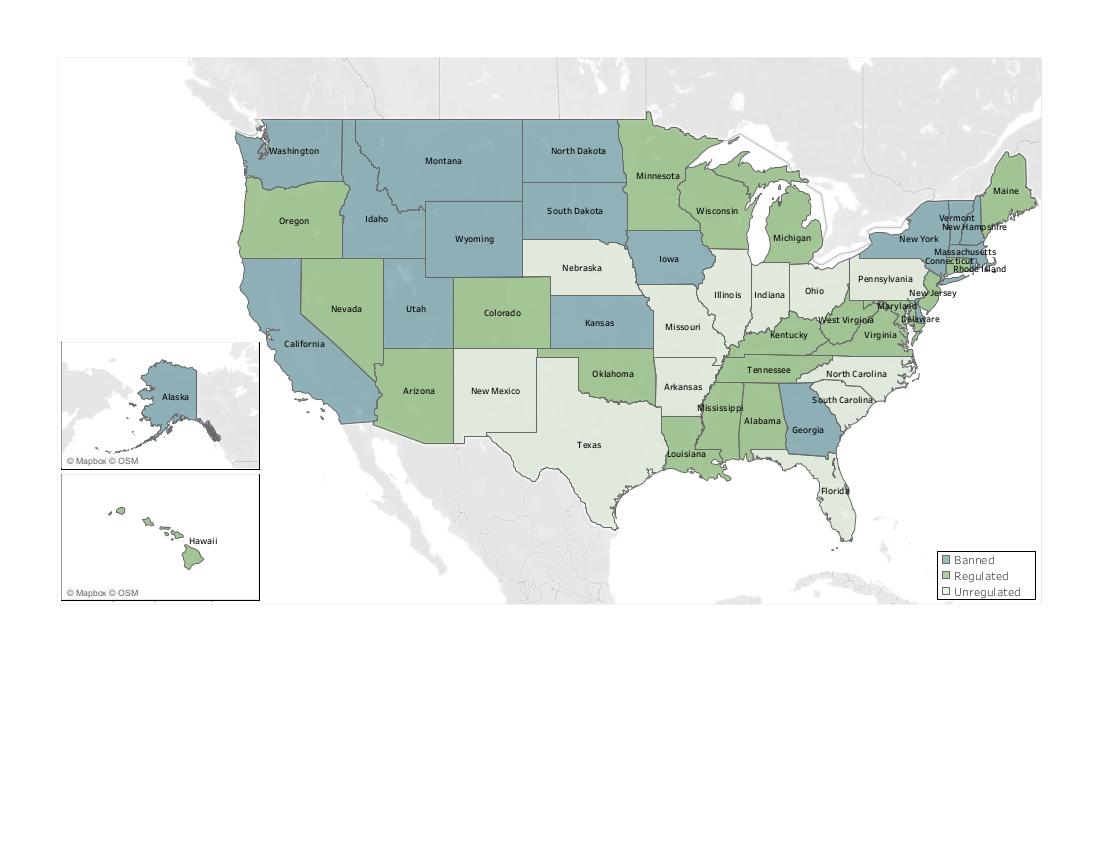
intoxicating hemp-derived products. These substances, often synthesized from hemp-derived CBD, include delta-8 THC, delta-10 THC, HHC, and other compounds that can produce a psychoactive effect similar to marijuana. Due to a loophole in the 2018 Farm Bill, which legalized hemp and its derivatives as long as they contain less than 0.3% delta-9 THC, these products have been marketed without federal oversight— frequently with no age restrictions, no mandatory testing, and packaging that appeals to children.
States step in
As a result, state governments have been forced to step in. The regulatory response has been swift and uneven. Some states have banned the products entirely. Others have imposed limits, licensing schemes, or adult-use requirements. Several still lack clear rules. The result is a patchwork of laws that has created uncertainty for businesses and confusion
non-intoxicating cannabinoid products, such as CBD, are now subject to serving limits and must be sold only to those 21 and older. Officials cited concerns about child safety and a lack of product controls in the growing market for hempderived intoxicants.
Critical divide
This situation has highlighted a critical divide in the hemp industry. On one side are the producers, processors, and innovators focused on hemp’s long-term value in food, fiber, construction materials, and regenerative agriculture. On the other are operators in the cannabinoid market—some legitimate, others less so—who have turned to intoxicating derivatives as a revenue stream following the collapse of the overhyped CBD boom.
Many in the traditional hemp sector argue that the public is now conflating “hemp” with these psychoactive substances, eroding the distinction between
federal research support.
A growing number of industry voices and policymakers are calling for federal clarity. The upcoming Farm Bill could address the problem by refining the legal definition of hemp to exclude synthetically produced intoxicants. National labeling standards, age limits, and potency thresholds are also under discussion.
Meanwhile, responsible companies are urging lawmakers to preserve access to legitimate, non-intoxicating hempderived compounds such as CBD—while clearly separating them from products designed to mimic marijuana.
Keep the promise
The hemp industry is broad, sciencebased, and rooted in agricultural and environmental promise. To ensure that promise is not lost, the upcoming Farm Bill must protect public safety, reinforce clear product categories, and help restore the public’s understanding of what hemp is—and what it is not. Banned
© 2025 Canna Markets Group
Banned Regulated Unregulated

■ Colorado: June 7, 2023, Colorado enacted SB 23-271, establishing a regulatory framework that classifies cannabinoids into non-intoxicating, potentially intoxicating, and intoxicating categories. The law sets specific THC limits and CBD-to-THC ratios for hemp products and requires licensing for the manufacture and sale of products containing intoxicating cannabinoids.
■ Connecticut: January 1, 2025, Connecticut implemented new regulations requiring hemp-derived products containing certain levels of THC to be sold exclusively through licensed cannabis establishments. This change aims to regulate products that, while derived from hemp, possess psychoactive properties due to THC content.
■ Delaware: Delaware classifies all tetrahydrocannabinols (THC) and their isomers, including Delta-8 THC, as Schedule I controlled substances. This classification renders the manufacture, distribution, sale, and possession of Delta-8 THC illegal within the state, regardless of its hemp-derived origin.
■ Florida: The Florida House and Senate ended the legislative session without agreeing on a unified framework to control the state’s booming market for high-potency hemp products.
■ Georgia: As of October 1, 2024, Georgia enforces stringent regulations on hemp-derived cannabinoids under SB 494. The law mandates that all consumable hemp products must contain no more than 0.3% total THC, which includes both Delta-9 THC and THCa. This effectively bans high-THCa hemp flower. Additionally, the sale of consumable hemp products is restricted to individuals aged 21 and over, and retailers must obtain proper licensing.
■ Hawaii: As of May 2025, Hawaii is implementing stricter regulations on hemp-derived cannabinoids. House Bill 1482, passed by the legislature in April 2025, mandates registration for manufacturers and retailers of hemp products, with enforcement beginning January 1, 2026. The bill also introduces penalties for unregistered sales and grants inspection authority to the Department of Health and Attorney General. Additionally, House Bill 302 aims to crack down on unlicensed CBD stores selling cannabis illegally, enhancing enforcement against unregulated hemp products. While these measures indicate a move toward regulation, a complete ban on hempderived cannabinoids has not been enacted.
■ Idaho: Based on the most recent and credible sources, Idaho enforces stringent regulations on hemp-derived cannabinoids. The state mandates that all hemp-derived products must contain 0.0% THC, effectively prohibiting any detectable amount of THC in such products. This regulation applies to both in-state and out-of-state manufacturers, and any product exceeding this limit is subject to law enforcement actions.
■ Illinois : As of May 2025, Illinois does not have specific regulations governing hemp-derived cannabinoids like delta-8 THC. Proposed legislation to regulate these products stalled in the Illinois House in January 2025 due to internal disagreements among lawmakers. Consequently, the sale and distribution of hempderived cannabinoids remain unregulated in the state.
■ Indiana: As of May 2025, Indiana is in the process of regulating hemp-derived cannabinoids, particularly Delta-8 THC. Senate Bill 478 has passed the Indiana Senate and is under consideration in the House. This legislation aims to establish a regulatory framework for Delta-8 THC products, including licens-
0.3% total THC. Certain products, such as vapes and edibles, are excluded from this exemption. Enforcement actions have been taken against non-compliant products.
■ Maine: Delta-8 THC and similar hemp-derived cannabinoids are legal but regulated under Maine’s cannabis laws, requiring licensing and adherence to potency limits.
■ Maryland: Delta-8 THC and similar hemp-derived cannabinoids are legal but regulated under Maryland’s cannabis laws, requiring licensing and adherence to potency limits.
■ Massachusetts: Intoxicating hemp-derived products, including Delta-8 THC, are prohibited outside of licensed cannabis dispensaries. Enforcement is inconsistent due to regulatory gaps.
■ Michigan: Delta-8 THC and similar hemp-derived cannabinoids are legal but regulated under Michigan’s cannabis laws, requiring licensing and adherence to potency limits.
■ Minnesota: Allows sales of hemp-derived edibles with up to 5 mg THC per serving and 50 mg per package; products must meet packaging, labeling, and testing requirements; sales restricted to individuals 21 and older.
■ Mississippi: Allows sales of hemp-derived edibles with up to 5 mg THC per serving and 50 mg per package; products must meet packaging, labeling, and testing requirements; sales restricted to individuals 21 and older.
■ Missouri: Multiple bills have been introduced to regulate intoxicating hemp-derived products, including Delta-8 THC, under existing cannabis laws. These proposals are currently under legislative review.
■ Montana: Montana prohibits the manufacture, sale, and distribution of synthetic cannabinoids, including Delta-8 THC and similar compounds.
■ Nebraska: Legislative Bill 316 proposes banning most hemp-derived THC products exceeding 0.3% THC by weight or 10 mg per package; includes a consumer safe harbor period through 2025.
■ Nevada: Delta-8 THC and similar hemp-derived cannabinoids are legal but regulated under Nevada’s cannabis laws, requiring licensing and adherence to potency limits.
■ New Hampshire: As of October 9, 2023, New Hampshire prohibits the sale, possession, and distribution of hemp-derived products containing more than 0.3% THC, including Delta-8 THC and other THC isomers.
■ New Jersey: Legislation advancing to ban synthetics and limit hemp THC sales to licensed dispensaries only.
■ New Mexico: Delta-8 THC and similar cannabinoids are currently legal and available. HB 346, under legislative review, seeks to regulate these substances, granting authority to the Environmental Improvement Board and establishing penalties for violations.
■ New York: New York prohibits the manufacture, sale, and distribution of Delta-8 THC and similar synthetic cannabinoids under its Cannabinoid Hemp Program.
■ North Carolina: Delta-8 THC and similar hempderived cannabinoids are currently legal and unregulated in North Carolina. However, pending legislation (S.B. 265 and H.B. 607) seeks to establish a regulatory framework, including licensing, testing, and age restrictions.
North Dakota: The North Dakota Century Code bans specific cannabinoids, including Delta-8 THC, THC-O Acetate, THCO, HHC, and THCP. These substances are considered psychotropic and are not permitted in any hemp products sold within the state.
: Delta-8 THC and similar hemp-derived cannabinoids are currently legal and available. Senate Bill 86, passed by the Ohio Senate, seeks to restrict sales to licensed marijuana dispensaries, impose a 10% tax, and enforce product testing and labeling requirements.
: Delta-8 THC and other hemp-derived cannabinoids are currently legal in Oklahoma. However, recent directives from the Governor indicate a move towards stricter regulation and enforcement.
: Oregon mandates that all intoxicating hempderived cannabinoids, including Delta-8 THC, be processed and sold exclusively through OLCC-licensed marijuana businesses, ensuring compliance with state safety, testing, and labeling
Pennsylvania: Delta-8 THC and other hemp-derived cannabinoids are legal in Pennsylvania under HB 967 (2016). However, there is currently no state-level regulation overseeing their sale, testing, or labeling, leading to concerns about product safety and consumer protection.
Rhode Island: Delta-8 THC and other hemp-derived cannabinoids are subject to stringent regulations in Rhode Island. While not entirely banned, these products face strict licensing, potency limits, and testing requirements that significantly limit their availability.
■ South Carolina: Delta-8 THC and other hemp-derived cannabinoids are currently legal in South Carolina. However, pending legislation (House Bill 3924) seeks to impose age restrictions, licensing requirements, and product limitations on these substances.
■ South Dakota: South Dakota prohibits the sale and production of chemically modified hemp-derived cannabinoids, including Delta-8 THC. Possession remains legal, but enforcement targets the manufacture and distribution of these substances.
■ Tennessee: Tennessee permits the sale of hempderived cannabinoids, including Delta-8 THC, under a regulated framework. Recent rules effective December 26, 2024, impose strict testing requirements, licensing mandates, and product restrictions to ensure compliance with THC content limits.
■ Texas: Senate passed ban on all THC-containing hemp products; bill stalled in the House as of May 2025.
■ Utah: Utah prohibits the sale, possession, and use of Delta-8 THC and similar hemp-derived cannabinoids by classifying all THCs as controlled substances, without exemptions for hemp-derived products.
■ Vermont: Vermont prohibits the manufacture, sale, and distribution of Delta-8 THC and other synthetic cannabinoids derived from hemp. The state’s Hemp Rules explicitly ban synthetic cannabinoids in hemp products, and violations may lead to enforcement actions.
■ Virginia: Virginia permits the sale of hemp-derived THC products under strict regulations, including a 2 mg THC per package limit or a minimum 25:1 CBD-to-THC ratio. Synthetic cannabinoids are banned, and retailers must comply with packaging, labeling, and registration requirements.
■ Washington: Bans all synthetic and hemp-derived cannabinoids—including delta-8 THC—outside the licensed cannabis retail system. Only licensed cannabis retailers may sell products with any detectable level of THC. This was enacted under Engrossed Second Substitute Senate Bill (E2SSB) 5367.
■ West Virginia: Delta-8 THC is currently legal in West Virginia. While Senate Bill 546 was signed into law in 2023 to classify Delta-8 as a Schedule I substance, its enforcement has been delayed. As of now, Delta-8 THC remains legal and unregulated in the state.
■ Wisconsin: Delta-8 THC is legal in Wisconsin under the state’s hemp laws, which align with the 2018 Farm Bill. The state defines hemp as cannabis with a delta-9 THC concentration of no more than 0.3% on a dry weight basis. Consequently, hempderived cannabinoids like delta-8 THC are permitted. However, the market remains largely unregulated, with no specific state laws addressing delta-8 THC. Consumers should be aware that while delta-8 products are available, their quality and safety are not guaranteed due to the lack of regulation.
■ Wyoming: Wyoming enacted Senate File 32 in March 2024, prohibiting the addition of synthetic substances or other additives to hemp. This legislation effectively bans the sale, possession, and distribution of Delta-8 THC and similar psychoactive hemp-derived cannabinoids. The law took effect on July 1, 2024.
Florida’s hemp gap
No deal on intoxicants as hemp bills collapse in legislative gridlock
New regulations aimed at protecting children from intoxicating hemp products will remain in effect after Florida lawmakers failed to pass broader legislation to rein in the popular compounds during the 2025 session.
Despite growing concern over unregulated hemp-derived intoxicants like delta-8 THC, the Florida House and Senate ended the legislative session without agreeing on a unified framework to control the state’s booming market for high-potency hemp products. The 60-day session concluded Friday, April 26, with no resolution in sight.
Competing bills stall
House and Senate leaders clashed over competing bills that sought to bring structure to the loosely regulated hemp sector, where consumable products often rival or exceed the potency of legal medical marijuana.
Rep. Michelle Salzman, a Pensacola Republican who led the House workgroup on hemp, introduced two measures: HB 7027 focused on product policy, and HB 7029 addressed taxation. The Senate, meanwhile, advanced a single bill, SB 438, sponsored by Sen. Colleen Burton, R-Lakeland.
Differences between the bills proved too deep to reconcile before the legislative deadline. The Senate’s version included a ban on synthetic hemp compounds, restrictions on outside advertising, and tighter caps on THC content. The House proposals, while focused on consumer safety, took a softer stance on those key provisions.
“While the House made significant progress… we were ultimately unable to align with the Senate version,” Salzman said. “We look forward to continuing this work in future Sessions.”
Targeting child safety
Some reforms did take effect independently of legislative action. New Florida Department of Agriculture rules now require child-resistant packaging for consumable hemp products and mandate QR-code labeling that links to lab results and product information.
The rules are aimed squarely at keeping intoxicating hemp out of the hands of minors and curbing cartoonish or candystyle packaging that critics say targets
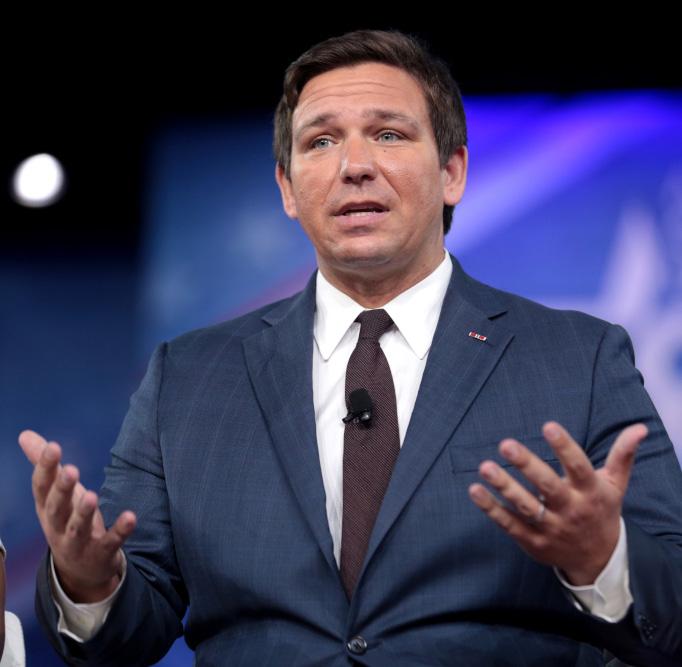
Desantis is playing both sides against the middle.
children.
The regulations also limit marketing strategies seen as appealing to youth, reflecting a growing push among lawmakers and regulators to draw clearer lines between adult-use cannabis products and child-safe consumer goods.
Political divide deepens
Florida’s fractured approach to cannabis policy reflects deeper political tensions. After vetoing hemp regulations last year, Gov. Ron DeSantis gained support from intoxicating hemp producers in his successful campaign to defeat Amendment 3, a 2024 referendum to legalize recreational marijuana.
With that initiative dead, Florida’s cannabis market remains split in two: heavily regulated medical marijuana available by prescription, and hempderived intoxicants sold freely in gas stations, smoke shops and online — often with no age restrictions.
Sen. Tracie Davis, D-Duval County,
introduced a separate bill, SB 1030, that would have banned delta-8 THC, limited delta-9 content to 2 milligrams per serving, and prohibited sales near schools. That measure also failed to gain traction.
National action looms
While Florida struggles to act, federal regulators could soon force the state’s hand. The U.S. Food and Drug Administration is reviewing hemp-derived cannabinoids, while the Drug Enforcement Administration may reclassify synthetic THC variants like delta-8 as Schedule I drugs.
Meanwhile, potential revisions to the 2018 Farm Bill — currently under debate in Congress — could close loopholes that allow for synthetic intoxicants under the hemp definition. If passed, those changes could dramatically curtail the availability of such products across state lines, including in Florida.
The Florida Legislature’s next regular session begins in March 2026.
U.S. Trade association succumbs at 30 Requiem for the HIA
One of the longest-standing cannabis organizations in the U.S., the Hemp Industries Association (HIA), appears tohave closed up shop.
Attempts by HempToday to reach officers and board members, including Kentucky farmer Mike Lewis, still listed on the HIA website as president, were mostly unsuccessful.
Jody McGinness, who had served as executive director since 2020, left his position in June 2024, according to his LinkedIn profile. Also, while the organization’s website is still online, emails sent to HIA addresses were all returned.
Two persons listed as board members on the HIA website told HempToday they had no specific notification that the organization has shut down, but indicated they were unsure of the trade group’s status.
“I haven’t done any work with HIA since maybe May of last year,” wrote one of the board members who responded to HempToday, adding “I think there was some reorganization being done. As far as I know, the organization is still active.”
Wrote the second: “I believe they are still ‘alive,’” however “no one is steering them at this time.”
Since
1994
HIA was founded by a group of hemp stakeholders in 1994 to advance hemp foods and fiber-based applications. By the midteens, internal arguments over CBD led to a critical split in the group as some traditionalists feared that any association with cannabinoids could hinder broader legalization efforts for hemp fiber, seed, and oil.
That position began to shift with the 2014 Farm Bill, which cracked open the door for hemp cultivation and, with it, the beginnings of the CBD market. Recognizing the economic potential, the HIA gradually embraced CBD and by January 2017 was actively challenging the Drug Enforcement Administration’s attempts to classify the hemp-derived substance as a drug.
That same month, the organization ousted long-time executive director Eric Streenstra in favor of Colleen Keahey, who had started the Kentucky HIA chapter.
Several stakeholders reached by HempToday agreed that the leadership changes eight years ago resulted in management turmoil and bad strategic decisions that led to the group’s unclear status and likely failure.
Keahey continued as executive director before splitting with the association in
December 2019. Then-HIA President Joy Beckerman, a consultant based in Washington state, left shortly thereafter following a dustup as the association’s board of directors issued a press release that she disputed.
In July 2020, Jody McGinness assumed the job left vacant by Keahey’s departure, shortly after Colorado entrepreneur Rick Trojan assumed an interim role replacing Beckerman as president.
Questions over financing
A critical blow soon came as HIA then made a strategic shift, abandoning a federation model in which the national group headed a network among state chapters. The national HIA dissolved the chapters amid turmoil and internal discord over unpaid disbursements from the central office to the state organizations. The change was made two months after some state chapters had complained they had not received funds owed them.
“Many of us predicted the downfall seven years ago when HIA shut down 15 state chapters because of the egos at the national office, which refused to show the books,” said Chris Boucher, CEO at California-based Farmtiva, who was a founding HIA board member back in 1994, and a CBD pioneer.
In addition to the early disagreement over CBD, efforts to challenge government policies resulted in delays that set back the hemp foods sector by several years, according to hemp veteran Richard Rose, also an early HIA board member who became a permanent thorn in the side of the Association as it lurched from misstep to mismanagement. Rose pronounced the HIA dead as far back as 2020 in a lengthy article on his website.
Pioneering force
Despite its struggles, the HIA was a pioneering force behind early efforts to establish a domestic hemp industry in the USA, lobbying and promoting the crop long before the group’s efforts helped usher in federal legalization under the 2018 Farm Bill.
The organization launched Hemp History Week, a national education campaign, in 2010, and organized an annual conference that, for many years, served as a primary gathering place for hemp stakeholders to mix it up with business leaders, policymakers and international experts.
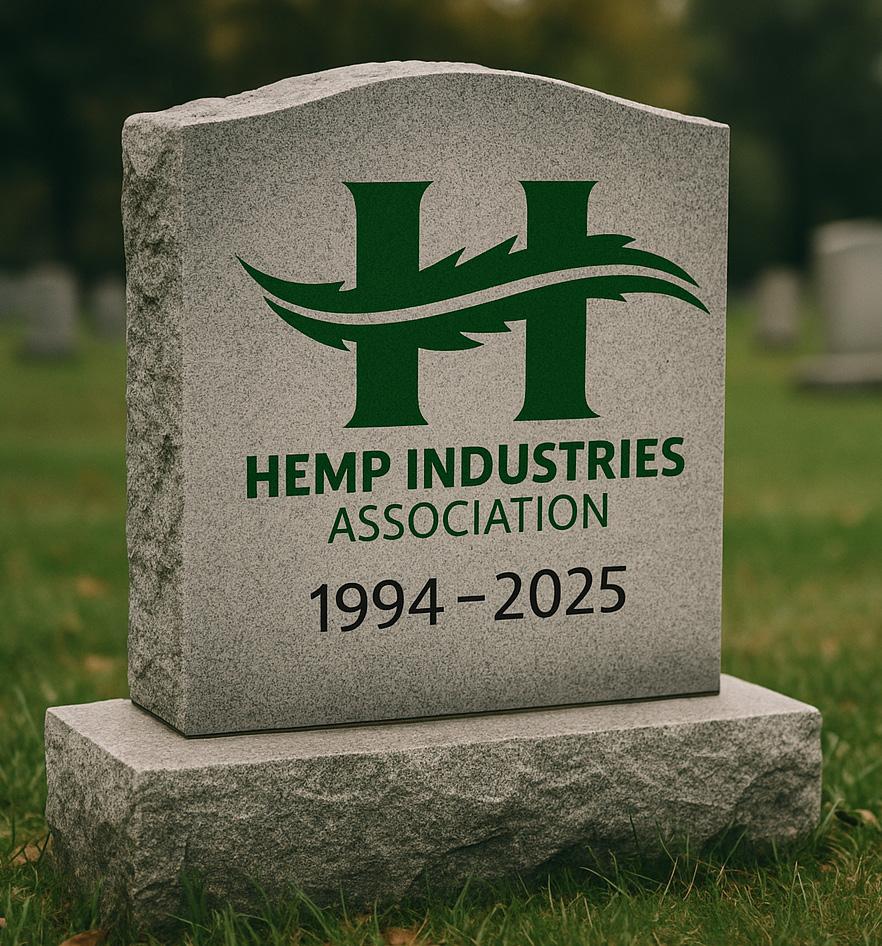
Milestones
1994: HIA founded to support the U.S. hemp industry, advocate for legalization, and develop hemp-based markets.
2001–2004: HIA sues the DEA to prevent a ban on hemp-based food products (HIA v. DEA), winning in 2004.
2008: Eric Steenstra becomes HIA Executive Director.
2013: HIA lobbies for hemp pilot programs in the U.S. Farm Bill.
2014: Farm Bill Section 7606 allows limited hemp cultivation for research; Colleen Keahey founds HIA Tennessee chapter.
2016: HIA educates on hemp-derived CBD legality, promoting industry expansion. DEA issues a notice in the Federal Register causing confusion over CBD.
January 2017: Eric Steenstra is out as HIA Executive Director, replaced by Colleen Keahey.
February 2017: HIA files a motion to hold the DEA in contempt of court for violating a 2004 order regarding hemp food products.
2018: The Farm Bill legalizes hemp federally, a long-time HIA goal.
2019–2021: HIA membership surges as the hemp industry expands.
July 2020: HIA abandons its chapter network due to financial problems. Jody McGinness is HIA executive director.
July 2020: State chapter leaders explore legal options after HIA closes them down.
September 2020: HIA simplifies its membership structure and establishes a sponsorship program amid financial recovery efforts.
July 2020: Jody McGinness appointed HIA’s executive director.
June 2021: Mike Lewis assumes the HIA presidency, replacing Rick Trojan.
January 2022: HIA elects three new board members and re-elects one. NAME THEM.
April 2022: DEA and HIA lawyers argue in court over DEA rule on THC limits during hemp processing.
June 2022: A U.S. court dismisses two appeals in cases brought by HIA against the DEA regarding jurisdiction over hemp derivatives, calling them “weak, mystifying and ridiculous.”
June 2023: Cynthia Cabrera of Hometown Hero CBD appointed Chair of HIA Cannabinoids Council.
May 2023: HIA joins other industry representatives going on-record in support of delta-8 THC and other intoxicating cannabinoids.
June 2024: Executive Director Jody McGinness departs position.
2025: Complete collapse becomes apparent.
Climate-stupid
Cancellation of Climate-Smart initiatives shuts down
For the nascent industrial hemp sector, a handful of projects funded by the U.S. Department of Agriculture was a small signal that maybe things were looking up. Six federally backed projects, representing tens of millions of dollars in promised support for climatesmart conservation and agriculture, could demonstrate hemp’s potential in regenerative farming, sustainable construction, bioplastics, and carbon sequestration.
But now, thanks to the Trump administration’s latest playbook, every one of those projects is either delayed, defunded, or dead in the water.
Yes, dead. Or, in USDA terms, “reprioritized.”
Among the possible victims: The largest-ever hemp-specific grant awarded under the USDA’s Regional Conservation Partnership Program (RCPP) – a $19.6 million initiative led by the National Hemp Association to grow climate-smart hemp across the Chesapeake Bay Watershed – has been left in limbo.
Then there’s the “Partnerships for Climate-Smart Commodities” program. As of April 13, all hemp-related projects under that umbrella were cut off. Not just canceled, but canceled with flair—framed as part of a partisan purge of “climate scams” by Agriculture Secretary Brooke Rollins, who accused the entire initiative of being “largely built to advance the green new scam at the benefit of NGOs.”
That’s not just canceling climateforward investment—it’s slandering it on the way out the door.
Strategic sabotage
Let’s be clear: these weren’t just climate pipe dreams or university science fair projects. The canceled projects included:
• A $15 million initiative to develop open-access data and digital marketplaces for climate-smart hemp production across five states.
• A $5 million plan to build out carbonnegative feedstock supply chains in Kansas, Missouri, Oklahoma, and Texas.
• A nearly $5 million collaboration led by Florida A&M to use hemp for high-efficiency carbon sequestration.
• Projects in Virginia and Tennessee exploring hemp bioplastics and greenhouse gas offsets in underserved farming communities.
A USDA press release called Climate-Smart a ‘slush fund’
key hemp projects

Ag
Collectively, these projects were designed to elevate hemp as a serious, science-backed material for 21st-century industries—from carbon-negative building materials to biodegradable packaging and even energy storage.
Now? All that funding is vapor. The USDA has agreed to honor “eligible expenses” incurred before April 13. Everything else? Good luck recouping those costs from the same administration that once used Sharpies to redraw hurricane paths.
Existential moment, again
The Trump administration is treating the entire climate-smart funding ecosystem as a partisan threat, not a public good. In fact, the USDA press release didn’t just cancel the Partnerships for ClimateSmart Commodities program—it called it a “slush fund.” Their words, not ours.
So to the dozens of hemp researchers, entrepreneurs, cooperatives, extension agents, engineers, tribal partners, and others who participated: The joke’s on you, you liberal weenie tree huggers. The federal slush fund is gone.
And the irony? Rollins insists this is all about “redirecting” money to “practi-
cal” rural energy investments. But don’t expect them to explain what those are. The administration has offered no roadmap—just vague buzzwords, deliberate ambiguity, and political point-scoring.
Stranded
Meanwhile, hemp—already ignored or marginalized by most state and federal institutions—has been left stranded. Again. The industry is scraping for infrastructure investment, operating at the edge of viability, and now must contend with the loss of what little support it had clawed its way into.
This is what political sabotage looks like: slandering evidence-based environmental programs, pulling the plug on innovation, and pretending you’re for farmers when you’re really protecting fossil fuel incumbents and culture war narratives.
The hemp industry didn’t get rich off CBD. It didn’t get the overall boost it was promised after the 2018 Farm Bill. And it certainly isn’t getting a boost now. If hemp has a future, it’s going to come from private capital, not public backing. Because with this administration, climate-smart has become climate-stupid.
Secretary Rollins: ‘Reprioritizing’
New report shows processors upbeat despite challenges
North America’s hemp fiber processing sector remains overwhelmingly optimistic despite facing significant market hurdles, according to a new report jointly released today by Canna Markets Group and HempToday.
The North American Hemp Fiber Processing Report offers one of the most detailed looks yet at the sector’s evolving landscape. Based on surveys, interviews and operational verification across the United States and Canada, the report presents a clear-eyed view of the industry’s current realities—and its path forward.
Sponsored by FIHO
The first-ever report is being published under the sponsorship of EVOLVE 2033, a strategic initiative led by the Federation of International Hemp Organizations (FIHO). As part of this effort, companies and organizations are invited to sign a formal pledge in support of a comprehensive Market Integration Strategy—a collaborative framework aimed at accelerating the integration of industrial hemp into sustainable agriculture, advanced manufacturing, and global supply chains.
While the report reflects on the sector’s internal challenges, it is also a call to action aimed at decision-makers in mainstream industries—particularly in construction, composites, textiles, and engineered materials—where hemp can offer high-performance, climate-aligned alternatives.
“Infrastructure remains the bottleneck, but that’s a solvable problem,” said Joseph Carringer, CEO of Canna Markets Group. “The opportunity is right in front of us— we just need to organize and execute.”
The report highlights demand signals from sectors such as marine manufacturing and sustainable construction, where engineered materials like Hempboard— made by Florida-based Boardwurks Biocomposites—are seeking consistent fiber supply and standardized specifications.
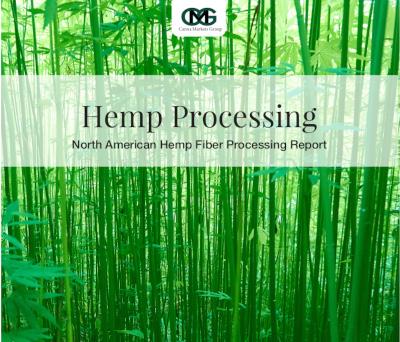

Syeda Khurram is Executive Director
New Canadian hemp agency names board, exec director
Anew agency to promote industrial hemp in Canada has appointed its first permanent board and named an executive director.
The Canadian Industrial Hemp Promotion-Research Agency (CIHPRA), established late last year, was created to coordinate initiatives across Canada’s struggling hemp industry. The new body is operating as Hemp Canada Chanvre (HCC).
The federally recognized agency will be led by Executive Director Syeda Khurram, a seasoned leader in agriculture and nonprofit governance. Will Van Roessel, owner at Specialty Seeds Ltd., Alberta, will serve as board chairman, and Reuben Stone, the founder of Uniseeds Inc., Ontario, was named vice chairman.
Getting started
Khurram brings more than 20 years of senior executive experience, including past roles as chief operating officer at the Alberta Barley and Wheat Commission. Her focus will include implementation of the HCC’s inaugural business plan, development of its governance framework, and execution of the checkoff levy strategy.
Van Roessel has grown hemp for 14 years in Alberta, while Stone has been a hemp farmer in Ontario’s Ottawa Valley since 2009.
Formally established under the Farm Products Agencies Act in November 2024, HCC is the first national agency dedicated to industrial hemp promotion and research in Canada. It was created to provide a coordinated approach to advancing the sector through marketing, research funding and global engagement.
Other board members
In addition to Van Roessel and Stone, other directors named are:
• British Columbia: Peter Düshop –Forever Green Hemp Inc.
• Manitoba: Adam Gregory – Interlake Agri Ltd.
• Quebec: Dany Lefebvre – Chanv Inc.
• Atlantic Canada: Antonio Bramante –Décision de la Nature Inc.
• Saskatchewan: Rob Ardell
• Importers: Marc van Burck – HPS Food & Ingredients
• Supply chain: Ryan Meade – Manitoba Harvest
Seeking revival
The launch of HCC comes at a time of prolonged contraction in Canadian hemp. Acreage dropped to 11,861 hectares (29,309 acres) in 2023—down from a peak of more than 44,600 hectares in 2017. Organizers hope the agency can deliver a much-needed turnaround by uniting stakeholders under a national strategy and modernizing the sector’s public image. Funded through a mandatory levy of 0.5% of industrial hemp sales revenue, HCC’s model mirrors checkoff systems used in Canada’s beef and pork industries. Processors will collect the fee to support market development, product research, and the creation of industry standards. Based on estimated market size, annual revenue could range between $875,000 and $1 million. With the full board now seated and Khurram at the helm, HCC will move forward with developing bylaws, finalizing levy orders, and initiating programming to support sustainable growth and expand Canadian hemp’s global competitiveness.

regulations Hemp in the highlands
Khyber Pakhtunkhwa takes lead as Pakistan formalizes
Pakistan’s federal cabinet has approved regulations for the Khyber Pakhtunkhwa (KP) province aimed at advancing industrial hemp and medicinal cannabis production. The rules are the first provincial guidelines ratified under the federal Cannabis Control and Regulatory Authority Act, 2024, and mark a milestone in Pakistan’s bid to build a regulated cannabis economy.
The rules empower the newly created federal agency, the Cannabis Control and Regulatory Authority (CCRA) to issue licenses, monitor compliance, and enforce restrictions across the cannabis supply chain, from cultivation and extraction to manufacturing and sales. With a THC limit set at 0.3% in line with international norms, the regulation is designed to promote safe, legal hemp-based products while aligning with global standards, according to the government.
Hemp province
Khyber Pakhtunkhwa (KP), a mountainous province in northwestern Pakistan, is emerging as a significant player in Pakistan’s developing hemp industry. While the sector is still in its early stages, several key individuals and organizations are actively involved in hemp cultivation
and research within the province. The province has taken a leading role since Pakistan first legalized industrial hemp in 2020.
Backed by the federal government, KP initiated pilot cultivation projects in 2022 and by 2023 was offering incentives to private companies to invest in processing infrastructure. Local enterprises are reportedly already exporting hemp textiles and wellness products, benefiting from the province’s favorable terrain, climate, and growing expertise in the crop.
Framework
Hemp rules in KP provide for a taxation regime aimed at boosting state revenue, preventing illicit trafficking, and fostering research and innovation. Licenses will be issued for cultivation, nurseries, processing, “CBD edibles,” medical and research use, industrial sales, transport, wholesale and retail trade, and hemp fiber manufacturing.
Licenses are valid for five years, non-transferable, and subject to regular inspections. Penalties for violations range from Rs1 million to Rs200 million ($3,600 to $720,000), and may include imprisonment.
KP’s progress reflects Pakistan’s
broader ambitions to reduce reliance on imported textiles and create a domestic value chain around hemp-derived products. The crop’s low water use, resilience to climate change, and potential in biobased industries have led some stakeholders to project $1 billion in annual market potential.
Climate drives momentum
Hemp has gained momentum in Pakistan’s textile industry partly due to extreme climate disruptions that have battered the country’s cotton sector. Hemp’s shorter growth cycle, natural antibacterial properties, and lower environmental impact have positioned it as a viable alternative for sustainable textile manufacturing and other outputs.
Agriculture is central to the Khyber Pakhtunkhwa economy, with farmers growing staple and high-value crops including wheat, maize, sugarcane, tobacco, and various fruits. Most farmers operate on a small scale using traditional practices, have limited access to modern equipment, and often suffer inadequate water supplies. Increasing pressure from climate change, ongoing conflict and underinvestment in rural infrastructure have further held back the farming sector in the region.
Kaghan Valley of Khyber Pakhtunkhwa
Osama Syed
Kazakhstan’s hemp time arrives
After legalization, country launches pilot to grow green economy
Anew era has begun for Kazakhstan’s agricultural and industrial policy, as the government officially approved the cultivation of industrial hemp and launched a pilot initiative that aims to encourage wider adoption among farmers and manufacturers.
The government said it hopes the move will stimulate rural job creation, attract sustainable industry investment, and support the country’s transition to a more diversified and environmentally responsible economy.
The pilot project is already underway in the Kostanay region, where one agricultural enterprise has begun growing and processing industrial hemp under one of four new licenses issued by the Ministry of Internal Affairs. In the Ualikhanov district of the North Kazakhstan region, a second full-cycle agro-industrial complex is in the planning stages, with negotiations ongoing to secure land for planting.
A shift in strategy
The reform comes after the Mazhilis, Kazakhstan’s lower house of parliament, approved legislative changes last month that legalized industrial hemp farming under a THC limit of 0.3% – a standard generally observed around the world. The move reflects Kazakhstan’s broader effort to eliminate unnecessary internal regulations and align its economy with global sustainability trends.
“With the right technologies and full-cycle processing, industrial hemp can power a new wave of job creation, economic diversification, and ecological resilience,” the Ministry of Agriculture said in a statement. “This crop is a renewable source of raw materials that is actively used in industry, agriculture, medicine and the food industry, contributing to sustainable development and reducing the ecological footprint.”
Authorities have emphasized that industrial hemp differs significantly from marijuana, which is native in some parts of the country. “Wild-grown cannabis in the Chüy Valley can contain more than 15% THC, while industrial hemp is limited to just 0.1% to 0.3%,” said Deputy Minister of Internal Affairs Sanzhar Adilov. “This type of crop is not of interest to recreational drug users or drug traffickers.”
By establishing a lower benchmark (0.1%) as well as an upper limit (0.3%),
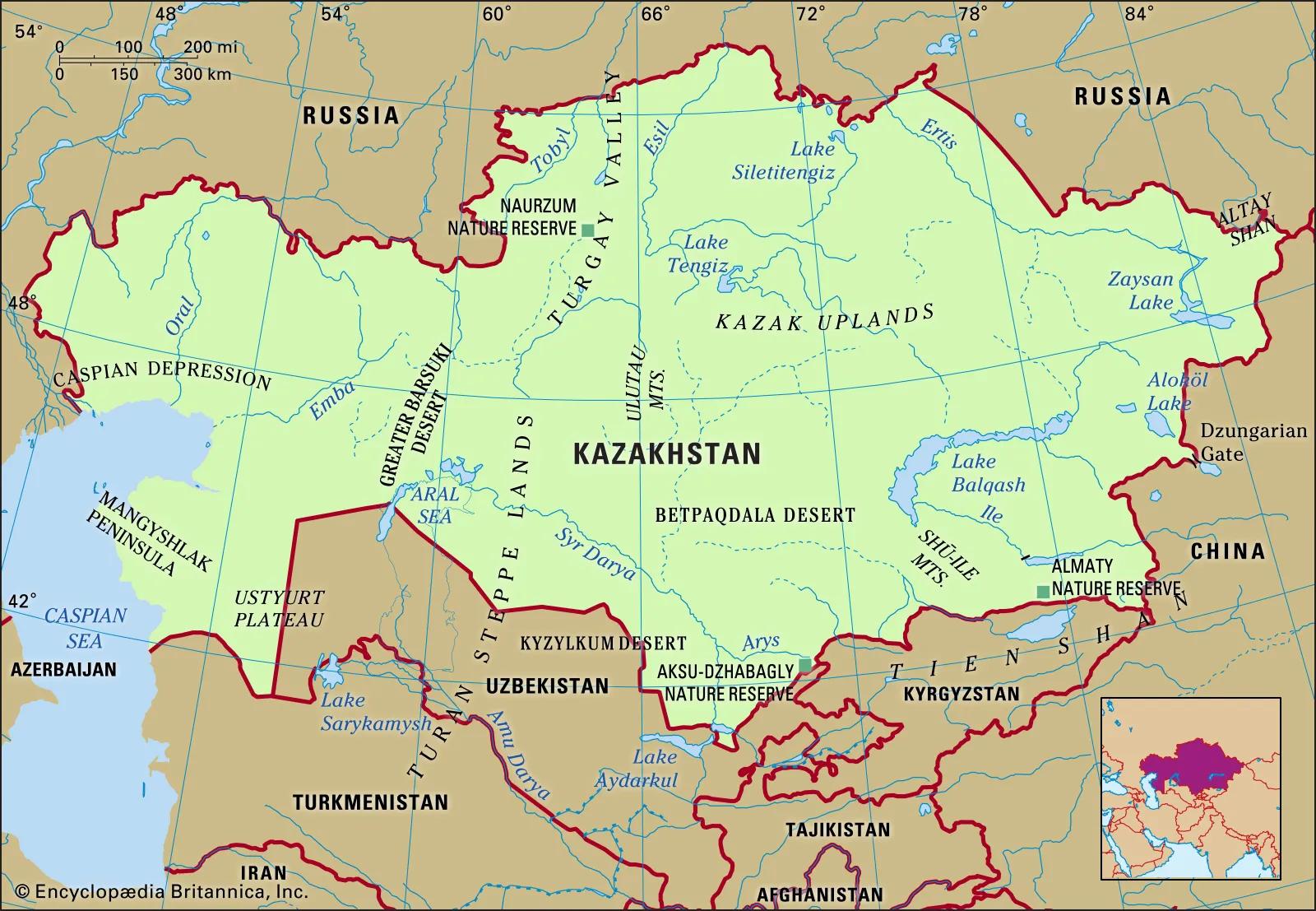
the government has created a defined chemical window that differentiates industrial hemp from both marijuana (>0.3% THC) and from crops that might not even qualify as hemp agronomically – non-viable varieties or those with essentially zero cannabinoids.
Illicit to industrial
The Chüy Valley – located in southeastern Kazakhstan’s Jambyl region – has long been known for its extensive wild cannabis fields, with estimates suggesting up to 400,000 hectares of naturally occurring cannabis plants. Likewise, the southern Kyzylorda region has been a major focus of drug enforcement efforts. Since 2014, authorities have seized over 230 tons of cannabis drugs in those two regions combined.
This background underscores the significance of Kazakhstan’s new regulatory approach. By clearly distinguishing between low-THC industrial hemp and illicit high-THC cannabis, the government is aiming not only to encourage legal cultivation, but also to redirect historical cannabis zones toward legitimate, eco-friendly industrial production. Anti-narcotics units will oversee hemp operations to ensure compliance.
Toward green industry
Kazakhstan’s legalization of industrial hemp opens the door to new economic sectors, including textiles, paper, construction, and bioplastics. The government noted that hemp is widely valued for its rapid growth, low water needs, and ability to grow pesticide-free, making it a strategic crop for regenerative farming and circular manufacturing
models.
The Ministry of Agriculture said it has identified over 500 possible product applications for hemp—from paper and textiles to insulation panels, biocomposites, and even gunpowder.
Hempcrete, a carbon-negative building material made from hemp and lime, has been highlighted as one example of hemp’s potential in the green construction sector. In the paper industry, reintroducing domestic hemp production could reduce dependence on imports, which once cost Kazakhstan over $100 million annually.
In addition to imports, the initiative also supports environmental goals and broader national strategies for rural development, and industrial innovation, according to the government.
Past efforts rekindled
Kazakhstan has a long, complicated relationship with hemp. In 2016, the National Chamber of Entrepreneurs proposed using hemp for local paper production, and test crops were planted in four regions. Though that effort faltered due to limited political will at the time, today’s push is backed by institutional support and regulatory clarity.
High-level figures have long argued for hemp’s inclusion in national biodiversity and economic development strategies. In 2018, then Vice Minister of Agriculture Yerlan Nysanbayev stated: “Hemp should be considered as one of the plants of the plant world. It cannot be considered as a negative plant. This species should be preserved as part of our ecological chain.”
That initiative was supported by then Deputy Prime Minister Dariga Nazarbayeva, daughter of former President Nursultan Nazarbayev. However, the proposal did not receive full support from the government, which resulted in its shelving.
The new legislation and pilot programs mark the first time those visions are being implemented on a coordinated, government-backed scale.
Leadership change at AHC as hemp veteran
Tim Schmidt departs
The Australian Hemp Council (AHC) has announced a change in leadership following the resignation of Tim Schmidt, a long-time industry advocate.
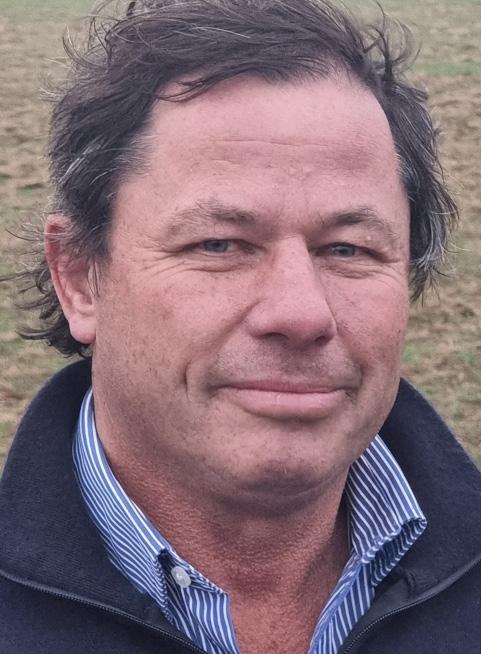
Schmidt, who led the Council through a period of significant industry development, will remain active in the sector in a supporting capacity, the AHC said. He served as president of the AHC since its formation in 2020. He submitted a letter of resignation March 29.
Matthew Lariba, Secretary of the Victorian Hemp Association and Director of Vic Hemp, was named interim president.
Meanwhile, the AHC continues to operate without participation from the Tasmanian Hemp Association (THA), which resigned its membership in December 2024 following a dispute over governance and decision-making within the Council.
Schmidt’s legacy
Established in 2020, the AHC serves as the national peak body for Australia’s hemp industry, coordinating advocacy and industry development efforts across state and territory organizations.
Under Schmidt’s leadership, the Council played a central role in unifying Australia’s fragmented hemp sector, including the achievement of a federal Senate Inquiry into industrial hemp, and fostering the creation of hemp associations across every state and territory.
During this period, national hemp cultivation more than doubled — from 1,493 hectares in 2022–23 to over 3,200 hectares in 2023–24 — while investment in the fiber industry surged.
Schmidt also steered the development of key industry resources, including a Best Management Practices Guide, an industry gap analysis, and a national research and development strategic plan aimed at guiding future investment.
Lariba’s background is in agricultural technology and environmental monitoring. He will serve until the role is permanently filled and during the AHC’s annual general meeting scheduled for later in the year as interim president while the Council prepares for its next stage of growth.
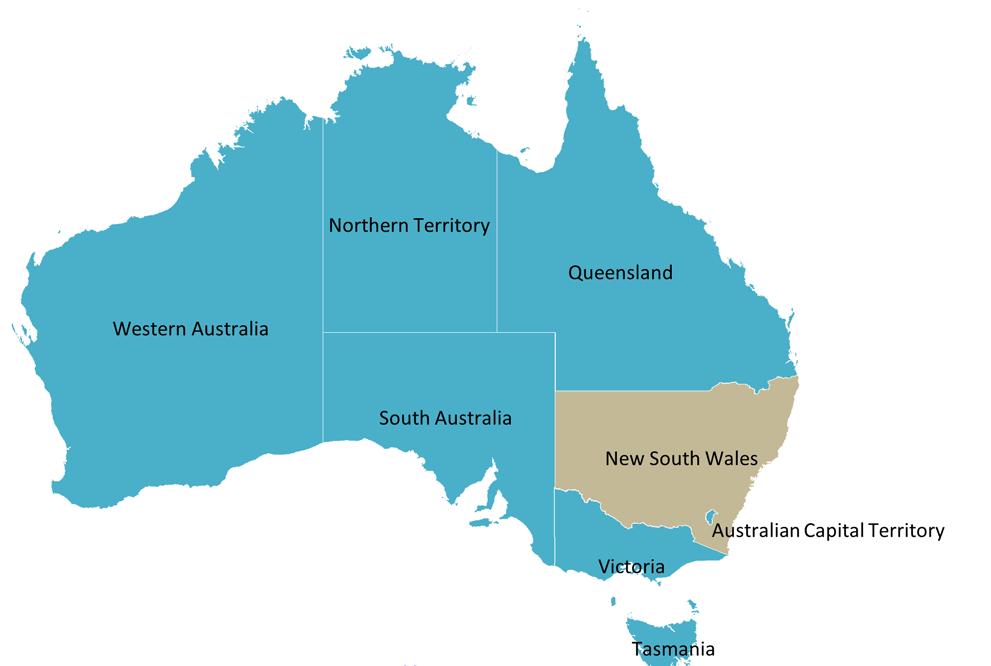
Hemp plan targets red tape as NSW eyes market expansion
The New South Wales government has released a draft Hemp Industry Development Plan to ease licensing requirements, advance research and market access, and boost supply chain development.
The initiative proposes to amend the state’s Hemp Industry Act 2008 and the Hemp Industry Regulation 2016 to make cultivation and licensing more flexible while maintaining strong public safety standards.
“The draft plan proposes an industry vision to establish hemp as a mainstream crop and sustainable source of products in NSW,” the government said in a press release. “With the global hemp market projected to grow, the proposed plan identifies where government, industry and stakeholders can concentrate efforts to capitalize on opportunities for the local hemp industry.”
The initiative, from the NSW Department of Primary Industries and Regional Development (DPIRD), aims to improve yields, advance creation of secure highvalue markets, and build market demand, particularly as Australia moves toward a low-carbon economy.
Focus on supply chain
The plan builds on the work of the NSW Hemp Industry Taskforce, established in February 2024 to explore ways to strengthen the role of industrial hemp in a net-zero, circular economy. The task force, formed after a 2023 industry roundtable, was tasked with identifying barriers and opportunities, including cut-
ting regulatory red tape and harmonizing laws nationally.
Since NSW’s Hemp Industry Act 2008 took effect, New South Wales has seen a cumulative total of just 1,800 hectares of hemp cultivated, despite more than 33,000 hectares approved for harvest in 2023-24 alone, when only 1,350 hectares were actually harvested. As of March 31, 2025, the industry had 170 licenses issued and 254 licensed facilities statewide, with 19 new licenses granted and 11 licenses renewed for an additional five years between July 1, 2024, and March 31, 2025.
Key objectives
The draft plan identifies four primary development objectives:
• Giving farmers access to hemp varieties suited to NSW production conditions, backed by best practice guidelines.
• Developing processing and valueadding infrastructure across production zones to support regional jobs.
• Building consumer awareness and confidence in hemp products through product standards and quality assurance programs.
• Creating regulations that reflect a progressive approach to hemp.
The government is inviting feedback on key aspects of the draft plan during a public consultation that closes on May 19. The final version of the plan is expected to be published by mid-2025 on the DPIRD website.
Tim Schmidt
Trust gap in Australia
Industry says unclear policy threatens growth, export goals
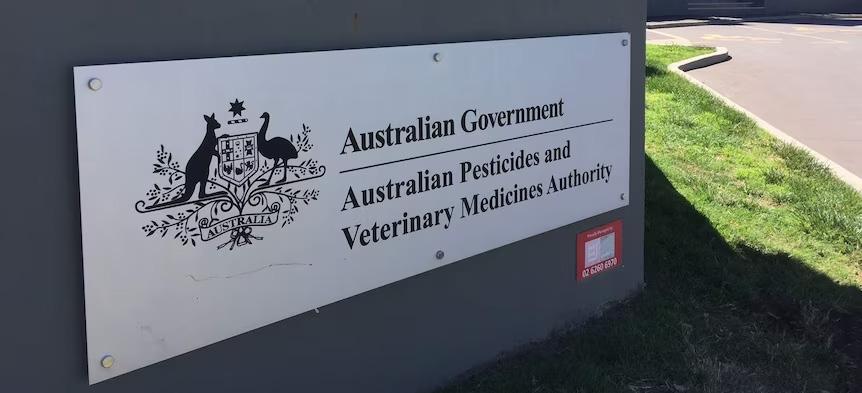
Australian hemp stakeholders have launched a formal complaint against the country’s agricultural and veterinary regulator, accusing it of inconsistent classification practices and regulatory opacity that have cost the sector millions and chilled business development.
In a letter to Scott Hansen, chief executive of the Australian Pesticides and Veterinary Medicines Authority (APVMA), the Australian Industrial Hemp Alliance (AIHA) urged the agency to clarify its position on hemp-based nutritional products for animals, which are currently treated as veterinary chemical products requiring full registration. That classification, the AIHA argues, is not only burdensome but potentially unlawful.
At the heart of the dispute are 13 Freedom of Information (FOI) documents obtained by Queensland-based Decide Pty, parent company of HempPet, a maker of natural health aids for pets. The documents, according to the AIHA, reveal “inconsistencies in regulatory practices” and a lack of transparency from the APVMA, which the alliance contends has negatively impacted the broader hemp sector.
Millions lost?
According to the letter, the APVMA’s current regulatory stance has triggered enforcement crackdowns, forced business decisions under threat of compliance actions, and created an environment where operators face continual uncertainty.
“The current situation stifles innovation, disrupts planning, and erodes trust,” said AIHA President Charles Kovess.
The AIHA also said the absence of clear guidelines has stymied investment, limited research and development, and undermined potential export growth. “Hemp farming offers significant export potential, yet regulatory challenges have constrained farmers, leading to economic stagnation in rural areas,” the letter stated.
Among the FOI revelations cited by the AIHA is a previously undisclosed decision by the APVMA to suspend enforcement actions as of Nov. 28, 2024, pending a “final determination” on hemp classification. However, that suspension was never communicated to businesses, leaving operators to assume they remained under threat.
The letter also points to what AIHA calls “discrepancies” in how similar hemp-based products have been treated, raising concerns about whether the agency is complying with its obligations under the Agricultural and Veterinary Chemicals Code Act 1994. Under Section 5 of that law, nutritional products may be eligible for exemption from registration under the Excluded Nutritional or Digestive (END) criteria.
“We believe hemp-based products meeting these standards should be exempt from registration,”
Kovess wrote, noting that APVMA’s classifications appear to conflict with the statutory END provisions.
Industry ultimatum
The AIHA has requested a formal response from the APVMA within 30 days. The group is calling on the agency to:
Clarify its enforcement policy.
Provide a timeline for the final determination on hemp product classification.
Explain how classification decisions align with the END exemption.
Commit to consistent treatment for all businesses in the hemp sector.
The AIHA emphasized its willingness to collaborate with the APVMA to develop a “clear, evidence-based framework” that supports innovation while ensuring regulatory compliance.
“Trust in the APVMA’s decision-making is eroding,” the alliance said. “The sector needs clear, science-based policies—not shifting goalposts.”
A new deal for hemp in NZ?
Long-awaited review could could be key to unleashing the industry
After years of regulatory hurdles and slow government action,
New Zealand’s industrial hemp sector is hopeful that long-awaited reforms could finally unlock the industry’s full economic potential. The announcement of a regulatory review by Minister for Regulation David Seymour signals a possible shift in the government’s approach to industrial hemp, a crop that has long been entangled in outdated legal restrictions.
The review, which aims to reassess regulations that classify industrial hemp as a Class C controlled drug under the Misuse of Drugs Act, marks a significant victory for hemp advocates.
“There’s a lot of interest in the industry and if we can capture that interest and really move forward and engage with our regions where the economic opportunities, employment and investment potential will be realized, then we’ve got a winning formula to revitalize rural New Zealand,” said Richard Barge chairman of the New Zealand Hemp Industries Association (NZHIA).
Unnecessary restrictions
Barge and others in the industry have argued that these restrictions are unnecessary given hemp’s minimal THC content and its broad applications in health, wellness, textiles, construction, and food.
The Cabinet review presents an opportunity to modernize New Zealand’s hemp regulations and align them with international best practices. Stakeholders advocate for removing hemp from the prohibited plant list, defining THC and CBD thresholds for various products, and creating a structured pathway for exports. They also emphasize the need for regional processing hubs to maximize value-added opportunities and support rural economies.
Minister for Regulation David Seymour said over-regulation had stifled economic growth and innovation within the sector, and it was time for a new approach that balanced risk management with unlocking opportunities for growers.
“The Ministry for Regulation has received extensive feedback on the red tape hindering the industry, both through its review into Agricultural and Horticultural Products and the red tape tipline,” Seymour said. “In response, the Ministry
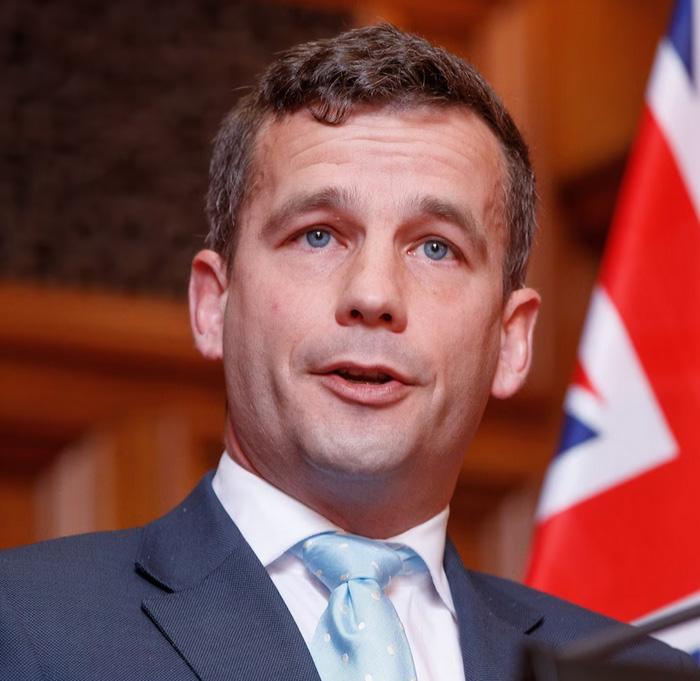
NZ
Minister for Regulation David Seymour
is working with MedSafe and the Ministry of Health to reassess these nearly twenty-year-old regulations,” which he called “outdated and burdensome.”
Unlocking economic potential
For years, hemp stakeholders have pushed for regulatory changes that would allow New Zealand to tap into the booming global hemp market. The NZHIA projects that, with the right regulatory environment, the industry could generate $2 billion annually and create 20,000 jobs by 2030. However, strict licensing requirements and classification under narcotics laws have stifled the sector’s growth, discouraging investment and innovation.
New Zealand’s current regulatory framework presents several challenges. Hemp-derived food products have been legal since 2017, but the lack of approval for hemp animal feed limits market development. Regulatory barriers also complicate access to international markets, putting local producers at a competitive disadvantage. In contrast,
countries such as Australia, the United States, and members of the European Union have adopted more progressive policies, allowing broader commercialization of non-intoxicating hemp products.
Path forward
Despite the positive momentum surrounding the review, industry leaders remain frustrated by the slow pace of reform. The NZHIA first outlined the necessary changes in a 2020 report, but meaningful progress has been elusive. The industry’s concerns were reiterated last week before the Primary Production Select Committee, where Barge stressed that hemp should be treated as a standard agricultural crop rather than a controlled substance.
While the regulatory review represents a step in the right direction, its success will depend on the government’s willingness to enact meaningful reforms. As Barge put it, “The industry is ready to go. We just need the government to remove unwarranted barriers and let us compete on the global stage.”
Take the EVOLVE 2023 PLEDGE
EVOLVE 2033 is your invitation and opportunity to play a practical and important part for a cleaner, greener future and to provide a platform for industry leaders to establish their companies as great corporate citizens, to participate with local farmers and businesses to add a new crop to the rotation and reinvigorate a new era of farm-based economic development.

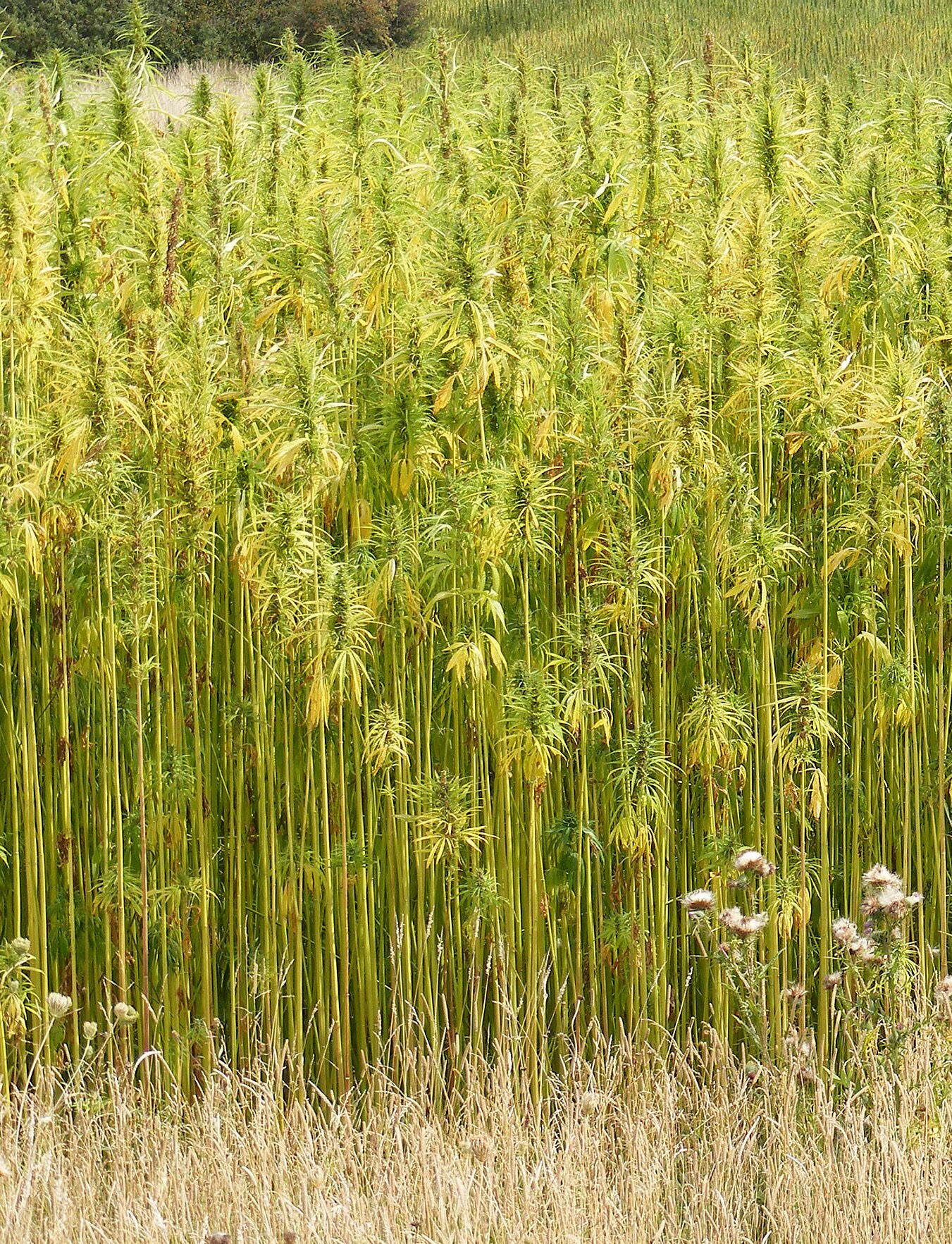





Europe
The chemistry of hemp blocks
Study shows how compaction direction affects performance
The way you press hemp hurd into blocks can make a big difference in how well they insulate and hold up under stress.
That’s the key takeaway from a new peer-reviewed study published in the Journal of Natural Fibers. Researchers in Poland and Latvia found that compacting hemp-magnesium composites in line with the direction of heat flow improves insulation by up to 25%. When pressed in the opposite direction, the blocks were mechanically stronger. That suggests simply changing the direction of compaction could help manufacturers tailor products for better insulation or greater strength—without changing the materials.
The research was led by Przemysław Brzyski and Jakub Wankiewicz of Lublin University of Technology, Poland, together with Līga Puzule, Māris Šinka, and Diāna Bajāre of Riga Technical University, Latvia. The Journal of Natural Fibers is published by Taylor & Francis, a UK-based academic publisher based in Oxford.
What they tested
The team made blocks using hemp hurd and a binder made from magnesium oxide and magnesium chloride. They tested different mix ratios and pressed the samples in two directions to see how it affected thermal conductivity, compressive strength, water absorption, and capillarity.
In traditional hemp-lime construction, the most commonly used binder mixed with hemp hurd is hydrated lime, prized for its breathability. However, to accelerate curing, improve mechanical strength, or adapt to different climates, other substances are often added—most notably Portland cement, gypsum, fly ash, or pozzolans.
These additives can enhance early strength or modify workability but often compromise the environmental benefits that make hempcrete attractive in the first place. The new study distinguishes itself by using only a magnesium-based binder, aiming to deliver strength and performance without relying on these conventional additives.
The researchers also found that the strongest blocks had compressive strength up to 1.73 MPa—similar to lightweight concrete. Thermal conductivity reached as low as 0.07 W/m·K in
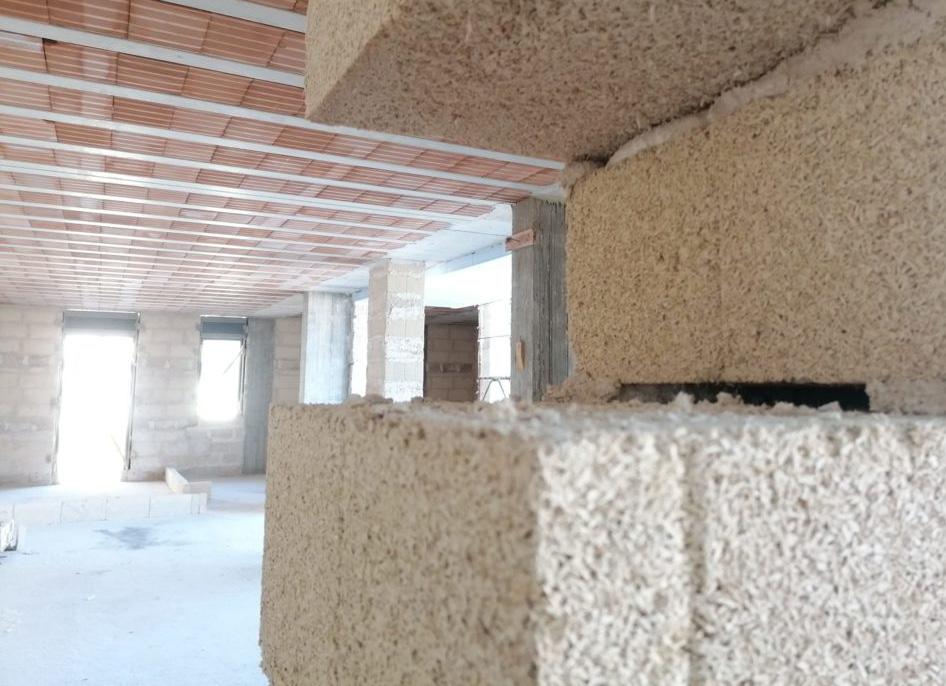
lighter mixes.
The research from the University of Žilina adds to this conversation by demonstrating that blocks made from hemp hurd and a magnesium-based binder can achieve compressive strengths over 3 MPa, meeting or exceeding the performance of some lightweight concrete materials.
Beyond insulation
While not yet suitable for high-load structural elements, the results suggest that hemp-magnesium composites could serve as self-supporting walls or structural masonry in specific applications, especially where thermal performance and sustainability are also valued. As binder chemistry evolves and testing protocols mature, these findings point to hemp’s potential beyond insulation— into the realm of structural design.
Most conventional hemp construction is based on hemp-lime or hempcrete used as infill within timber or steel structural frames. This approach prioritizes insulation, breathability, and carbon performance over compressive strength. However, recent years have seen growing interest in developing load-bearing hemp-based blocks that can simplify construction and broaden use cases— particularly in modular, prefabricated, or
low-rise applications.
A life cycle assessment (LCA) in the new report showed that most of the environmental impact came from the magnesium binder, especially magnesium chloride.
Low-impact, renewable
Beyond carbon footprint alone, the study’s environmental assessment highlights important considerations for material sourcing and circularity. While the magnesium chloride component carries the highest environmental burden, its impact is largely tied to how it is produced. If sourced from industrial byproducts or desalination waste streams, as some manufacturers have explored, the binder’s footprint drops dramatically— positioning the composite as a low-impact, renewable alternative that could be competitive with conventional insulation like mineral wool.
This flexibility in input sourcing gives hemp-magnesium materials a potential advantage in future green building certification schemes, where life cycle emissions, resource efficiency, and supply chain transparency are under increasing scrutiny. By decoupling binder performance from virgin material extraction, the study hints at a path toward truly circular bio-based construction systems.

Stronger. Lighter. Carbon-smart.
HEMPBOARD is an innovative, sustainable solution and eco-friendly alternative to traditional fiberboard or MDF.
HEMPBOARD® provides an innovative, sustainable solution and ecofriendly alternative to traditional fiberoboard or MDF. Crafted from premium Natural Industrial Hemp Plant Fibers in the Americas, HEMPBOARD® combines superior strength and durability with a reduced environmental impact. Suitable for most building, construction or architectual applications, HEMPBOARD® has diverse prouct applications and uses.
HEMPBOARD® provides an innovative, sustainable solution and ecofriendly alternative to traditional fiberoboard or MDF. Crafted from premium Natural Industrial Hemp Plant Fibers in the Americas, HEMPBOARD® combines superior strength and durability with a reduced environmental impact. Suitable for most building, construction or architectual applications, HEMPBOARD® has diverse prouct applications and uses.
KEY FEATURES
KEY FEATURES
Crafted from premium Natural Industrial Hemp Plant Fibers in the Americas, HEMPBOARD combines superior strength and durability with a reduced environmental impact. Suitable for most building, construction or architectural applications, HEMPBOARD has diverse product applications and uses.
Natural Fiber 100% Biodegradable
Natural Fiber 100% Biodegradable

Carbon Smart Building Material
KEY FEATURES
Carbon Smart Building Material
Engineered panel made from the fiber of industrial hemp plant
* Natural Fiber, 100% Biodegradable
* Engineered panel made from the fiber of industrial hemp plant
Commonly used in place of wood particleboard or MDF
Engineered panel made from the fiber of industrial hemp plant
* Commonly used in place of wood particleboard or MDF
Commonly used in place of wood particleboard or MDF
* Works with standard fasteners & connectors – staples, nails & screws
Appropriate for standard fasteners & connectors - staples, nails & screws
Boards can be left raw, sealed, or painted for indoor uses
Appropriate for standard fasteners & connectors - staples, nails & screws
* Boards can be left raw, sealed, or painted for indoor uses
Boards can be left raw, sealed, or painted for indoor uses
* Resin contains NO FORMALDEHYDE
Resin contains NO FORMALDEHYDE and removes associated concerns
* 95%+ Industrial Hemp content makes ideal Carbon Sink
95%+ Industrial Hemp content makes ideal Carbon Sink
* Mechanically produced
Resin contains NO FORMALDEHYDE and removes associated concerns 95%+ Industrial Hemp content makes ideal Carbon Sink
Mechanically Produced
Mechanically Produced
Made in the Americas. Proudly grown and manufactured in the Americas, Boardwurks supports local economies and reduces carbon emissions associated with transportation.
MADE IN THE AMERICAS Proudly grown and manufactured in the Americas, Boardwurks supports local economies and reduces carbon emissions associated with transportation.
Made in the Americas. Proudly grown and manufactured in the Americas, Boardwurks supports local economies and reduces carbon emissions associated with transportation.
SPECIFICATIONS

Boardwurks.com
Miles Gathright: (386) 576-3800
Jean-Sebastien Gros: (904) 687-7240
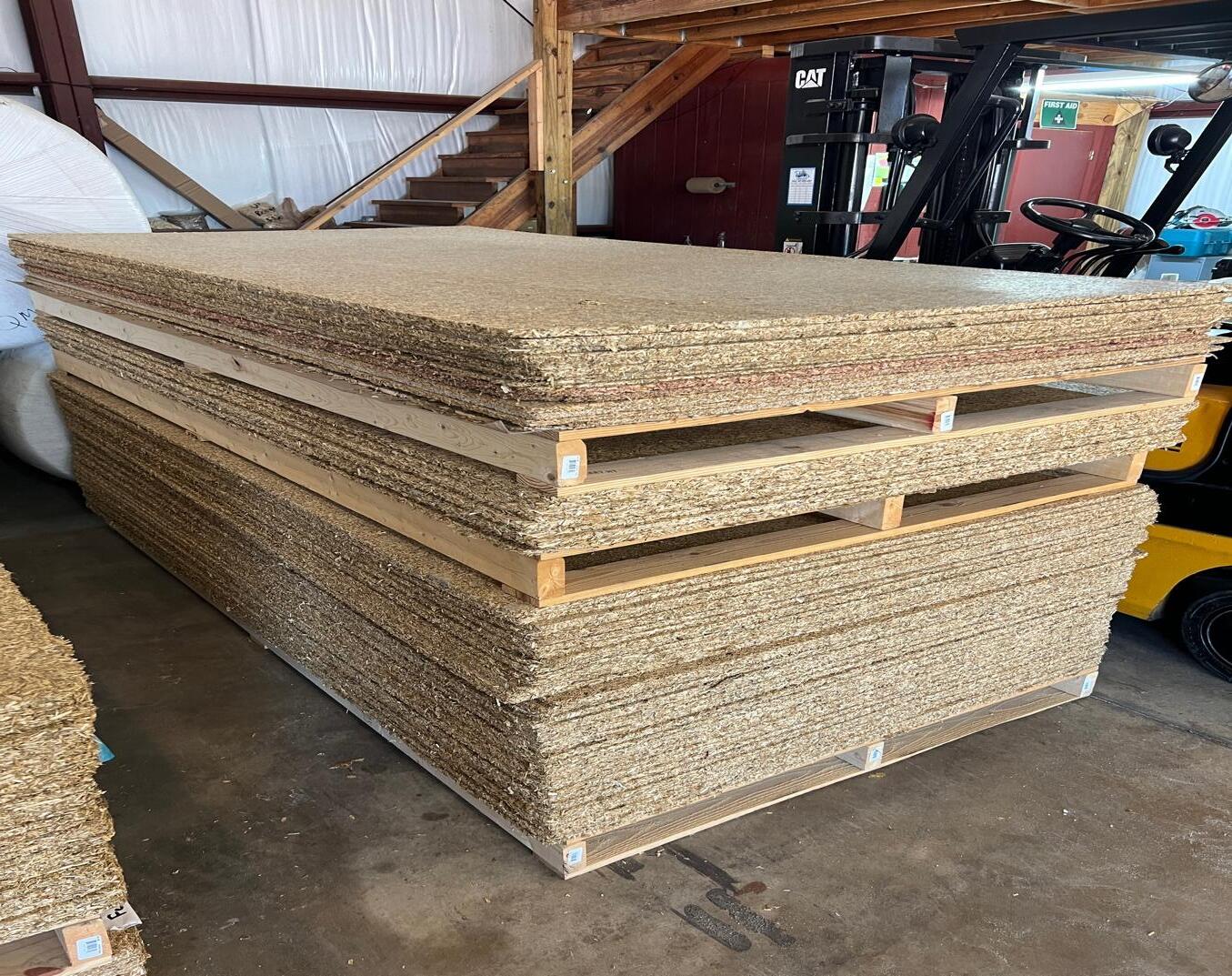
Latin America

Seeds of renewal
Patagonia marks milestone with region’s first hemp harvest
Argentina’s Patagonia region has marked a milestone with the region’s first modern-era experimental hemp harvest. Officials say the event signals a potential economic and environmental transformation for the southern tip of the country.
Hemp stakeholders say growing global demand and supportive regulatory frameworks emerging across Argentina offer the opportunity to position the region as a leader in the national hemp industry.
“This crop could become a cornerstone of our local economy,” said María Emilia Soria, mayor of the city of General Roca. “We’re supporting Fundación Gen and local producers in this effort because hemp is a strategic bet for diversifying our productive matrix.”
A local nonprofit, Fundación Gen has taken a leading role in advancing hemp agriculture in Patagonia, working closely with public institutions, municipal governments, and private partners to establish supply chains and generate regionally adapted seed stock.
The foundation cultivated, harvested and processed hemp plants at two experimental plots. The harvested material was processed at a foundation facility, using a combination of NGO-owned and municipally provided machinery to separate seeds and to decorticate the stalks. The seeds will be
used for oil and derivatives, while the stalks are destined for eco-friendly construction materials, according to the foundation.
Unique experiments
The hemp plots are located in Mari Menuco in the Province of Neuquén, and General Roca in the province of Río Negro, each with unique characteristics that signal Patagonia’s potential for agricultural diversification.
Neuquén, is better known for its man-made reservoir and proximity to Argentina’s oil and gas infrastructure than for any form of farming. The semi-arid terrain, wide open spaces, and sparse population have traditionally lent themselves more to energy development than agriculture. Government and private stakeholders see Mari Menuco as a testbed for unconventional crops like industrial hemp – part of a broader push to convert underutilized land into sustainable, revenue-generating assets.
In contrast, General Roca, located in the fertile Upper Valley of the Río Negro River, is one of northern Patagonia’s primary agricultural and urban hubs. Long renowned for its apple and pear orchards, the region benefits from a well-established irrigation system and agrotechnical know-how. It also serves as a growing
center for research and innovation in sustainable farming. The foundation said the area is ideal to trial hemp cultivation in conditions more closely aligned with traditional agriculture that can leverage the area’s infrastructure, labor pool, and local government support.
Historical roots
Industrial hemp has deep roots in Argentine history: in 1797, national independence leader Manuel Belgrano drafted a hemp cultivation and processing plan, though the initiative never gained traction under Spanish colonial rule. Nonetheless, hemp crops were grown continuously in Argentina until the global war on drugs interrupted the industry in the 1970s. Much like in the United States, the Argentine government urged farmers to plant hemp in the 1930s in the national interest.
The harvest celebration this week brought together representatives from government, academia, and private industry, including representatives from the municipality of Ramos Mexía, the Federation of Business Entities of Río Negro, and several academic and technical institutions, including the National University of Río Negro and the National Institute of Industrial Technology.

Hemp book launch highlights fashion’s shift toward sustainability Brazil’s fashion revolution
ABrazil-based activist group said it has launched a book about hemp as a sustainable raw material for the textile industry.
Fashion Revolution Brazil (FRB) wintroduced “Cânhamo é Revolução” (Hemp is Revolution) during FebraTêxtil 2025, a major trade show that brings together major brands in fashion and textile design.The new book explores the versatility and ecological benefits of hemp, suggesting it is underutilized in Brazil despite its promise as an eco-friendly alternative in fabric production.
The book reflects a growing interest in innovative materials within the Brazilian textile industry, where hemp is increasingly seen as a viable option due to its durability and reduced environmental impact.
Problems with cotton
Brazil’s textile sector plays a crucial role in the country’s economy, generating more than $40 billion annually from 22,500 production units nationwide. About 1.3 million people hold formal jobs in the textile industry, with about 75% of those positions occupied by women.
Brazil is one of the world’s fastest-
growing cotton producers over the last 25 years, and one of the leading global exporters of raw cotton. But cotton has been controversial due to concerns over the environmental impact of cotton farming, particularly in relation to deforestation in the Cerrado region in the central part of the country, an area considered crucial for the country’s ecosystem.
Investigations have linked cotton production to illegal land-grabbing, with brands like H&M and Zara found to source cotton from areas associated with deforestation. The expansion of cotton fields has been identified as a key driver of environmental degradation.
Turning point
“We are at a turning point where sustainability is no longer optional but a necessity,” said Eduarda Bastian a researcher specializing in materials, fibers, and sustainability in fashion. “Hemp offers an incredible opportunity to innovate responsibly.”
Bastain and Fernanda Simon, the executive director of Fashion Revolution Brazil will discuss innovation with hemp, and hemp’s potential in sustainability
during a session at the FebraTêxtil event.
Global movement
Fashion Revolution is a global movement founded in 2013 following the Rana Plaza disaster in Bangladesh, where the collapse of a building housing major clothing factories resulted in over 1,100 deaths. The organization seeks to raise awareness about the socio-environmental impacts of fashion and advocate for fairer, more sustainable practices.
The Brazil chapter has been active since 2014, mobilizing activists, academics, and industry professionals through campaigns, events, and projects aimed at transforming the fashion sector. By encouraging transparency and accountability, the movement challenges both consumers and brands to rethink the industry’s impact on people and the planet. The group’s’s focus on hemp reflects a broader shift within the textile industry toward promoting sustainable innovation.
“We are committed to showing the industry these initiatives, which seek to meet market demands while preserving the environment,” Hélvio Pompeo Jr., of show organizer Febratex Group.
More stalling in Brazil
Health agency pulls proposal ahead of deadline for rules
In a sudden and unexplained move, Brazil’s health agency in mid-May suspended the process to regulate the cultivation of industrial hemp, ignoring a deadline set by the country’s highest court.
The National Health Surveillance Agency (Anvisa) on removed from its agenda a long-anticipated proposal to regulate the planting and processing of hemp varieties with less than 0.3% THC for medicinal and pharmaceutical purposes only. This comes despite a May 19 deadline imposed by the Superior Court of Justice (STJ), which last year ordered the federal government to implement the rules.
The decision left stakeholders stunned and created fresh uncertainty around Brazil stakeholders’ attempt to establish a hemp sector just days before the legal clock runs out.
Sudden suspension
The hemp regulation item was pulled during Anvisa’s May 14 public meeting, during which Director Daniel Pereira cited a vague “need for alignment” as the reason for the withdrawal. The item had been scheduled for formal discussion, but the session instead proceeded with routine votes on unrelated technical matters.
So far, neither Anvisa nor the Ministry of Agriculture (MAPA) has issued a public explanation. The silence is fueling speculation about whether the government intends to comply with the court’s order or seek a new extension. Sources told El Planteo that MAPA may soon release a strict resolution permitting hemp only under controlled indoor conditions, or else request more time to develop a regulatory framework.
The suspension directly contradicts a unanimous ruling by the STJ in November 2024, which granted six months— ending May 19—for Anvisa and federal authorities to implement a regulatory pathway for industrial hemp.
‘Industrial’ potential ignored
The STJ’s ruling authorizes hemp cultivation specifically for “medicinal and pharmaceutical purposes,” a distinction that carries regulatory weight. “Pharmaceutical” refers narrowly to clinically tested, government-approved drugs— such as prescription CBD treatments manufactured under pharmaceutical

standards. “Medicinal,” by contrast, can encompass a broader range of therapeutic uses, including over-the-counter or plant-based products not classified as formal medications. While both terms relate to health, the dual framing may allow for some flexibility in product types.
The STJ’s decision, however, does not address broader agricultural or industrial uses of hemp, and the narrow healthfocused interpretation has frustrated advocates who argue that Brazil is missing a vital opportunity to foster a domestic supply chain for hemp-based materials such as textiles, building components, and bioplastics.
Regulatory odyssey
The current situation stems from a legal case brought by a biotechnology firm seeking to import and cultivate lowTHC cannabis for health and industrial uses. Although a federal court initially rejected the request, the STJ overturned that ruling, declaring that hemp does not fall under Brazil’s Narcotics Act due to its non-psychoactive profile.
Justice Regina Helena Costa, who led the opinion, emphasized the urgency of regulation to ensure access to hemp-derived health products, citing the constitutional right to health. The court’s decision obligated Anvisa to act within six months and explicitly denied a gov-
ernment request to extend the deadline to 12 months.
Market potential stymied
Despite regulatory inertia, interest in Brazil’s potential hemp economy remains high. The Ficus Institute, a domestic policy group, recently submitted a technical note urging Anvisa to authorize hemp for fiber and grain production. The document warned that limiting hemp to pharmaceutical use would hurt Brazil’s global competitiveness.
Brazil’s sheer size and growing medical cannabis market—projected to reach $185 million in 2024—make it a prime target for international CBD producers. GW Pharmaceuticals, a part of drugmaker Jazz Pharmaceuticals, which markets Epidiolex, high-concentration CBD for epilepsy, has operated in Brazil since 2019 under existing regulations. A broader framework could trigger investment in local farming, extraction, and manufacturing.
But the future is unclear. Without a formal response from Anvisa or MAPA, Brazil’s hemp debate stands at a legal and political crossroads. Observers now wait to see whether regulators will comply, stall further, or move to restrict hemp’s scope even more narrowly than originally feared.
The St. Lucia model
Draft bill aims to create legal markets for hemp, marijuana
Adraft cannabis law in St. Lucia aims to open up the markets for both marijuana and industrial hemp. The proposed legislation, recently released for public review, outlines regulations for the farming, processing, and sales of hemp products from both types of cannabis.
The proposed measure, which aims to address past injustices, support marginalized communities, and create new economic opportunities, reflects growing public support for a regulated cannabis industry based on input from advocacy groups, religious communities, and the general public.
‘A model’ cannabis bill
Emma Hippolyte, Minister for Commerce in the tiny Caribbean island nation stressed the importance of public participation in refining the Cannabis and Industrial Hemp Bill. “It is very important for us because we have worked quite a bit to try to get a model bill,” she said. The minister also underscored the role of the newly established Regulatory Steering Committee (RSC) in guiding the development of the island’s cannabis industry.
Specific provisions related to industrial hemp include:
• Regulation of cultivation: The bill outlines guidelines for the cultivation of industrial hemp, specifying licensing requirements, permissible strains, and cultivation practices to ensure compliance with safety and quality standards.
• Processing and manufacturing: Provisions are included for the processing of hemp into various products, establishing standards for facilities, equipment, and procedures to maintain product integrity and consumer safety.
• Commercialization and sales: The legislation details the framework for the sale and distribution of hemp products, including labeling requirements, permissible product types, and restrictions to prevent misuse.
• Research and development: The bill encourages research into industrial hemp applications, supporting innovation and the development of new products and markets.
Aron Alexander, president of the Iyanola Council for the Advancement of Rastafari (ICAR), hailed the progress as a significant milestone.
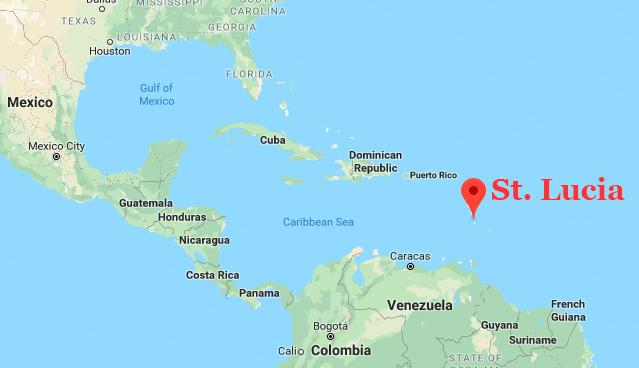
With a population of about 140,000, St. Lucia spans 238 sq m (616 sq km).
‘We’ve been brutalized’
“It took us 50 years to get here – 50 years of advocacy, protests, and keeping the pressure on politicians to address cannabis decriminalization and legalization,” the Rastafari leader told the St. Lucia Times. “We’ve been brutalized, jailed, murdered, and our livelihoods destroyed because of prohibition. While we don’t seek to benefit disproportionately, we must be key stakeholders in this new regime.”
ICAR’s advocacy led to an agreement with the government to establish a Rastafari Development Fund, supported by a percentage of cannabis-related tax revenue. Alexander emphasized the need for strong representation on the board managing the fund to ensure its impact on the Rastafari community.
Softening on drug laws
Historically, St. Lucia enforced strict penalties for cannabis-related offenses under the Dangerous Drugs Act. Possession, even in small amounts, could result in heavy fines and imprisonment, while cultivation and trafficking carried even harsher penalties, including long jail terms and significant financial fines.
These laws disproportionately impacted marginalized groups, particularly the Rastafarian community, whose religious and cultural practices include the use of cannabis. Young offenders also faced lasting consequences, such as criminal
records that hindered employment and travel opportunities. These enforcement practices contributed to prison overcrowding and fueled public criticism.
In recent years, St. Lucia has shifted its approach toward cannabis reform, recognizing the social and economic costs of these harsh penalties. Public sentiment, advocacy from affected communities, and global trends have influenced the government to pursue more lenient policies, such as decriminalization of small amounts of cannabis and, soon, the development of a regulated cannabis and hemp industry.
Farming sector challenged
Despite facing challenges in recent years, the island’s agricultural sector plays a crucial role in its economy, with around 18% of the land dedicated to farming. Farming practices are largely based on small-scale operations, with many farms under five acres supporting subsistence needs and commercial activities. Efforts are ongoing to promote sustainable farming practices and explore new markets for St. Lucia’s agricultural products.
The island’s farming landscape is diverse, with key crops including bananas, coconuts and cocoa beans. But the agricultural sector has faced challenges such as reduced competitiveness in the banana market and a need for diversification.
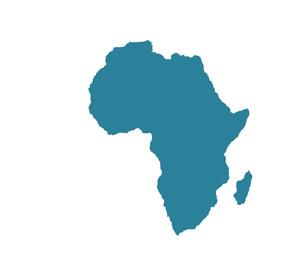
Return to sanity
South Africa recommits to pro-hemp policy after backlash to ban
South Africa’s hemp food sector has regained stability after a sudden and controversial regulatory change was swiftly overturned by the government.
On March 26, the South African government rescinded new regulations that would have imposed a blanket ban on food products containing any cannabisderived ingredients, including hemp seed oil and hempseed flour.
The rules, initially introduced by Health Minister Aaron Motsoaledi earlier in the month, were met with fierce opposition from stakeholders who argued that they contradicted President Cyril Ramaphosa’s pro-hemp stance and South Africa’s broader economic development goals.
In a statement, the government reaffirmed its commitment to hemp industry growth while ensuring public health concerns were addressed.
“The Department of Health will continue to consult broadly before publishing the revised regulations,” according to the statement, which said further deliberations with industry stakeholders would take place before finalizing any rules changes.
The now-retracted regulations, published under the Foodstuffs, Cosmetics, and Disinfectants Act, would have made it illegal to sell, manufacture, or import food products containing hemp or any cannabis-derived ingredients. The specific wording of the regulations stated: “No one may sell, manufacture or import, processed or unprocessed, foodstuff containing (a) any part of the plant or component from the genus Cannabis which includes C. sativa, C. indica, and C. ruderalis, or (b) hemp seed oil or powder from any component derived from the genus Cannabis sativa L.”
Industry Uproar
The swift reversal follows weeks of outcry from hemp industry players, political opposition, and legal analysts. On March 20, the Democratic Alliance (DA), South Africa’s leading opposition party, had urged Ramaphosa to overturn the regulations, warning that they would stifle the country’s hemp industry.
“Many countries, including the US, Canada, and China, have integrated hemp into their food industries, and South Africa should do the same,” said DA health spokesperson Michéle Clark,

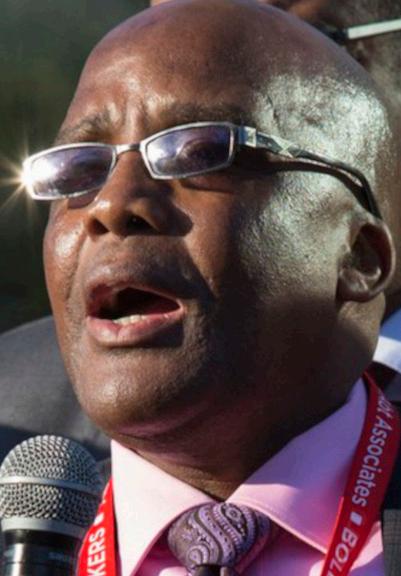
who criticized the ban as “ill-considered.” Clark further pointed out that the health minister had bypassed public consultation, a move that further fueled uncertainty in the sector.
‘Lunacy’
Brett Herron, secretary-general of the GOOD Party, described the regulations as “lunacy,” particularly given Ramaphosa’s 2022 State of the Nation address, in which he had championed hemp as a driver of job creation and economic growth. “The hemp industry is a key pillar in South Africa’s economic strategy. This ban contradicts everything the government has been working toward,” Herron said.
Akos Bio, a South African medical cannabis firm, also voiced concerns over the regulations. CEO Connor Davis criticized the ban for failing to differentiate between industrial hemp and medical cannabis. “The sector needs a rational regulatory framework with input from all relevant stakeholders,” Davis said, adding that the regulatory confusion threatened investment and job creation.
Legal experts were quick to raise alarms over the regulations, warning that they would criminalize activities that were previously legal. Attorney Shaad Vayej, chairman of Cape Town-based Openfarms, a cannabis investment
platform, called the decision “a knee-jerk regulatory overreach.”
“This drastic measure contradicts prior regulatory frameworks and undermines South Africa’s ambitions to lead in the cannabis and hemp industries,” Vayej said. He further noted that the move placed South Africa at odds with global trends, as many countries have embraced hemp-based food products for their nutritional and economic benefits.
The regulations also threatened the livelihoods of businesses and farmers who had already received government-issued hemp cultivation permits.
Presidential override
The reversal means the Department of Health will now return to the drawing board, engaging in consultations with industry representatives to establish a clear, science-based regulatory framework that distinguishes between non-psychoactive hemp products and intoxicating cannabis derivatives.
Industry players have stressed the importance of a science-based approach and predictability in regulation to attract investment and prevent unnecessary market disruptions.
For now, South Africa’s hemp industry remains on track, but the episode has highlighted the fragility of regulatory certainty in the sector.
SA President Cyril Ramaphosa; Health Minister Aaron Motsoaledi
Join these leading companies and reach 8,000+ hemp contacts

Forever
Green Innovation, Technology/BC, Canada
Vertically integrated hemp grower and processor that operates decortication equipment and supplies technology including a specialized hemp harvester.
Key Contact Peter Düshop
Email getforevergreen@gmail.com
Phone (1) 250 567-5673

Canna Markets Group
Consulting, Marketing, Textiles/USA
Hemp industry information repository, think tank that provides data, analytics, strategic planning, business planning, and project management services.
Key Contact Joseph Carringer
Email j.carringer@cannamarketsgroup.com
Phone (1) 603 321 6418


DOPE CFO Certified Advisors
Consulting/West Virginia. U.S.
DOPE CFO Certified Advisors provides rocksolid cannabis accounting and tax solutions for a wide range of businesses in the cannabis and CBD/hemp industry.
Key Contact: Erica Sloan
Email: erica.sloan@dopecfo.us
Phone: + 1.681.242.9056
Planta Medical s.r.o.
CBD, Food & Drink, Wholesale/Slovakia
Hemp extraction specialist based in Slovakia, utilizing cutting-edge TETRA technology to produce premium, full-spectrum CBD extracts.
Key Contact: Jan Babela
Email: admin@plantamedical.eu
Phone: +421917263719

Boardwurks Biocomposites
Building supplies/Florida, USA
Boardwurks Biocomposites is revolutionizing the building materials industry with our innovative lineup of high-performance natural fiber composite panels.
Key Contact: Jean-Sebastien Gros
Email: j.seb.gros@boardwurks.com
Phone: +1 904 687 7240

Bionexo S.R.L.
Consulting/Uruguay
Export of bioenergy and agricultural products including their international logistics, foreign trade, analysis and market trends.
Key Contact: Guillermo Clement
Email: guillermo.clement@bio-nexo.com.uy


Australian Hemp Council Organizations/Australia
National peak body formed in June 2020 under the Federation model. It comprises a single representative from the local industrial hemp association within each of our nation’s six states and the Northern Territory.
Email: info@australianhempcouncil.org.au

MPR Studio Creative Solutions Consulting, Marketing, Media/USA
We provide WordPress web development, site maintenance and graphic design for businesses of all sizes in the hemp industry.
Key Contact: Marshall Reyher Email: mreyher@mprstudio.com

HurdMaster Technology, Construction/Latvia
A compact, durable micro-decorticator designed to separate hemp stalks’ woody core (hurd) from bast fibers.
Key Contact: Kristaps Eglitis
Email: kristap@inbox.lv Phone: +371 28 680 139

Shah Hemp Inno-Ventures
Construction, Food, Health & Beauty/Nepal
SHIV focuses on using the hemp plant to produce basic necessities for living like food, clothing, housing, body-care products, bio-fuels, etc. SHIV started its operation with hempcrete construction.
Key Contact: Dhiraj Shah
Email: info@shahhempinnoventures.com Phone: +977 980 331 9991

Toasty
Hemp Co. Textiles & Fashion/USA
Toasty Hemp Co. delivers high-quality, affordable hemp clothing designed for everyone.
Key Contact: Ryan Zaczynski Email: ryan@maisontiet.com

HHH Harvesting Technology Technology/Germany
Our mission is to bring affordable, dependable solutions to stakeholders requiring hemp harvesting and processing technology.
Key Contact: Heinrich Wieker
Email: henry@henryshempharvester.de
We create waves of change.

At Green Wave, we create waves of change through environmental awareness and action. We support sustainable, regenerative, and holistic solutions for an ecologically harmonious future. Join us in fostering creative campaigns and collaborations that promote environmental stewardship and community engagement.

